








ecause July and August are hot months, outdoor activities are best done in early morning and just before dark. But if you sweat, don't worry, because sweating is good for you! You can still have good times outdoors, but you just have to plan better when it’s 100 degrees in the shade.

In my younger days, I spent time in the hot summer cutting firewood on a deer lease in Brown County. The fireplace in Austin was a cozy place in winter, and I was glad to have a place to get oak wood. July and August are also good months to fix up the deer blinds and cut brush for shooting lanes. Of course, you can go to Hawaii or Bermuda, if you have the money. “Bidenomics” is taking most of mine. Oil keeps going up. It’s over $80 a barrel, and climbing as I write this. With gas over $3 a gallon, I’m reminded of the old phrase during the big war—“Is this trip necessary?” It’s interesting that regular gas is cheapest south of I-10, and east of the Pecos. It appears gas prices follow the economy index, which is higher north of I-10 and I-20. Be that as it may, gas is always something to consider on a hunting trip. I used to drive 100 miles to hunt doves, but such trips are not economical these days. Such a trip today would cost $45 just for gas.
August will be a big month for Hunters Extravaganzas, and we hope to see everyone at one of the shows in Houston, Aug. 2-4; Fort Worth, Aug. 9-11; or San Antonio, Aug.16-18. Each show has something for everyone, so mark your calendar. The cool shows are a good place to be in August to meet old friends and find out from the vendors what’s new for hunting and the outdoors.
When you celebrate July 4, think about the time lapse since we declared independence from Great Britain 248 years, or about 13 generations ago. We can thank Henry VIII and his Church of England, and the rebellious taxes on everything from paint to wool by King George III, known as the “Mad King.” Religion and taxes were the two major components that drove Puritans to the New World, and we should all be thankful for that.
Dove season is just around the corner, so now is a good time to start thinking of a good place for opening day, and renew any old acquaintances that might get you a good hunt. Clean up “Old Betsy,” or whatever you call your favorite shotgun, and look for a good buy on shells. Dove season kicks off the fall hunts, and some 300,000 doves hunters will be in the field in the North and Central zones on Sept. 1. Another 100,000 will join the dove crowd when the South Zone opens later in September.
2024 has been a good year, so far. General rains have been good enough to give us good dove and deer seasons, the two most important hunting seasons in Texas. Make room for the kids in both seasons, and you will be glad later on. And keep ’em running, swimming, and flying by being good sports, and I thank you kindly.
Founder Jerry Johnston
Publisher
Texas Trophy Hunters Association
President and Chief Executive Officer Christina Pittman • christina@ttha.com
Editor Horace Gore • editor@ttha.com
Executive Editor Deborah Keene
Associate/Online Editor Martin Malacara
North Texas Field Editor Brandon Ray
East Texas Field Editor Dr. James C. Kroll
Hill Country Field Editor Gary Roberson
South Texas Field Editor Jason Shipman
Coastal Plains Field Editor Will Leschper
Southwest Field Editor Jim Heffelfinger
Graphic Designers Faith Peña Dust Devil Publishing/Todd & Tracey Woodard
Contributing Writers Kristina Brabston, Craig Boddington, John Goodspeed, Judy Jurek, Noah Lavender, Robbie Placino, Brad Ruiz, Eric Stanosheck, David Stoddard
Sales Representative Emily Lilie 713-389-0706 emily@ttha.com
Marketing Manager Logan Hall 210-910-6344 logan@ttha.com
Membership Manager Kirby Monroe 210-809-6060 kirby@ttha.com
Advertising Production Deborah Keene 210-288-9491 deborah@ttha.com
Assistant Manager of Events Jennifer Beaman 210-640-9554 jenn@ttha.com
Administrative Assistant Courtney Carabajal 210-485-1386 courtney@ttha.com
To carry our magazine in your store, please call 210-288-9491 • deborah@ttha.com






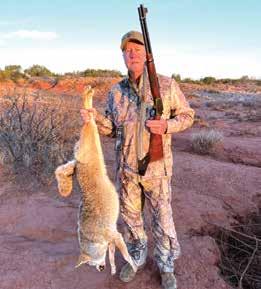



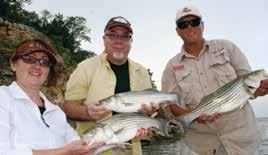



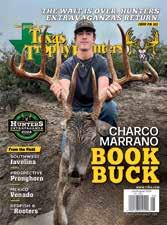
The Journal of the Texas Trophy Hunters, 1982 ISSN-08941602, is published bimonthly (a total of 6 issues) by The Texas Trophy Hunters Association Ltd. 700 E. Sonterra Blvd., Suite 1206, San Antonio, TX 78258, Phone (210) 523-8500. All rights reserved. Periodical postage paid in San Antonio, Texas, and Additional Mailing Offices. Subscriptions: $35 per year includes membership in TTHA. Phone (210) 523-8500. Advertising: For information on rates, deadlines, mechanical requirements, etc., call (210) 523-8500. Insertion of advertising in this publication is a service to the readers and no endorsement or guarantees by the publisher are expressed or implied. Published material reflects the views of individual authors and does not necessarily reflect the official position of the association. Contributions: should be sent via email to editor@ttha.com, or mailed to the Editor, Journal of the Texas Trophy Hunters, 700 E. Sonterra Blvd., Suite 1206, San Antonio, TX 78258. They must be accompanied by a self-addressed stamped envelope or return postage, and the publisher assumes no responsibility for loss or damage to unsolicited materials. Any material accepted is subject to revision as is necessary in our

Deer hunters bringing their trophy heads to the 2024 Annual Deer Competition at Houston, Fort Worth, and San Antonio will see new scoring system changes for the popular Extravaganza buck contest. All three deer contests will feature both Boone and Crockett (net) scores, and SCI gross scores. All deer will be scored using the Trophy Scan system, with matching score sheets for each deer.
SCI will conduct the contests, using all of the original TTHA methods of accepting deer heads, scoring, exhibit-
ing, and presentation of winners and prizes on Sunday evening at 4 p.m. Rules for entering the contests will be unchanged, only the methods of scoring, which use a new scanning technique.
We urge contestants to bring their 2023-24 harvested bucks, or best-in5-years trophies. Texas, Mexico, and out-of-state harvested white-tailed deer will be accepted from TTHA members, along with Texas mule deer. It’s a fun time for all, so bring your buck and enter!
—Horace Gore






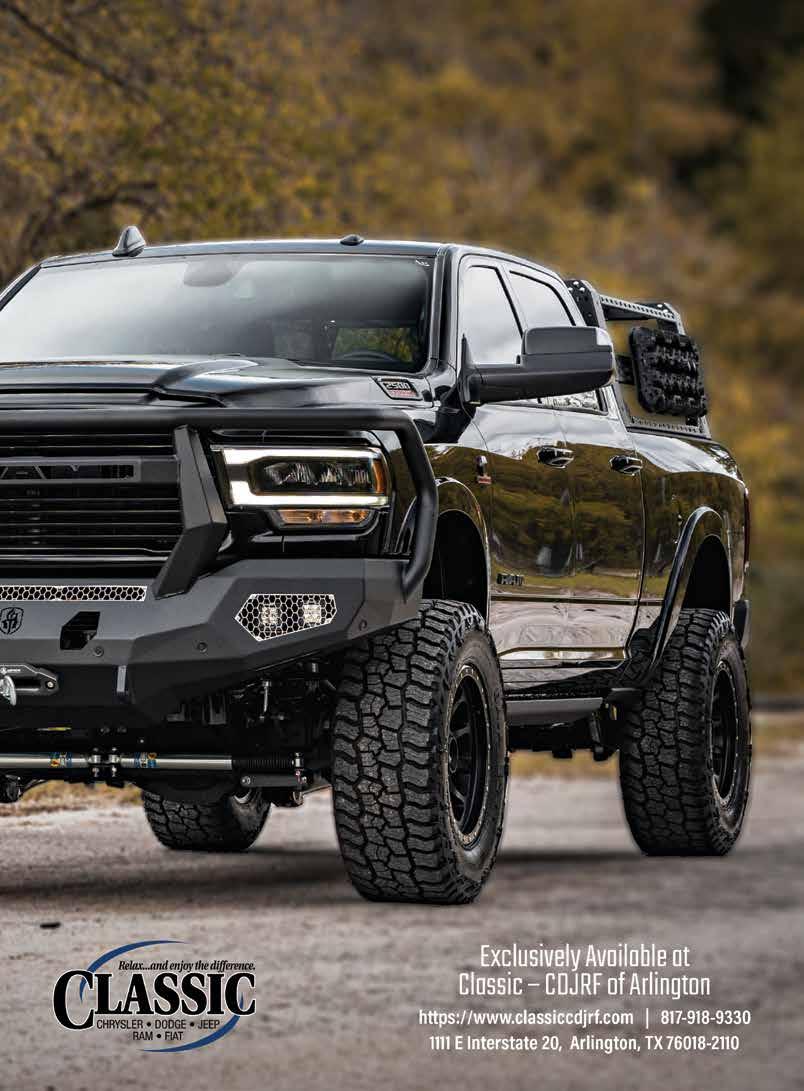
By Horace Gore
Kathryn Coleman of Richmond, Texas, is a pioneer of our hunting heritage. She grew up in the Houston area and went to Lamar High School. Graduating in 1952, Kathryn went to Baylor University in Waco, graduating in 1956 with a business degree. She returned to Houston, working with business interests. Part of her work involved the National Cash Register Company, and setting up programs for businesses as computers came into use.
Kathryn married Joe Coleman, who graduated Baylor Law School in 1957, and they continued to live in Houston. “I never hunted anything until I married Joe,” Kathryn said. “Joe had field trial English setters, and I followed him and the dogs in training and at quail field trials. I didn’t hunt deer until 1960 when we began hunting deer together in several counties: his home county of Freestone, and Frio, Dimmit, and other South Texas counties.”
“I killed my first buck in 1960 in Frio County,” she added. “It was a little pencil-horned spike that I shot with a Winchester .30-30 carbine. Joe had the taxidermist put the spike antlers on a nice, colorful board with all information—who, when, and where it was killed—with a remark, ‘Proof you can improve.’”

After that first deer, Joe got Kathryn a .243 and she used it for several years. When the .260 Remington came out in 1997, Joe had a custom rifle made for her, and she has used that .260 for all her big South Texas bucks. “I love my rifle,” Kathryn told me. “It’s deadly on everything I shoot at, it’s very accurate, and the recoil is pleasant.” Kathryn got her best buck with the .260 Remington in Dimmit County.

Kathryn Coleman
Kathryn laughed when she talked about her early days and deer hunting with Joe. “Joe made sure I had good, warm hunting clothes,” she said. “In those days, all of the warm underwear was big and fluffy, and after I got all my clothes on, I looked like a blimp!” Kathryn said Joe got her some electric socks for her cold feet. The socks had wires that ran up each leg to the waist, where a battery box would attach to the belt. “The electric socks worked very well,” she added. Kathryn wears knee-high boots while hunting and elsewhere in the outdoors, so I asked how she got started wearing the boots. “Well, Joe wears dress boots every day when he’s working at the law office, and I like to wear boots, too,” she said. “A lady bootmaker in Raymondville would come around to hunting camps and measure your feet and


send you a pair of boots. Well, I don’t know how many pairs of boots she made for me and Joe, but it was several. Each pair was perfect and fit like a glove.”
Kathryn and Joe raised two kids, John David and Kathryn Ann, and took them to the deer blind at an early age. One of Kathryn’s friends asked, “You don’t shoot a rifle with that baby in the blind, do you?” The kids grew up on chicken fried venison, and Kathryn always had a good stash of deer meat. John David hunts in South Texas from his home in Temple, and Kathryn Ann is employed at Baylor University and lives in Waco.
The Muy Grande Deer Contest in Freer has always been special to Kathryn. She has taken bucks to the contest from the beginning, when she was one of the few female hunters to enter a buck. “I’ve had my share of wins in the female divisions at Muy Grande because there were only a few women entered in the contests,” she said. She and Joe also won several times at Muy Grande as a
Kathryn and Joe with their trophy bucks. She has used her custom .260 Remington rifle for all her big South Texas bucks.

husband-and-wife team.
Muy Garza (center) inducted Kathryn and Dr. James Kroll into the Muy Grande Hall of Fame in 2011. The author said it was difficult to tell which recipient had the most pride that day.
“I’ve taken some big bucks to Muy Grande through the years,” she said, “and some were unique—big six-point; drop tines; wide spread; non-typical. I’ve taken them all.” She noted she had killed several typical 180s, but never a Boone and Crocket buck. “Joe has a big B&C buck, but I haven’t killed one. It’s not fair,” Kathryn said.
One of the highlights of her hunting career was being inducted into the Muy Grande Hall of Fame in 2011. Two honorees received the prestigious Hall of Fame Award, and it was difficult to tell which one was the proudest: Kathryn or Dr. James “Dr. Deer” Kroll.
Kathryn and Joe are longtime friends of Texas Trophy Hunters and have added much to Texas hunting and the outdoors. She’s a deer hunter, par excellence, and has shared her love of hunting with Joe and their many friends. It’s an honor to recognize Kathryn as a pioneer of our hunting heritage.
Do your part to preserve our hunting heritage. Share your passion with the next generation. Pass the torch.



How do you pass the torch? Share your photos with us. Send them to editor@ttha. com. Make sure they’re 1-5 MB in file size.



TPW Commission Approves 2024-25 Statewide Hunting, Migratory Game Bird Regulations
Texas Parks and Wildlife Commissioners also approved in late March other changes to the 2024-25 Statewide Hunting and Migratory Game Bird regulations:
• Change greater white-fronted goose daily bag limit restrictions from two in the aggregate to a simplified dark goose daily bag limit of five in the western zone.
• Change the Special White-winged Dove Days season structure due to calendar progression.
• Change the season structure of the second segment for dove in the north zone to allow later dove hunting during the holiday season.
• Require statewide mandatory harvest reporting for all wild turkeys during all seasons and counties to improve harvest data for their management.
• Close the spring-only hunting season for wild turkeys south of Highway 82 in Fannin, Lamar, Red River and Bowie counties due to ongoing wild turkey restoration by TPWD, NWTF and landowners.
• Close all wild turkey hunting seasons in Bell and Williamson counties east of Interstate 35 (I-35) and in all of Milam County to allow the restocking of wild turkeys for population restoration by TPWD and landowners.
• Remove references to Rio Grande and Eastern wild turkey subspecies in regulations and replace with “wild turkey” to simplify county regulations.
• Reduce the wild turkey hunting season length and annual bag limit in Brew-
ster, Jeff Davis, Pecos and Terrell counties west of the Pecos River; Comal, Hays, Hill, McLennan, and Travis counties east of I-35, and Guadalupe County north of I-10 to a spring-only season from April 1-30 and a one gobbler (male turkey) annual bag limit to be more proportionate with wild turkey populations.
• Change desert bighorn sheep hunting season from Sept. 1 – July 31 to Nov. 15 – Sept. 30 to allow for safer flying conditions during TPWD aerial surveys.
• For properties enrolled in the Harvest Option of the Managed Lands Deer Program, allow youth to harvest bucks with a firearm for the same days that correspond to the early youth-only season for county regulations.
• Expand doe days in 43 counties in the Post Oak Savannah and Pineywoods ecoregions to better manage white-tailed deer populations.
• Expand youth-only seasons in the fall to include Friday for white-tailed deer, squirrels and wild turkeys to allow greater hunting opportunity for youth.
—courtesy TPWD
The Texas Parks and Wildlife Commission voted unanimously to eliminate the light goose conservation order, making Texas the first state to have done so. Commissioners also approved at their March 28 meeting the lowering of the daily bag limit for light geese from 10 to five, standardize possession limit for light geese to three times the daily bag limit, and extend the regular goose season for light geese by 19 days in the Eastern Zone.
Owen Fitzsimmons, webless migratory
game bird program leader for Texas Parks and Wildlife Department, along with his staff, recommended removing the order and implementing other associated items.
“Liberalized hunting regulations and near year-round pressure on these birds across their range have resulted in significant changes to mid-continent light goose distribution and behavior, both in Texas and throughout the flyway,” Fitzsimmons told commissioners at their March 27 work session.
Fitzsimmons cited data on declining geese populations in the state, as well as a decline in hunter participation. He said the light geese population has gone from a high of 19 million in 2007 to less than 3 million in the most recent estimate, a decline of 86% over a 15-year period.
“That decline is not due to the conservation order or regular season harvest,” he said. “In fact, researchers have now concluded that the conservation order, and the liberalized regulations associated with it, have been largely ineffective at reducing light geese as intended. The recent decline, instead, is primarily due to very poor recruitment of young birds into the population. Climate change is impacting seasonal timing in the Arctic, creating a mismatch of resources during the very limited summer breeding window, and the young birds are simply not surviving to adulthood.”
Horace Gore, retired wildlife biologist with Texas Trophy Hunters noted that Texas rice production has gone down drastically in the last 15 years because of water shortages. “White geese are rice geese, Gore said. “The number of white geese around Eagle Lake and other rice farming areas is determined by rice acreage, which also determines the number
of geese that winter in Texas.”
“Goose hunters hardly ever go out and kill 10 snow geese,” he said about the bag limit, adding he has hunted snow and speckle-belly (white-fronted) geese for many years. “Season length has more effect on harvested geese than daily bag limits, and we have to understand that all waterfowl hunting in Texas has decreased during the last two generations.”
U.S. Fish and Wildlife Service established the light goose conservation order in 1999 as a way to manage a growing light goose population and decrease overgrazing in their nesting habitat in the Arctic. But 25 years later, the order is no longer necessary and not compatible with current conservation needs in Texas, according to Fitzsimmons.
“For 25 years, this population of geese have been the most pressured game birds in North America,” he said. “They are hunted nearly year-round across their entire range. The proposals here will alleviate some of the pressure on Texas birds.” —TTHA staff
Study: Early humans used wood splitting 300,000 years ago to hunt animals
Early humans used sophisticated crafting techniques such as “wood splitting” to hunt and to clean animal hides, a new study has revealed. Using new cutting-edge imaging techniques such as 3D microscopy and micro-CT scanning for the first time, scientists from the Lower Saxony State Office for Cultural Heritage (NLD) and the Universities of Reading and Göttingen examined the oldest complete hunting weapons known to humankind. The weapons, believed to be 300,000 years old, were found during archaeological excavations in Schöningen, Germany, in 1994.
The research, published in the Proceedings of the National Academy of Sciences, identifies how pre-Homo sapiens hunters re-sharpened broken points of spears and throwing sticks. Other tools were made by splitting wood, a behavior previously thought only to be practiced by our own species, Homo sapiens. Some tools made from split wood were likely used not for hunting, but to soften and smooth animal skins.
Dr. Dirk Leder, from NLD, said, “There is evidence of much more extensive and varied procedures of spruce and pine woodworking than previously thought. Selected roundwoods were worked into spears and throwing sticks and brought to the site, while broken tools were repaired and recycled on-site.”
Dr. Annemieke Milks, from the University of Reading, said, “What surprised us was the high number of point and shaft fragments coming from spears and throwing sticks that were previously unpublished. The way the wooden tools were so expertly manufactured was a revelation to us.”
At least 20 spears and throwing sticks were among the weapons found at Schöningen three decades ago. In the years that followed, extensive excavations yielded numerous wooden objects dating from the end of a warm interglacial period 300,000 years ago. The findings suggested a hunting ground on the lakeshore.
The wide range of woodworking techniques used on the weapons and tools show the importance of wood as a raw material 300,000 years ago. The Schöningen finds bear witness to extensive experience in woodworking, technical know-how and sophisticated work processes. Project leader Professor Thomas Terberger, who works at the NLD and the University of Göttingen, said, “Wood was a crucial raw material for human evolution, but it is only in Schöningen that it has survived from the Paleolithic period in such great quality.”
Schöningen is therefore part of the internationally outstanding cultural heritage of early humankind. Only recently, the site was included in the nomination list for UNESCO World Heritage Site at the request of the state of Lower Saxony. courtesy phys.org
Oppose Catalina Island Conservancy Attempt to Eradicate Mule Deer
Safari Club International (SCI) and SCI California Coalition staunchly oppose the Catalina Island Conservancy’s unscientific proposal to eradicate the mule deer population from the island. Both

organizations are advocating for reasonable alternatives, such as an expanded program of legal, regulated hunting, that would balance public enjoyment of wildlife with harvest opportunities for lean, organic sources of protein.
California Gov. Gavin Newsom has a long history of disrespecting hunting and hunters’ ethical, sustainable, and critical role in wildlife management. Yet his administration and the California Department of Fish and Wildlife are comfortable with an aerial slaughter plan to kill thousands of deer wantonly.
Before such extreme measures are even considered, SCI believes it is critical to determine the carrying capacity for mule deer and bison on the Island. SCI demands peer-reviewed studies to assess the feasibility of coexistence with native fauna. Sadly, the Conservancy’s record of this type of scientific approach is poor. For example, in the instance of bison management, the Conservancy first established a birth control program, then it reversed course and proposed introducing additional bison to expand genetic diversity in the herd. With respect to the deer population, residents and non-Conservancy-affiliated biologists question the Conservancy’s methodology for population estimation.
The Conservancy’s use of cherrypicked information to make consequential decisions is alarming. Mule deer provide significant benefits to Catalina Island residents, and their impact on Island vegetation is not significant—despite Conservancy claims. The Conservancy’s plan to eradicate deer on the Island has been rejected at least twice due to lack of data and scientific support. It should be rejected again, especially as it does not meet the standard for a “Scientific Collection Permit.”
“If Gov. Newsom and the California Department of Fish and Wildlife care about science-based conservation, they will reject the Catalina Island Conservancy’s foolish deer mule eradication proposal immediately,” said SCI CEO W. Laird Hamberlin. “Proper management of the deer mule population via regulated hunting and other tried-and-true methods, not ill-founded aerial slaughter,

will ensure ecological harmony on Catalina Island.”
“Mule deer have thrived on the Island for a century, while thousands of sportsmen and women have participated in regulated hunting seasons since then,” noted SCI California Coalition’s Legislative Coordinator Lisa McNamee. “We stand ready to collaborate with the Department to create sustainable, prohunting deer and bison population management strategies once this proposal is no longer on the table.” — courtesy SCI
The Louisiana Wildlife and Fisheries Commission voted April 9 in support of a black bear hunting season beginning in December 2024. The season will take place in the Tensas River Basin bear management area—home to the state’s largest and most rapidly expanding black bear subpopulation. Safari Club International (SCI) proudly supports this vote as it is the first black bear hunting season in Louisiana since the 1980s and recognizes the success of recovery efforts for the species.
From the early 1990s through 2016, the Louisiana black bear was listed on the Endangered Species Act (ESA) and was the only black bear species ever to be ESA listed. However, the Louisiana black bear has recovered due to strong collaboration between the state, the federal government, and private landowners. Under the state’s newest management plan, hunting is a welcome addition to the collection of appropriate management tools that help maintain the population at a healthy level and keep bears within their core habitat.
SCI, Safari Club International Foundation (SCIF), and SCI’s Chapters have steadfastly supported Louisiana black bear recovery and conservation. SCI was the only organization to defend the 2016 removal of black bears from the ESA list and successfully obtained a dismissal of the lawsuit twice. Maria Davidson, SCIF’s Large Carnivore Program Manager, has over 25 years of experience managing the black bear recovery
program and is the former Large Carnivore Program Manager for the Louisiana Wildlife and Fisheries Commission. SCI’s Acadiana Chapter has contributed thousands of dollars to critical black bear recovery programs and incentivizing rewards for bringing bear poachers to justice.
“We are thrilled with the Louisiana Wildlife and Fisheries Commission’s vote to open a black bear hunting season. The best available science has proven that regulated hunting is the only method to manage bear populations in suitable habitats,” said SCI CEO W. Laird Hamberlin. “A new season would be conducted in a manner that safeguards the long-term viability of Louisiana’s black bear population while providing a new hunting opportunity in the Sportsmen’s Paradise.” — courtesy SCI
On April 9, the House of Representatives passed H.R. 6492, the Expanding Public Lands Outdoor Recreation Experiences (EXPLORE Act), on a voice vote, a clear sign of the widespread support for this legislation and outdoor recreation, including hunting, fishing, and recreational shooting. This bipartisan legislation is strongly supported by the Congressional Sportsmen’s Foundation (CSF) and is led by Congressional Sportsmen’s Caucus (CSC) Co-Chair and Chairman of the House Natural Resources Committee, Rep. Bruce Westerman, along with nearly two dozen other Representatives, many of whom are CSC Members.
H.R. 6492 is complementary to another comprehensive package known as the America’s Outdoor Recreation Act, which is led in the Senate by CSC Co-Chair Sen. Joe Manchin and CSC Member Sen. John Barrasso. The EXPLORE Act includes a number of longstanding CSF priorities, including an important provision that CSF has been spearheading for the last five years that will increase recreational shooting opportunities. Specifically, the range access language contained in the EXPLORE Act requires the U.S. Forest Service and the Bureau of Land Management to have a minimum of one free and public target shooting
range in each of their respective districts. The Range Access Act also helps improve conservation funding through the Pittman-Robertson Act, which is the largest source of wildlife conservation funding for state fish and wildlife agencies.
The EXPLORE Act will also assist federal agencies in efforts to prevent the spread of aquatic invasive species, which pose a serious threat to native aquatic ecosystems and the economy. Once established, aquatic invasive species are difficult, if not impossible, to eradicate, and significant resources must be invested annually in population management. The bill provides federal land management agencies with the authority to carry out inspections and decontamination of vessels entering or leaving Federal land and waters. However, CSF worked to include language that will not prohibit boating access in the absence of a federal, state, or partner’s inspection station. Additionally, this legislation includes language that will help improve future federal land agency planning decisions and would enhance user planning efforts. Specifically, the Improved Recreation Visitation Data section directs certain federal land management agencies to capture various recreation visitation data. This section also establishes a real-time data pilot program to make available to the public real-time or predictive visitation data for federal lands, helping sportsmen and women with their trip planning efforts.
Furthermore, the EXPLORE Act contains another longstanding CSF priority that would streamline the permitting process for small film crews (six individuals or fewer) conducting filming or photography on federal lands. Under current law, small film crews are treated the same way in the permitting process as large-scale Hollywood productions. However, this legislation will make it clear that no additional film or photography permits are required for those small film crews, in accordance with other applicable laws and permit regulations. This provision will make it easier for sportsmen and women, outdoor production companies, and others to promote and share their federal land recreational experiences. — courtesy CSF



By Dr. James C. Kroll
Each year we receive hundreds of questions through social media on an array of topics related to whitetailed deer. Always among the top five questions are those related to deer parasites. So, I am devoting this column to providing you with facts about the most common parasites that afflict our favorite big game animal.
According to the CDC, parasites are “… organisms that live on or in a host and get their food from or at the expense of the host. Parasites can cause disease in humans.” Simply put, they are “free-loaders,” making a living at another organism’s expense. Sometimes they are benign and have little real impact on the host, while others can lead to poor health or even death. The majority of parasites do not have the goal of killing the host, since what good would that do for the parasite? So, what is their relevance? In deer management, more often than not, we use parasite presence or densities as a health and deer population indicator, because they often are what we refer to as “density dependent.”
Parasites are classified as one of two types—ectoparasites and endoparasites. The preface “ecto” means outside and “endo” inside. The ectoparasites either attach to or roam freely around the outside of a deer’s body, generally feeding either on blood or waste products such as skin and hair. Endoparasites must enter the deer’s body by some means, then complete its life cycle within one or more organs. Since I have spent the last two decades performing necropsies (animal autopsies) on several thousand deer, I have a pretty good idea which ones are most common and most significant. Let’s take a look.
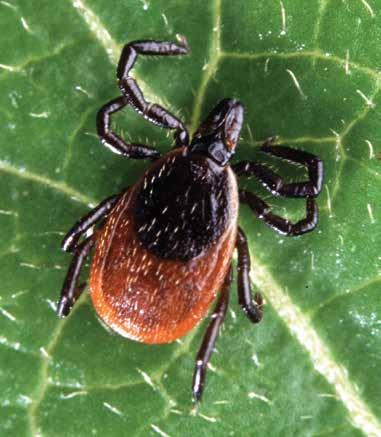
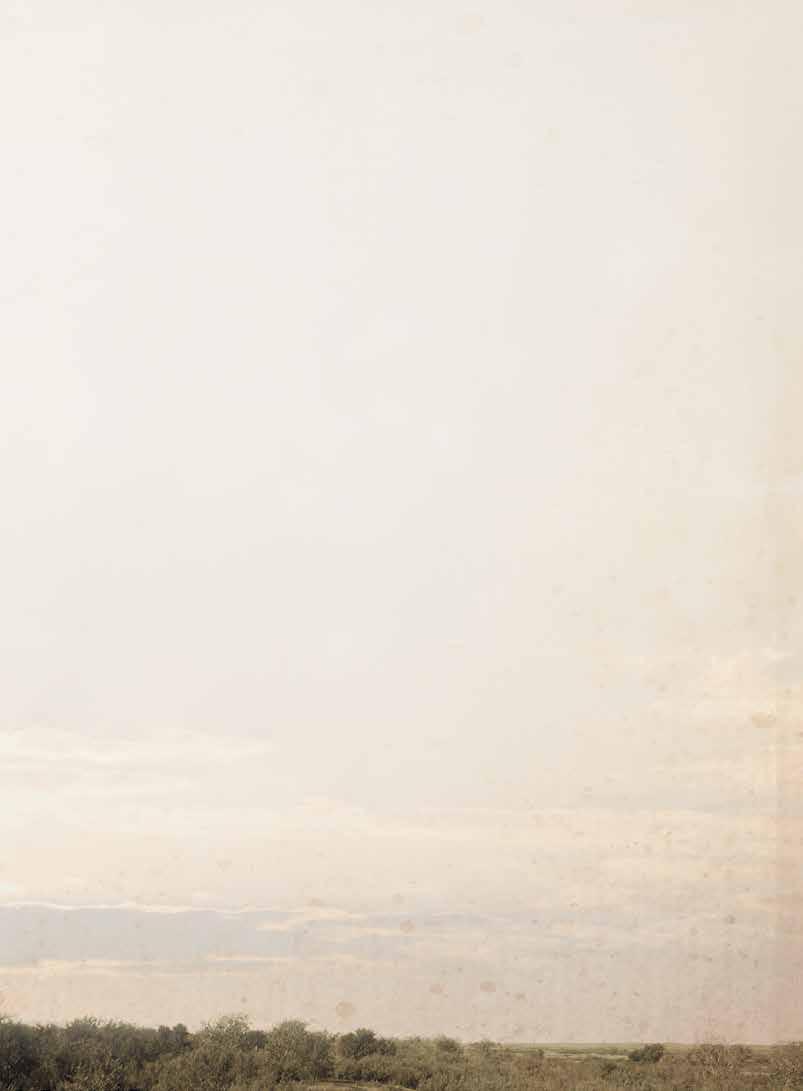

The two most common ectoparasites are ticks and keds; with a total of nine species being reported for whitetails. I think it’s safe to say, your first impression of parasites on your deer is when you spread that buck’s hind legs and begin to gut him. There are two types of creatures encountered—those that hold fast to the skin and those that try to run away. Simply, the first are ticks and the second, keds. Ticks are arachnids with eight legs and keds are insects with six legs. There are four species of ticks and three native species of keds known to afflict whitetails: most notable are Ixodes scapularis (black-legged tick), Amblyomma americanum (Lone Star tick), Lipoptena mazamae (neotropical deer ked), and the imported L. cervi (European deer ked), arriving in North America about 1900.
Ticks are known to transmit several diseases, most notably Lyme Disease (named after Lyme, Connecticut); which in spite of being around for 5,300 years, took many years for the medical profession to recognize. The disease is caused by Borrelia bacteria, most commonly carried by the black-legged or deer tick. The Lone Star tick has not been shown to transmit Lyme, but is responsible for other human diseases, such as Ehrlichiosis, STARI, and tularemia, among others.
When I began my career in eastern Texas, deer populations were exploding, and it was nothing to find as many as 80-90 imbedded ticks
on one deer. Years later, there are fewer ticks; some say due to fewer deer and fire ant predation. The life cycle of ticks involves three stages. An engorged female full of eggs that drops off her host. The larvae go through two stages, each with a separate blood meal, then become adults, after as much as 3 years. Native Americans regularly burned the forest to rid themselves of the pest.
Keds have a more complicated life cycle, beginning with a wingless adult living on the host. The female gives “birth” to a single fully developed larva that cements itself to a deer hair and pupates. She lives about 120 days and produces some 10-12 “young” during this time. The pupa hatches in three weeks, equipped with wings to fly to another host; then sheds its wings. They have piercing mouthparts that lacerate the skin of the deer, so the fly can lap blood. Although tick-borne pathogens have been reported in deer keds, there is no proof yet of transmission to humans or other animals.
Each year we receive dozens of inquiries that go like this: “I shot this deer and hung him up in the camp, only to come back and find some ugly fat worms lying on the ground beneath him. Can I eat this deer? ” They are the larvae (maggots) of the common nasal bot fly (Cephenemyia spp). Even if you have not seen them, you no doubt have experienced their effect, when you hear deer snorting and sneezing in the woods. Here is what is happening:
The nasal bot fly lays its already hatched larvae on a deer’s nose, which crawls into the nose and sinus cavities of the host.

Once there, they use hooks on their heads to hold on to the sinus lining. They remain for up to 10 months, feeding presumably on nasal secretions. Once mature, the larvae drop out of the nose, burrow into the litter, then pupate in

3-9 weeks. They transform into flies that cannot eat and start the process all over again. There has never been any evidence these parasites hurt the deer other than irritation. Nasal bots create no human health concern, and have no effect on the wholesomeness of venison.
Now, let’s turn to the endoparasite-some that can create significant health issues for deer. I am amazed how little attention hunters give the “insides” of a deer, unless something really “gross,” like a large abscess catches their attention when field dressing.
Liver flukes are endoparasite flat worms (Trematodes), which got their name from Old English for “flounder.” The ones infecting deer are the “large American liver fluke,” Fascioloides magnus. They draw attention when a hunter slices up a deer liver for cooking, only to find thick-walled chambers filled by dark black liquid and strange-
looking creatures that curl up on their edges. They are flat, football-shaped, measuring 15-30mm wide by 30-100mm long. Flukes do not have sexes, but are hermaphroditic. Their eggs pass out through the digestive tract in feces. In the environment, they undergo a complicated journey through snails to reinfect deer by ingestion of plants with larvae attached. Fluke infection is mostly around wet areas. I have never seen a deer, even heavily infected, die from live flukes; although other ruminants are not so lucky; especially sheep.
Round worms belong to the group called nematodes, which infect both plants and animals. Several species of nematodes have been reported for ruminants: 32 for whitetails. However, there really are only three I have found that cause significant problems—the barber’s pole worm, thread worm, and lung worm. I consider the latter two to be relatively rare, so let’s focus on the most common, the barber’s
pole worm.
Deer are ruminants with a fourchambered “stomach,” consisting of the rumen, reticulum, omasum and abomasum. The pH in the true stomach (abomasum) can drop to 2.1-2.2; obviously a pretty hostile environment. Yet, that is precisely where the barber’s pole worm, Haemonchus contortus, thrives. The life cycle of this worm starts with freeliving larvae from feces and ends with a parasitic adult phase, when they are incidentally eaten, completing the cycle. When I began my career, there was a lot of research correlating stomach worm numbers to deer density. It generally was thought to be true, although it has not always been the case. Because they are aggressive blood feeders, they cause “haemonchosis,” a condition caused by blood loss. Symptoms are anemia, weakness, enlarged lymph nodes, and swelling of the lower jaw from edema. Most of the serious cases are reported for warmer, wetter areas of the whitetail range.
So, there you have a brief primer of the most common whitetail parasites I have encountered. There are several more, but don’t be concerned. Deer are animals, and being such, they are susceptible to a host of diseases and parasites, just as humans. The take home message though, is the wonderful creatures called whitetailed deer have faced many threats over the millennia and come out on top every time. I seldom worry about them anymore.



José has seen his fair share of big bucks taken on the Charco Marrano. And now he can proudly take his place with other family members with his own B&C record buck.
Cody “José” Hunter is a deer hunter, par excellence, and last season in La Salle County, José took the best buck of his young hunting career.
Fall is a magical time of the year for Texans who enjoy the thrill of the hunt. Approximately 800,000 hunters pursue and take some 800,000 deer per season. Although many outstanding typical and non-typical bucks get taken each year, only two to four (at most) bucks will have what it takes to make the Boone and Crockett all-time records book.
Without exaggeration, the odds of killing a B&C buck in Texas are less than 1 in 100,000, considering that Texas hunters take 400,000 bucks per year. Those are slim odds, even from a state that’s historically a top producer of record book qualifiers.
The Hunter family has been fortunate to take several record book bucks on their Charco Marrano Ranch, southeast of Cotulla in La Salle County. Dedication and hard work implementing their wildlife management program over the past 25 years has led to tremendous success. Some of these bucks have been featured in past editions of The Journal Last season, José took the sixth book buck the ranch has produced, and this is the story of the young trophy hunter’s progression. José grew up in the Cibolo area and has enjoyed playing sports, hunting, and fishing. His parents, Travis and Jennifer Hunter, ensured he could go to the ranch as much as possible with Gramps and Granny, Phil and Jackie Hunter, along with the rest of the family.
There are eight grandkids in the family, and they’re known for their nicknames. José earned his moniker at age 4, while on the way to the ranch one afternoon with Gramps. “I was telling a story and probably stretching it a little,” he said. “Gramps kept saying, ‘No way, José! No way, José!’ and the nickname stuck. Everyone called me José from then on.”
When he was just 6 years old, José cut his teeth deer hunting. “All I wanted to do was hunt,” he said. “The ranch rule for the kids was that you had to shoot three hogs and three does in a row before you could hunt a buck.” José is the oldest of the grandkids and the first to honor the rule and be eligible for buck hunting.
Travis took young José hunting on a wet, overcast day when a nice eight-point buck stepped out at about 50 yards. “He was

Little did 6-year-old José know the blind where he shot his first buck would be the same one to later produce a
following a doe in and out of the brush along the sendero,” José said. “About the third time he came out, my dad made a noise and the buck stopped. I shot him with a .204 Ruger, and he ran about 30 yards into the brush before piling up.”
Cameraman Brian Hawkins caught everything on video. Trophy Hunters TV featured the video. It was a great day for the Hunter family. José was on top of the world and couldn’t have been prouder of his first buck. His smile in the old photos proves it.
That first buck would become one of many as José continued hunting. Over the next 13 years he would kill a dozen more bucks including a couple of pretty nice ones, scoring around 150. “As I got older, I began enjoying guiding and helping others get a deer,” José said.
Time has flown by, and little José is now 19 years old. Last
year he graduated from high school and began working in the family’s construction business. “I’m busy with work, but without school and sports, it’s actually been easier for me to spend time at the ranch again,” he said.
Last hunting season while at the ranch, José heard Gramps and his dad talking about a big 10-point the family had been watching. “They told me I was going to hunt that buck, and I thought they were joking. That was until we started hunting him,” José said. “I was excited to have the opportunity to hunt the buck. He was special to me because I was one of the first to spot him when he was a younger buck. We would also be hunting him at the same stand where I got my first buck,” he added.
The hunts started off slow with no sightings of the big buck. “I probably hunted a dozen times for the buck with various family members. He just wouldn’t cooperate,” he said. “We hunted Thanksgiving weekend and were unsuccessful, so we went back to town to work. A couple of days later, my cousin called and said he’d seen my buck. My dad and I quickly made plans to return to the ranch.”
Anticipation was high when they climbed into the familiar blind for an evening hunt. “We didn’t see him or really any-

thing that evening and were kind of disappointed,” José said. The next morning, José and Travis returned to the blind early. “We saw a few deer including a big non-typical buck, but not the deer we were after,” he said.
They were about to head in for breakfast when Travis excitedly whispered, “Oh my goodness, he’s right here!” The big typical 10-point they had been desperately hunting for stepped out of the brush a scant 40 yards away. “We stayed motionless and watched as the buck turned and walked away from us down the sendero,” José said.
Never one to miss an opportunity for a good ribbing, Travis whispered, “You don’t have to shoot him.” José turned and looked at his dad who was smirking and said, “I’m shooting him!” With that he got his .300 PRC ready and put the crosshairs on the big buck’s shoulder. The distance was about 100 yards and at the shot the buck wheeled around and ran 20 yards before falling over within sight.
“I’ll admit I was really nervous, but we knew he was down, and I was relieved,” José said about the aftermath. Eager to share the experience with the family, they quickly made a call and waited for everyone to arrive before going to take a look at the fallen trophy. After a short wait, the entire family arrived and organized chaos ensued.
“We knew the buck was big, but he looked so much bigger when we walked up to him,” he said. “His mass was impressive, and he had long brow tines!” A big batch of photos were taken while the story of the hunt was shared.
After the required drying time, José’s buck scored 1716⁄8 net typical and qualified for the B&C all-time record book. The beautiful typical buck was 7½ years old. José killed him within a stone’s throw of where he killed his first buck, and where it all began.
Travis has also taken some big bucks. “It took me a little longer to get a buck like that, but I couldn’t be happier and prouder of José,” Travis said. While extremely happy with the success of the hunt and his giant typical, José insists the hunt was about more than just the antlers.
“The experience of the hunt and opportunity to share it with everyone made it memorable for me. Qualifying for the book is just icing on the cake,” José said. “I look forward to helping the rest of the family and guests get big deer in the future!”


My son Robert is 10 years old, born and raised in San Antonio, Texas. Robert has worked his way from hunting javelinas, coyotes, hogs, and now whitetail deer. When Robert isn’t in the brush, he also loves to spend his time fishing at the coast and finding new fishing spots. When Robert was about 5 years old, he would ask me, “Dad, when can I go hunting with you?” I would tell him, “Soon, son. Soon.”
Not too long after Robert completed his hunters safety course, he was ready to hit the brush. He loves hearing old hunting stories from when I was a kid or hearing what it was like hunting with Grandpa Robert. I told him it’s no different from now, but it was a whole lot cheaper then. He makes sure to write down on the calendar when the Hunters Extravaganza will be for the month of August, and reminds me when the Extravaganzas end, we’ll have three more months until hunting season.
My father has a good, close, longtime friend, Manuel Garza. Growing up as a kid I had some great hunting experiences with my father and Manuel. Now that I’m 40 years old, I’ve now become the hunting guide for Robert.
The way my son’s whitetail hunt started was by helping Manuel on his low fence cattle ranch, located in Starr County, deep in South Texas. I help tend the cattle, do welding repairs, anything and everything, to keep the ranch in order. Manuel told me one day while I was at the ranch, “I have seen some good-looking bucks when I come to check on the cows. There’s one in particular that I think would be a great first buck for your son. It’s a good looking eight-pointer—he looks wide and has chocolate brown antlers.”
Afterwards, the 2023 hunting season was in full swing. We arranged a date to hunt, but had no luck spotting the eightpoint buck. I then told Robert, “We’re going to have to come
back and stay a few more days to hunt a little harder for this buck.” Robert agreed.
During Christmas break, Manuel called and told me, “I was out on the ranch yesterday evening and I saw a 10-point buck—heavy in mass and has good spread with tall tines. You need to get on him soon.” I then prepared to gather my things to make the trip to the Garza ranch to hunt this bigger buck.
We arrived at the ranch late in the evening to prepare for the morning hunt. About 5:15 we were in the deer blind and we let things quite down and settle. As morning light started to make its way in the sky, we saw a six-point buck that quickly appeared, only to head back in the brush. Soon after, I then hit my rattling horns to see if we could get any activity going.
I then saw something move to my left that came quickly to a halt. It was only a curious coyote that heard the crash of

my rattling horns. By then it was about 8 a.m., and the wind seemed to pick up from all directions. As Robert and I patiently glassed with our binoculars, carefully looking at every detail, Robert said, “Dad, maybe someone else shot him.” I then told him, “We need to give it some time. Be patient.”
I rattled once more, crashing the horns a little harder, hoping the wind would be in our favor. And about 15 minutes later, I saw something catch my eye to my left, and with great surprise, it was the buck Manuel had seen the evening before. I took the time to look at him for a bit and then slowly reached over

and tapped Robert. I said, “Look to my left. Try not to get too excited.”
I looked at Robert’s reaction and saw his eyes had grown big. I then told him, “Reach for your rifle while I open the widow to the blind.” As I opened the window, Robert then placed the rifle on the ledge.
I asked him, “Can you see him clearly?” He then said, “Yes
Dad, but he won’t stop walking.” I let the buck take a few more steps, then I grunted. The buck stopped to look, standing broadside. Robert quickly delivered the shot at about 80 yards and dropped the buck in his tracks.
Robert could not believe what had just happened. I turned to congratulate him, and he gave me a great hug and told me, “Dad, I’ll never forget this day.” I then told him, “Neither will I, little man.”
We then made our way to the buck and soon after, took a few pictures of Robert with the buck. By then it was about 10 a.m., so we loaded the buck in the truck and made our way back to San Antonio. I then asked Robert what he would like to do with the meat. He quickly said, “Dad, let’s get some beef jerky made.” “Sounds good,” I said.
We went to our favorite meat market to get the meat processed. I then explained to Robert, “This is all part of taking a deer, but now that you shot your first buck, I think it would be best to mount it.” So right after we left the meat market, we made one more stop at the taxidermist to start the mounting process. What an exciting day it was for Robert and me.
I want to thank my dad for getting me hunting at a very early age. And now, I get to pass it on to my son. But most of all I want to thank my great friend Manuel for making this father and son hunt a memorable hunting experience for years to come.




By Noah Lavender
What is a Texas Brigades summer camp? It’s a special five-day experience for youth ages 13-17 or incoming high school seniors. Camps focus on team building, leadership, conservation, wildlife principles, and having a fun week. I want to tell you all about my experience with this amazing summer camp.
I’ve only attended one camp so far, the North Texas Buckskin Brigade, but I know for sure I’ll be going back this summer. When I arrived at camp, I wasn’t a person that loved public speaking. Or talking to people. Or really anything that included talking to a random stranger. But within two days, I had talked to almost every single person there, made new friends, and had a blast!
When I first arrived, I went straight to the main classroom to take my hunter’s education test. We watched a video called

“Shoot or Don’t Shoot,” which makes you decide if you can shoot an animal or not. You have to base your decision off these three questions: Is it safe? Is it legal? Is it ethical? We would decide the answers to these three questions and then give an explanation for each answer.

After a bit of time passed, everyone else arrived at camp. We played a short icebreaker game to get to know each other a little better, then we all picked out our group (herd) names. We named our group the “Muy Grandes.” Later that afternoon, we all hopped on a bus and headed towards the barn to observe a deer necropsy. We all pulled out our notebooks and pens to start taking notes, which would come in handy the next day.
The next day, we woke up at about 5:30 a.m. and quickly cleaned our rooms before heading out for the day’s activities. Every day, members from our instructor team would come into our room for an inspection to ensure we kept things clean and tidy at the facility. Then later in the day, they would announce the winners. Depending on which placing your herd gets, you can receive anywhere from 2-10 points. These points would come in handy later when determining the Top Herd award.
We did our first trivia session this day about all the things

we had learned so far. For this first trivia, we were allowed to use our notes, but this luxury would be taken away. We did more trivia later in the day, worked on our designs for a large poster, then went to bed. This concluded a busy second day.
On day 3, we woke up even earlier and headed towards the pond. During sunrise, we wrote in our camp journals about camp and the scenery around us. After that, we went to some of the coolest activities of camp, the drop net demo, the rocket net demo, and a controlled burn demo.
The drop net is a net set up on four large poles with another one in the middle, supporting the net. The net was attached to a wire, which was attached to a pedal that sets off the rest of the trap. Once triggered, the net would drop down and capture whatever animal is below it. This net is more so intended for deer, moose, and other tall animals.
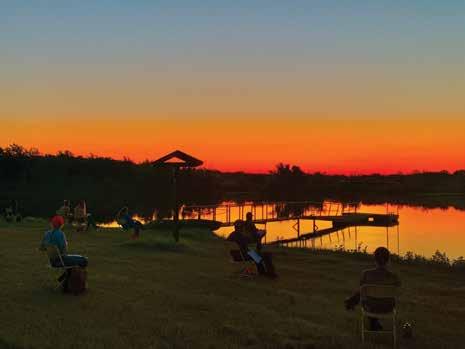
At the pond, campers wrote in their camp journals about camp and the scenery around them.
The rocket net, my personal favorite, is a net attached to some explosives in smaller pools on the ground. Like the other net, the rockets were attached to a wire, leading to a foot pedal. Once triggered, the rockets and net would fly through the air, capturing any animal below it. This net is used for rabbits, raccoons, and other smaller animals.

The controlled burn demo was very neat. The instructor used a thing called a drip torch, which drops fuel that ignites vegetation. After that, we got to go play some games to cool us off. We also practiced our marching, which is a big part of Texas Brigades summer camps. That was the end of a long third day.
On day 4, we went to the shooting range. We learned how to safely operate rifles and archery equipment. This was my first experience ever handling a firearm, and I enjoyed the opportunity very much. We also practiced marching some more and learned how to score deer antlers.
Then, of course, we learned about more plants. That night, it was time for the most extreme thing we had done at camp: poster night. This is the night where you stay up late completing your poster display and wake up at 5 a.m. the next morning. Although you have to push through it, it’s definitely one of my favorite times at camp. I love designing and writing, so this was practically heaven for me, no matter how long I had to stay awake.
On the last day, it was the time to use all of the knowledge and skills we gained from camp. We had competitions, antler scoring, labeling the parts of a deer jaw, shooting competition, trivia, marching, and so much more! It was eventually time for graduation. I won the Top Journal award, and I got a cool, leather-cover notebook as a prize. Our parents came to pick us up, and I slept the whole ride home.
Now, I’m doing things to earn points and get to go back to camp as an assistant herd leader, which means I’ll get to help with the camp. I’ve hung up flyers, shown off the poster I made on poster night, told people about Texas Brigades, and so much more. I can’t wait to go back to camp next year, and I hope I’m able to inspire others to join me.
Texas Brigades offers nine camps across the state. Applications are available Nov. 1. Visit texasbrigades.org for more information.
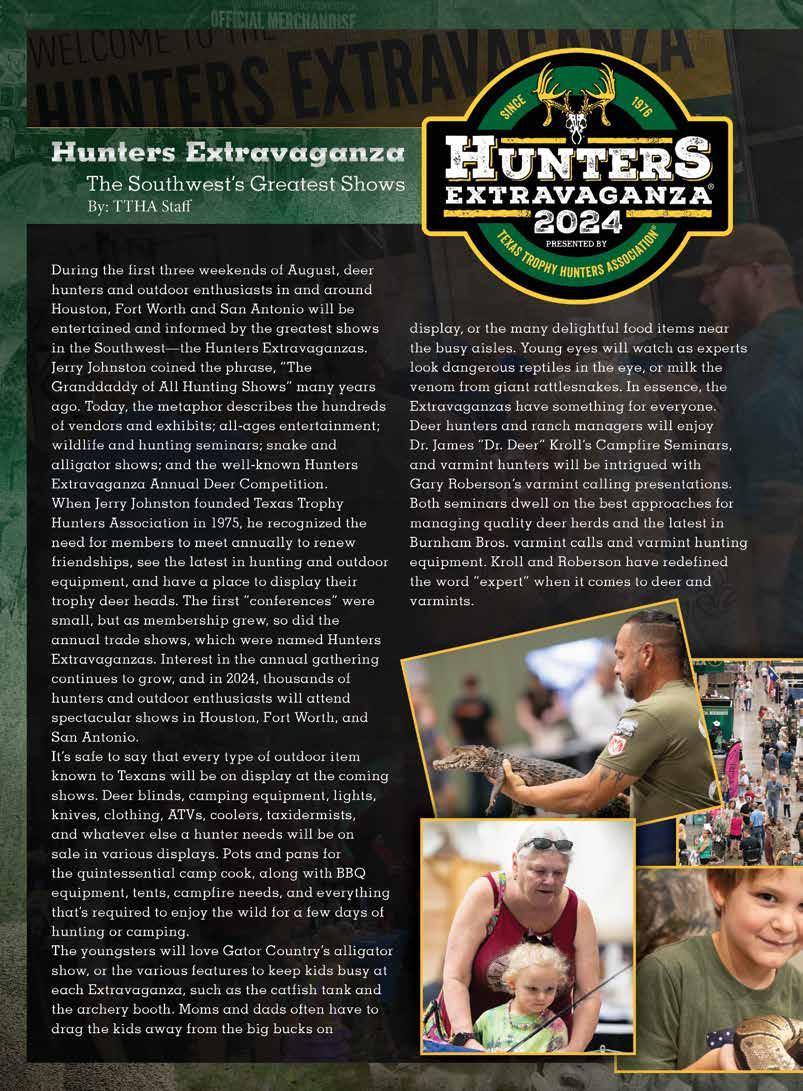
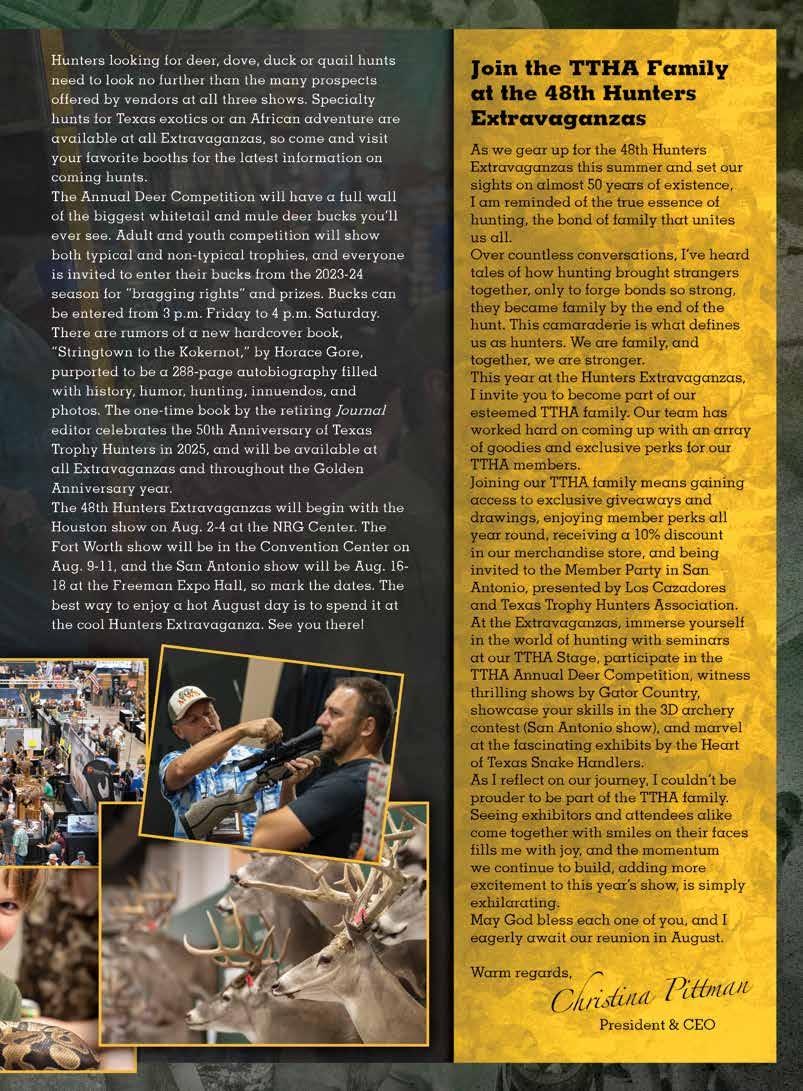









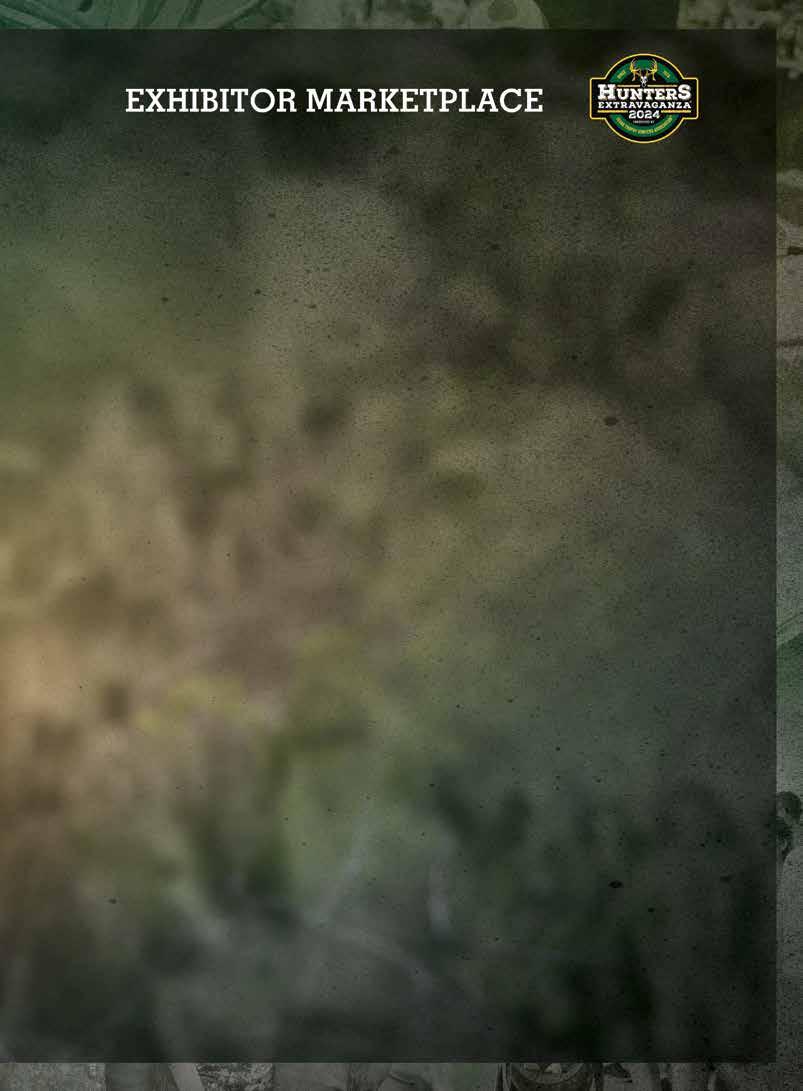

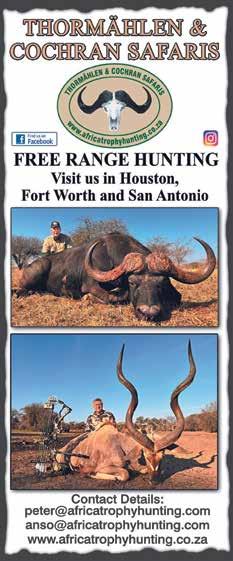










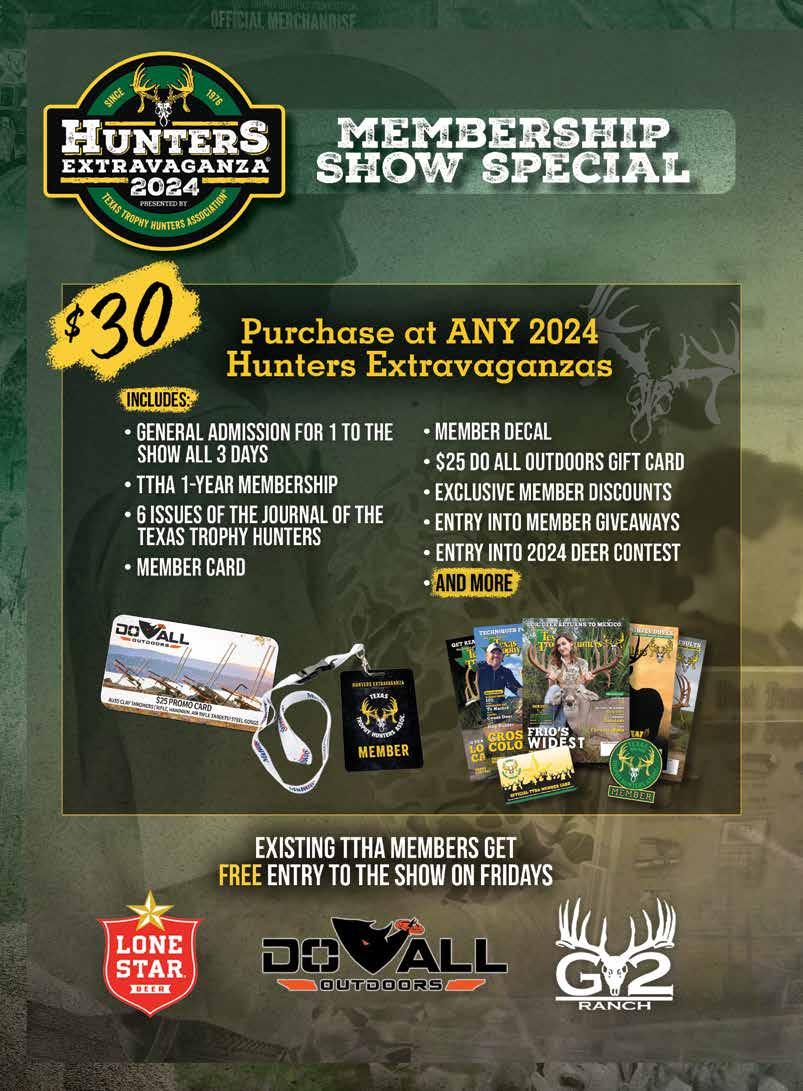
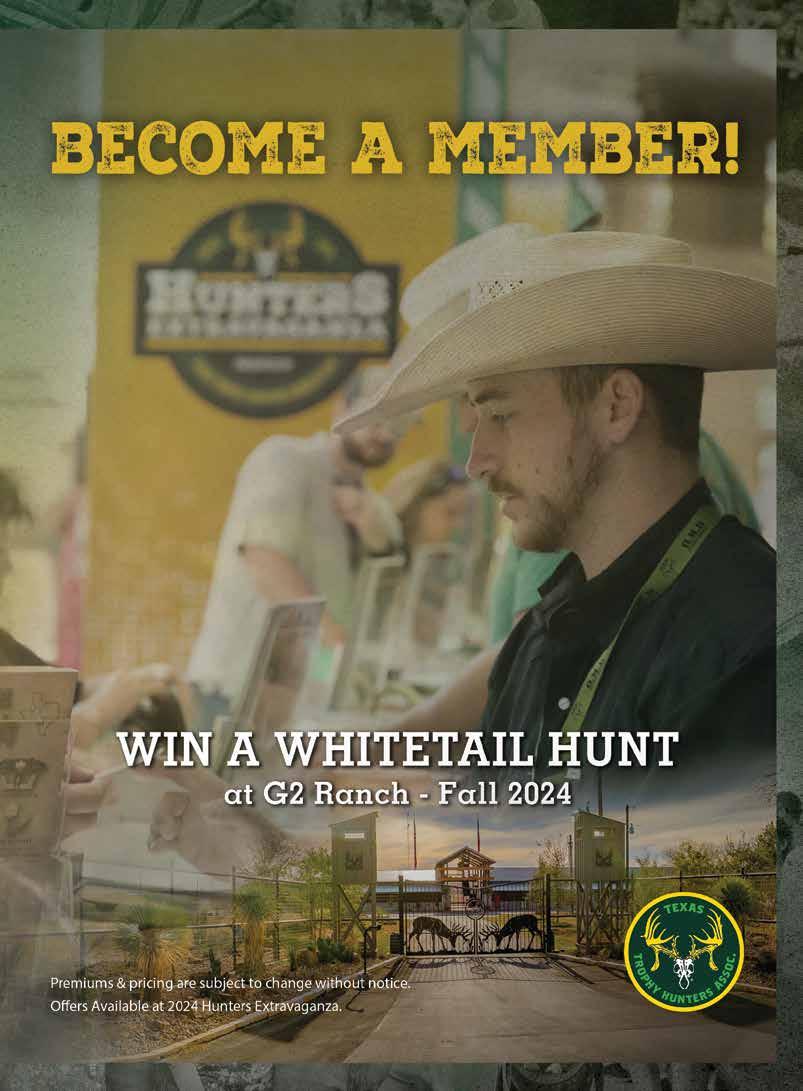
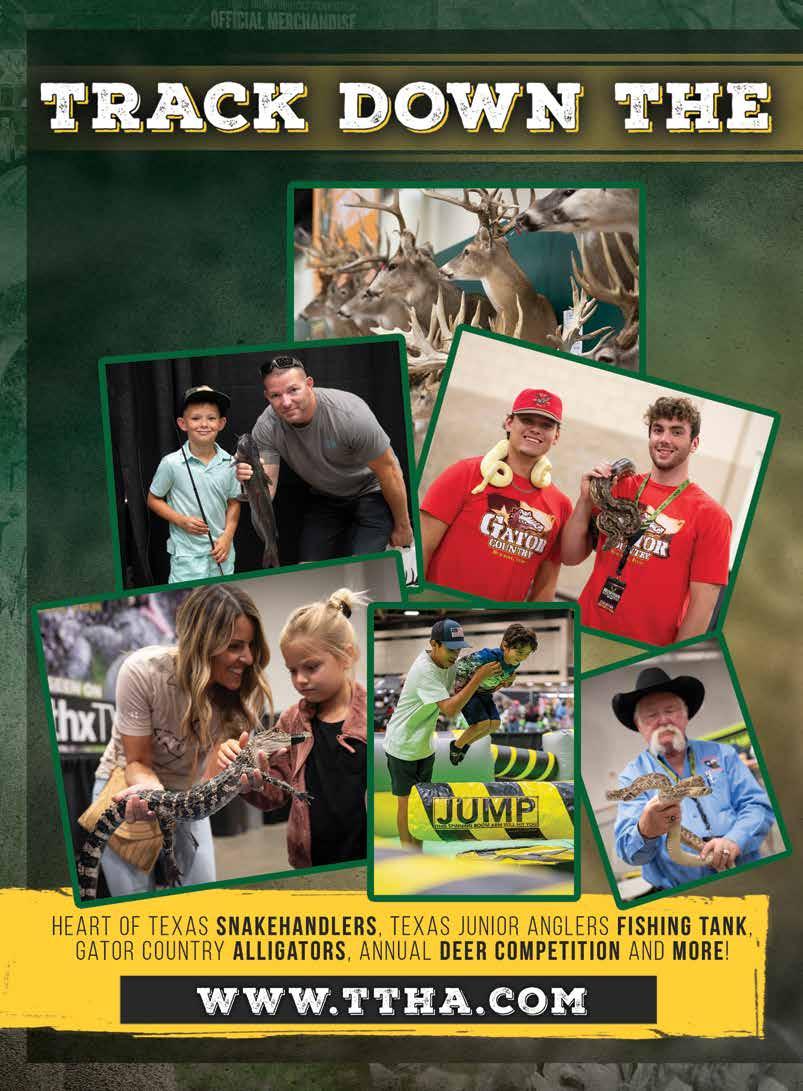






Summer fishing during the middle of the day isn’t just tough—it’s downright dangerous. It doesn’t take much to overheat and take all the fun right out of the pastime. However, if you’re looking to find the magic hour, any success you have clearly will be both audible and visible.
Concentrating early and late during the dog days of summer near the surface by throwing topwater lures often will provide amazing angling action in almost any body of water for species ranging from largemouths and smallmouths to stripers, redfish and speckled trout. Regardless of whether you’re angling on one of the biggest lakes or bays in the state or on a small family stock tank, the opportunities to see a big fish bust the surface while snatching your bait are better than average during the cooler parts of the day, which may mean it’s only 80
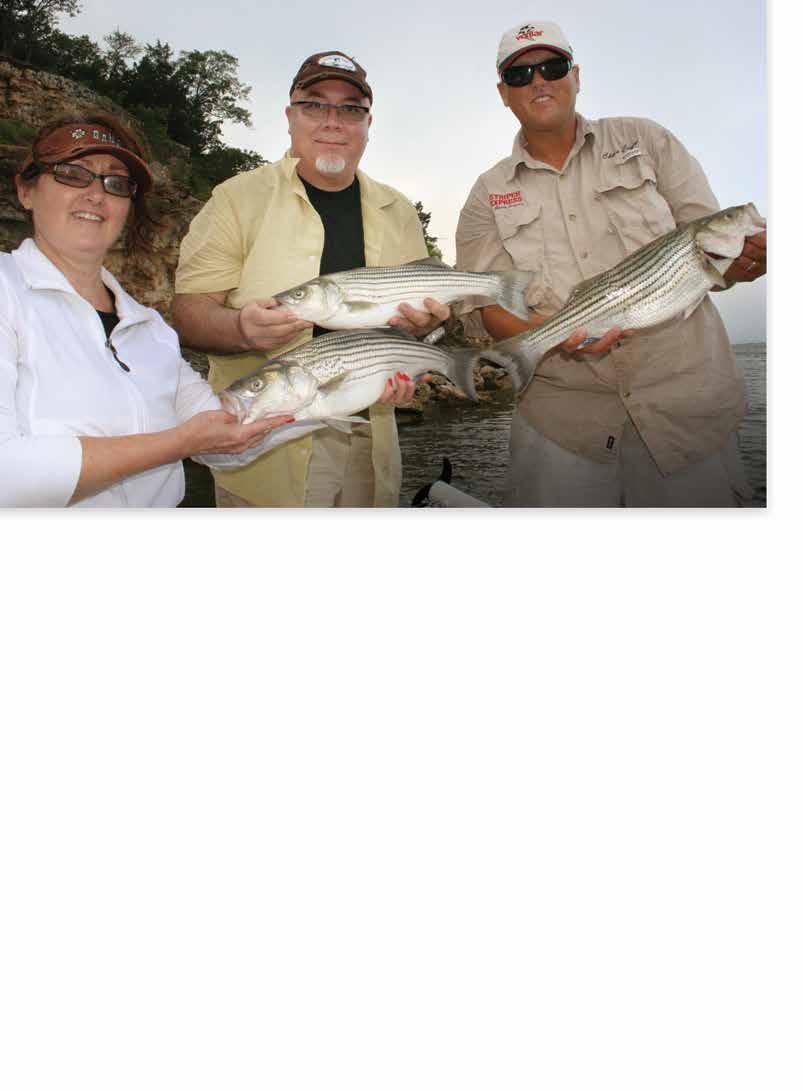
By Will Leschper
degrees instead of 100.
When most anglers think of topwater baits, they often have visions of time-tested thick plugs such as the Pop-R or Zara Spook spitting or chugging along, but lure companies today offer no shortage of imitations designed to attract fish to the surface, and with some variations, you can tailor an offering to changing water conditions in almost no time.
Working topwater lures into or near vegetation or other standing objects can be tricky, but many of these lures can be adapted to cut down on problematic hookups. With at least two or even three treble hooks on what typically are hefty lures, it certainly can be easy to snag anything from vegetation and clothing to a fish’s gills or eyes, which could contribute to mortality.
You don’t typically think about snags on open saltwater flats when you’re casting to redfish and trout, but if you’re using treble hooks, you’ll almost always find an accumulation of grass when you bring back a topwater, even if you can’t see any floating near the surface.
To cut down on snags, consider replacing treble hooks with single hooks. Many pro anglers fish topwaters with a treble in front and a single hook in back, which makes a lot of sense, especially if they’re probing thick vegetation or cover, or even if they’re trying to cut down on light grass. If it’s really a problem, consider using a pair of single hooks or even just a single barb.
Other topwater lures that allow anglers to alter their fishing presentations are buzz baits and spinner baits, which most often come with interchangeable blades that can
be switched out in a pinch to match conditions. Saltwater spinner baits have gained in popularity in a number of notable skinny water hot spots, and they’re designed to be rustproof, which certainly is a useful concept.
Boat docks and pilings are some of the best places to drag a topwater bait even during the hottest parts of the day, and since you don’t necessarily have to hit fish on the head for them to strike, you don’t usually have to be a top-flight flipper or pitcher. Other freshwater hot spots to think about are areas such as riprap, rocky points and standing timber, where fish tend to congregate before moving deeper as temperatures rise.
One approach to frog fishing or chunking a weedless lure is to bounce it off objects in the water. The theory is the added sound mimics a critter trying to get out of an area in a hurry and the fish will home in and strike simply out of reaction. Another theory on topwater fishing is it’s best during cloudy, overcast days or in low-light conditions, which negate a fish’s ability to get a clear look at a lure that’s making a lot of noise but may not fit the preferred shape of a usual meal.
While that’s a keen observation in many circumstances, it’s not rooted in fact. I’ve observed redfish suntanning—with their backs out of the water—strike a variety of lures on crystal clear flats without a hint of cover in the sky. In

those situations, it’s obvious that if the fish are even somewhat hungry and you don’t spook them, you’ve got a number of options to get them to strike.
Topwater fishing is amazing when the fish are willing to rise, and even a small bass or redfish can produce a booming strike. While their aim usually is true, they often miss their mark. The faster you hum a lure across the surface, the less likely a fish is to suck it down, so it’s good to slow down and vary your retrieves. Some fish will go a long way to track down a fastmoving lure while others won’t even give a slow-moving bait a second look.
Many times you’ll actually see a fish hit before you feel its weight, so you often must wait before ripping in the opposite direction. That especially is true in shallow water situations when you actually see a fish target, chase and slam your offering.
In the case a fish blows up on a lure but doesn’t take it, pitch it right back where the boil occurred, unless you can still see your target. Most bass pros often keep multiple rods at the ready when topwater fishing equipped with a flipping lure such as a Texas-rigged lizard or crawdad pattern for follow-up shots.
Though most anglers use a bait-casting setup for topwater fishing, it’s as easy to work many baits with a spinning outfit. For many topwater situations, the preferred rod is a heavy, fast-action stick equipped with a high-speed reel, which is good if you’re attempting to quickly horse a fish out of thick cover. However, you can fish most topwater baits with a medium, moderate-action rod and do just as well.
I’ve seen fish of all sizes thump lures of all sizes. Among the most exciting was a day lousy with white bass on Lake Texoma, when schools of 2-pound fish were exploding out of the water to hit 10-inch plugs rigged up more for stripers. Days like that are impossible to forget.
With a little effort, even the hottest days will turn out to be downright cool!

By Horace Gore
Iserved in the 86th Ordnance Battalion at Fort Hood in 1956 when Winchester introduced the .243 in their Model 70 bolt rifle. The .308 Winchester had been out since 1954—a sporting cartridge emerging from the military 7.62 NATO cartridge. Winchester technicians got smart, and necked down the .308 to .24 caliber, hence the .243 that hit the market like a whirlwind. The mild recoil and fast 100-grain bullet made the .243 a success as a deer and pronghorn rifle.
I used the .243 more on pronghorn antelope than whitetails, but my daughter, Donna, used a Winchester Model 70 in .243 to take a half dozen big bucks—all one-shot kills. We both found the 100-grain bullet was best for deer and hogs, while the 85-grain handload was excellent on pronghorns.
In the Southwest, the .243 was advertised as a “do-it-all” caliber for coyotes, whitetails, mule deer, and pronghorns. Hunters could use the factory 80-grain bullet on varmints, and the 100-grain on bigger game—a winner all-around. The pundits advertised the new cartridge as the best thing since sliced bread. The fast little bullet was praised for its killing power, while being light on recoil and muzzle blast. But for some, the cartridge came before its time.
In the ’50s, the popular deer rifles were .30-06, .300 Savage, .257 Roberts, .270 Winchester, and .30-30 carbine. When the Winchester .308 and .243 arrived, they were immediately accepted by hunters, and soon the two rifles were showing up in deer camps. The .243 was praised as a “Super Deer Rifle” by all, except South Texas deer hunters.
The .243 was not accepted in South Texas because deer hunters thought it was too small for the big brush country bucks. Hunters below I-10 stayed with their .30-06 and .270,
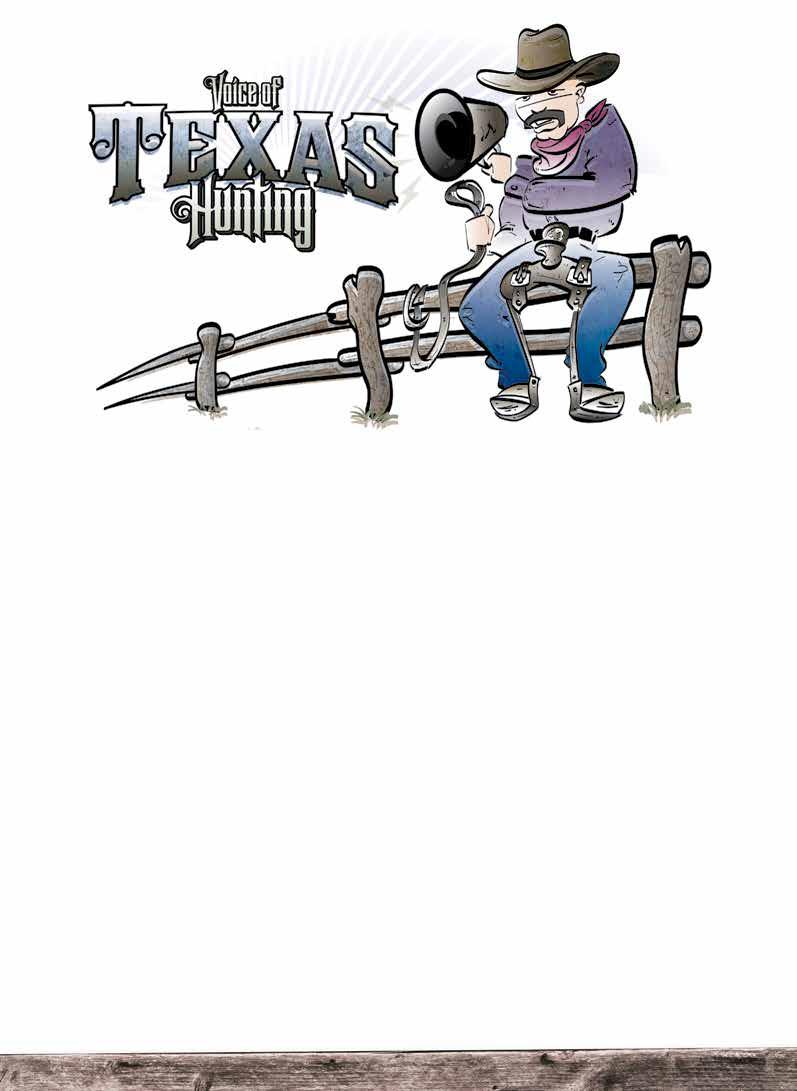
and referred to the .243 as a “popgun.” However, recoil-shy hunters such as wives, girlfriends, and kids, along with coyote hunters, bought the .243, and South Texas gradually took to the 100-grain cartridge for deer.
Then in 1962, the 7mm Magnum in the new Remington Model 700 rifle appeared, and the Magnum craze took over. The new .264 Win. Mag. and 7mm Rem. Mag. became the rage, and the little .243 was hardly ever seen on a South Texas deer hunt.
The .243 continued to be popular in the Hill Country and other deer hunting circles, as more females and youths took up deer hunting, and didn’t like the teeth-chattering Magnums, or even the .30-06 or .270. As a rule, hunters who shot a .243 at deer, pronghorn antelope, or even a coyote, soon pushed the .30-06, .270 or .300 Magnum toward the back, and kept the .243 up front.
By the turn of the century, the Magnum craze ended, and hunters began looking for milder deer and antelope cartridges in shorter barrels. The .243 gained renewed popularity in 22-inch barrels, along with new cartridges such as the 7mm08 and the 6.5 Creedmoor. Hunters in deer blinds discovered milder cartridges were very effective on deer and other medium-sized game, and that bullet placement was more important than a big bullet at high velocity.
Today, a good cadre of deer hunters tote a .243, which has gained popularity because of better factory ammo. Good rifles, good scopes, and good bullets have put the .243 in the top 10 deer rifles in the nation. It’s a deer cartridge that has been vindicated as one of the best mild “game-getters” for Texas whitetails. You won’t go wrong with a good .243.


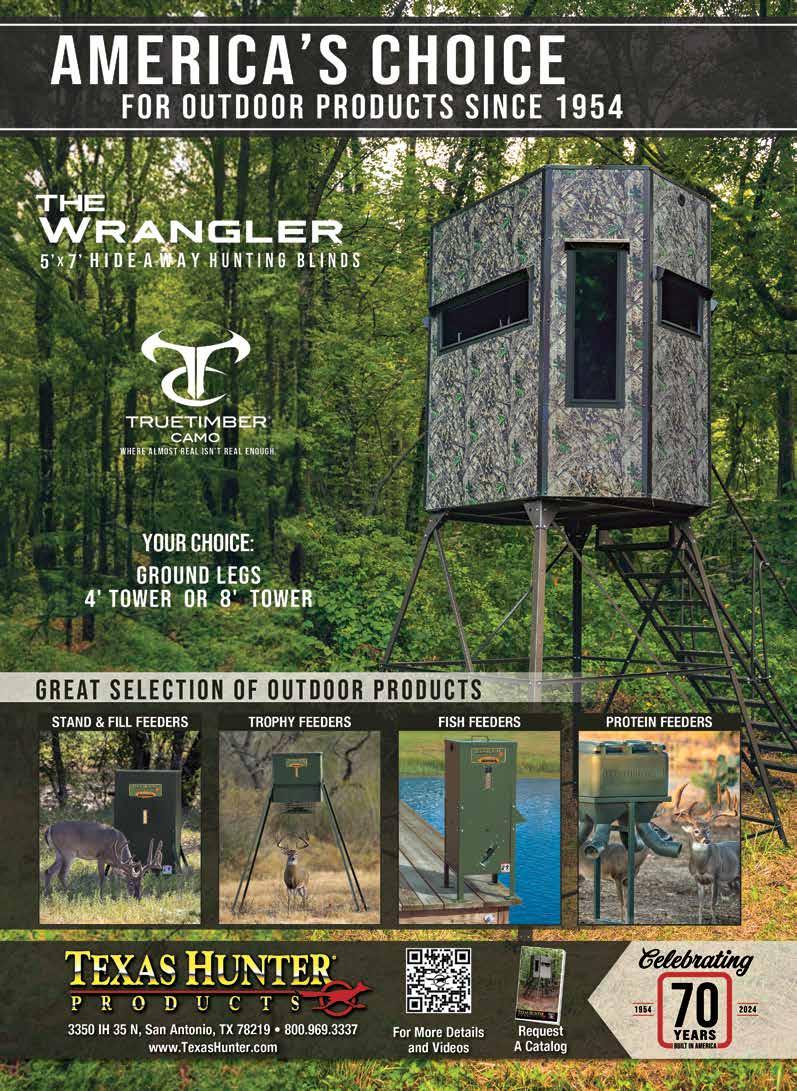

Brandon with his solo, do-it-yourself pronghorn from a tough hunt in New Mexico in August 2023.
The afternoon sun sat on my shoulders like an anvil. The air was dusty and too hot. The temperature was 110 degrees. New Mexico’s badlands are prickly in the summer months, but that’s where you find some of the world’s biggest pronghorns. Because I’m a pronghorn fanatic, I make the trip to the desert almost every summer.
It was two weeks until opening day, but I wanted boots on the ground to see what quality of bucks or lack thereof were available this year. I’d just spotted a bachelor herd of five bucks a quarter mile away from my truck window. Squinting into the spotting scope eyepiece, sand and grit in my teeth, I could tell one of the bucks was bigger in body size than the others. When he lifted his head, I noticed his handsome, coal black face markings and heavy, short horns. After three hours of bouncing around the rocky two-track roads on this middle-of-nowhere ranch, I finally found a quality buck.
From my scouting time, I could verify herd numbers were half of what they were just two years earlier. Rumor was the rancher allowed heavy hunting by a local outfitter the two seasons since I’d been on the ranch. The month before, talking to the rancher on the phone, I was hesitant to pay the hefty trespass fee without seeing the land in person, but with no luck in the public land draw, this was my only option in 2023. I was promised I’d be the only bowhunter on the ranch in archery season, but more hunters would follow in rifle season. As predicted, numbers were disappointing and the few bucks I did see were young. With several thousand acres to hunt, I now had only one buck I felt was worth my tag. Scouting revealed the truth.
So why scout? First, pronghorn populations fluctuate with environmental factors like drought or changes in ranching practices, like brush removal, increased hunting pressure or
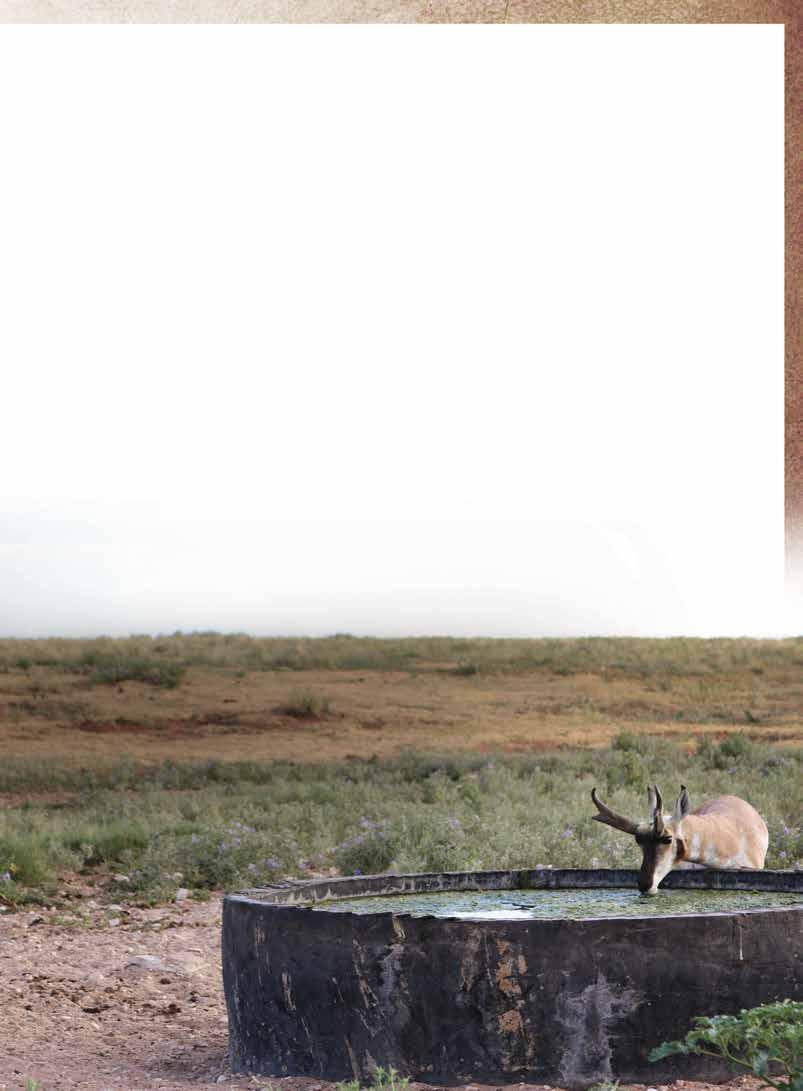
rotation of cattle grazing. An area that may have lots of antelope one year may have only a few animals the next. Find out early before you waste limited hunting days. Pronghorns are more visible than deer or elk. They inhabit mostly open, rolling terrain and they’re active all day. With good optics, it’s possible to glass most of the bucks in a specific area over the course of a couple of attempts. For me, my goal is to find out what a realistic, top-end buck looks like for that area and that year. Once I’ve scouted an area thoroughly, I feel like I can confidently decide what size buck to hold out for. If my goal is an 80-inch buck, but the biggest I’ve seen while scouting is a 70-incher, it’s time for a reality check.
Obviously, it’s not always possible to scout a week or two before opening day if your hunt area is far from home. If distance makes early scouting impossible, I suggest getting there one or two days before opening day. Basic gear like 10X40 binoculars, a spotting scope with a window mount, and several trail cameras will help locate bucks.
Learning boundaries is important. Whether you’re hunting a private ranch or public land, spend time getting to know the boundaries. Old school paper maps will work, or you can use a modern phone app like OnX maps. The app will show boundaries for public land, private land, and even the landowner’s name for each parcel of land. Besides learning fence lines, focus on the terrain. Especially for bowhunters, terrain with some rolling hills or pockets of brush or cactus will be better suited for stalking than featureless terrain. Finally, make notes of windmills and waterholes. Just because a waterhole is marked on the map, that doesn’t always mean it will be holding water. Inspect the mud around waterholes for heart-shaped antelope tracks. Trail cameras set near windmills or dirt ponds can show what time of day bucks quench their thirst. In my experience, midday from 10 a.m. to 2 p.m., or the last two hours before dark are when most pronghorns go to water. However, I’ve had

bucks water at every hour of the day, so when I guard water I sit all day.
On my 2023 New Mexico hunt, I traveled to the ranch two weeks before the archery opener. I’d hunted the ranch before, but wanted to see first-hand what conditions were like in the drought. I also wanted to set blinds and trail cameras. I spent the afternoon mostly driving and glassing. I set blinds and five trail cameras at three different water tanks.
The day before the opener, I drove back to New Mexico. Cattle destroyed one blind and knocked over two of my five cameras. I had a spare blind in my truck and repositioned bumped cameras. Cameras at the two windmills where I’d seen the most antelope on my first scouting trip confirmed the big buck I’d spied in late July was indeed watering at both locations. The two water tanks were roughly 1½ miles apart, but both were in the same large pasture. I found no puddles or seeps anywhere else in the pasture. There seemed to be no pattern to which water tank my target buck would visit, but four of the previous seven days he was on camera at one of the two waterholes. Mostly, I had hundreds of pictures of black cows. Despite driving and glassing diligently the afternoon before opening day, I did not see my target buck.
Opening day, I had a decision to make: which of the two waterholes to sit? I decided to sit at the north water tank because that was where I’d laid eyes on the buck while scouting. His most recent trip to water was at that blind.
As the sun chinned itself over the eastern horizon, I sat ready in my popup blind. A cooler full of drinks and snacks sat by my feet. My backpack contained two books, magazines, a notepad, pen, camera and my phone with a solar charger.
I sat in that blind for 14 hours. The high temperature was 95 degrees. One average-sized buck with both horn tips broken came to water at 6:30 p.m. I snapped his picture with my camera as he slurped water for two minutes nonstop.
A large covey of 40 blue quail came to water at sunset. By dark, I was weary, dehydrated, and a bit delirious after the all-day sit. In the dark, on the way to town, I stopped by the middle water tank to check my trail camera.
There, on the screen at 8:44 that morning, was ol’ short-and-heavy horns with the other four small bucks he traveled with. I would have another tough decision for day two: which blind to sit? After a burrito for supper at the gas station, I fell asleep in my hotel room with my boots on.
On day two, I decided to sit at the middle water tank since all five bucks had been there the day before. A long 13 hours passed under the beating sun. The high temperature was 93. A herd of black cows visited the water two different times, but other than a few pronghorn silhouettes far off in the distant heat waves, no pronghorns came to water.
With maybe one hour of shooting light remaining, and no pronghorns visible from my blind, I made the tough decision to

bail. Even though the last hour is often the best hour at water, I felt like I should have at least been able to see my target buck on the horizon if he planned to drink before dark. Visibility was a mile in every direction. I grabbed my bow and backpack and trotted north towards the other waterhole, stopping occasionally to glass. Maybe I could find my target buck and execute a stalk before daylight ended.
I covered the 1½-mile distance across sandy, cactus-covered terrain quickly. I saw no pronghorns along the route. When I eased over the rocky ridge, binoculars to my eyes, I could see down into the long ravine where the north windmill tank sits: the blind where I’d spent opening day. There in that small valley, only 100 yards from the water, I spied the herd of five bucks. They had just quenched their thirst and were now headed towards the yuccas and rolling hills. They appeared to be headed to a saddle between two brushy hills.
The bucks were 200 yards from my position. Using the roll of the terrain, I duck-walked behind a small hill to cut the distance. Hunkered down behind a waisthigh clump of yuccas—arrow nocked—I
saw black horns bobbing over the hill like antennas. I drew my 61-pound Mathews bow and waited.
First, the four small bucks walked by single file, then the bigger-bodied, older buck with short, heavy horns followed. From 36 yards away, my 409-grain Easton Axis arrow tipped with a Slick Trick broadhead sailed through the mature buck’s chest. Success at last!
My 2023 New Mexico pronghorn had heavy, short horns that
measured 132⁄8 inches long. Most of a pronghorn’s score comes from its mass. He had bases and second mass measurements both over 6 inches. By the beam of my headlamp, I secured my tag, gutted the buck, and used an arrow to prop open the chest cavity to cool.
Exhausted, I walked to my parked truck a mile away where I guzzled cold water, then drove back and loaded my pronghorn. I took down blinds, stopped in town to buy extra ice for the cooler full of meat, and started the long journey home to Texas. Like it usually does, scouting and hard hunting paid off.

Eric Stanosheck
he American pronghorn has always been one of my favorite big game animals to pursue with the muzzleloader each fall. Rare is the day that you don’t see animals while hunting for them, but it’s their 60 mph top speed, amazing eyesight, which is equivalent to high-powered binoculars, and wide-open country they call home that makes them a very worthy opponent in the game they force you to play. Most of us who hunt with muzzleloaders do it for the additional challenge, and what better species to chase than the fastest and most skittish big game animal in North America.
Opportunities abound if you know your way around tag allocations in western states. Many have either landowner tags

for purchase or opportunities to draw tags with only a few accumulated permit points. I’ve taken pronghorns in nine of the 16 states with hunting seasons, but for consistent opportunities each fall, you don’t have to look much further than Texas, New Mexico, Colorado, or Wyoming.
Wyoming is the only one of those states that doesn’t have landowner tag options, which allow you to hunt each year. However, there are more pronghorn in Wyoming than there are people, so finding animals is not too difficult once you get a tag.
I obtained a tag for my last Texas hunt by calling landowners from a list that is released in August. I only had 1,100 acres to hunt and there wasn’t a single pronghorn on it opening day of
season. Fortunately, I had driven all of the roads within 10 miles the prior day and I knew there were plenty of animals around, so I waited for the hunting pressure to push a great buck and his harem onto the property.
I easily took the buck at 125 yards right in the middle of the pasture. Sitting and waiting for hours is not the typical way I like to hunt a pronghorn buck, but it worked to perfection given the limits of my land access. That buck is still the largest Texas buck on my wall.
New Mexico has great potential for monster pronghorns. I have been blessed to take three Boone and Crockett bucks in that state with my muzzleloader. All were in completely different units of the state in back-toback years, using landowner permission and over the counter tags bought at the local Walmart. I usually use guide/outfitter information and connections, because they generally have access to the best land and know the available bucks. However, just driving around to ranches and knocking on doors has worked many years for me as well.
My buddy Aaron Bauer with Spot & Stalk Outfitters always steers me the right way in New Mexico when I want a high-quality hunt. Pronghorn seasons are only three days long, so it’s never a problem to squeeze a hunt on the calendar.
My New Mexico bucks have all been spot-and-stalk and involved
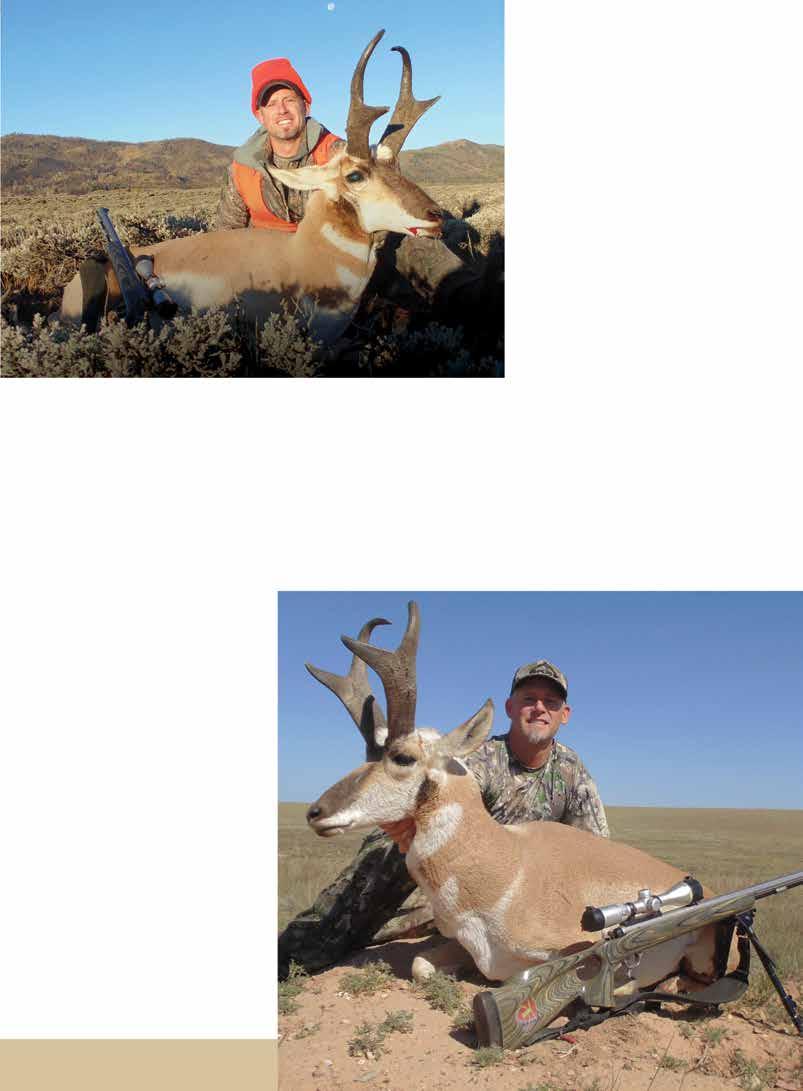
many hours both in the crawling and stalking as well as removing cactus stickers from my knees and hands. Pronghorn have tremendous eyesight and New Mexico generally has limited terrain to use in your favor when shooting a limited distance weapon. This requires many blown stalks, and changing to new plans.
I recently crawled within 80 yards of a bedded buck in nothing more than six-inch-tall grama grass and made a great shot off my bipod. The buck has the big-
gest prongs I’ve ever seen at just under 7 inches. You will sometimes question your sanity when you come face to face with a prairie rattlesnake as you are slithering across the prairie in pursuit of a big pronghorn buck.
Colorado has landowner tags available in many units and it only takes a bit of dedicated research to put a tag in your pocket each season. I’ve hunted quite a number of units in the state, but I prefer the higher elevation hunts.
My best buck was a border-hopper and actually was one I became very familiar with in mid-summer on a scouting trip. Not only was this buck a no-brainer for Boone and Crockett, he was actually very predictable in his route, marking territory on both sides of the Wyoming/Colorado line. After establishing his home turf in July, I returned in October and shot him at less than 100 yards on opening morning, exactly where I had seen him every day back in July.
Opportunities abound if you’re interested in chasing the prairie speedsters called American pronghorns. So, get out there and burn some powder while enjoying an early fall hunt and get the kids into the challenge and enjoyment of black powder hunting. Pronghorns are a challenge you’ll embrace, especially when you have the limitations of a muzzleloader.




PRODUCTS AND VENDORS AT THE
Make sure you stop by the TTHA Merchandise Booth at any of the Hunters Extravaganzas to pick up the latest gear. We have something for the little ones and all the way up to the seasoned hunter. Don’t forget we offer members a discount on TTHA gear. Not a TTHA member? Join today! See details on page 44.
The Corn Feeder is a high-quality, affordable corn feeder featuring the licensed MB Ranch King Blinds feeder assembly housing. It’s available in a 500-pound capacity (based on corn weight) made with galvanized metal (hopper: 14-gauge, funnel: 14 gauge, sides: 20-gauge, and lid: 18 gauge). The assembly housing features THE-ELIMINATOR spinner plate that keeps all the corn from being exposed before distribution, which makes it hog and ’coon proof. It spreads the corn evenly up to 25 feet, keeping it away from the feeder. It comes completely assembled with the PLAN-B timer, 12-volt battery, and solar panel. It has a 50-inch fill height, making it easy to fill from the ground. Visit bosshawgmfg.com.
bosshawgmfg.com
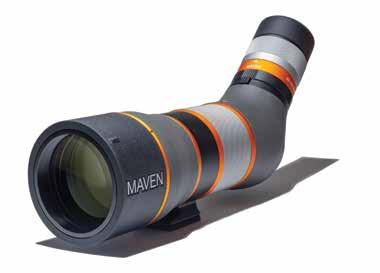
mavenbuilt.com


Maven’s S.3 20-40X67mm spotting scope provides a high-powered solution across a wide range of magnification levels with a smaller objective lens. Choose between the variable magnification zoom eyepiece for field use or a fixed reticle eyepiece to aid in target and competitive shooting scenarios. It incorporates fluorite glass, and ensures razorsharp clarity from edge to edge; exceptional performance in low light conditions; and delivers vivid, distortion-free, and brilliantly bright images. TTHA Member Discount Offered. Visit mavenbuilt.com.
Domain’s Bad Habit Attractant is specifically formulated to attract deer and provide an enhanced nutritional profile through key ingredients, such as protein, fat (energy), vitamins and minerals. Enhanced with berry infused flavor and aroma, this powerful attractant will attract deer from longer distances and help increase consumption as a means of optimizing nutrient availability. Bad Habit can be fed on its own or mixed with corn or feed, and can help provide the nutritional foundation for your deer management program. Sold in 20-pound, 7-pound, and 3-pound bags.
TTHA Member Discount Offered. Visit domainoutdoor.com/ collections/feed.

domainoutdoor.com/collections/feed

The Reveal Pro 30 has no glow flash; built-in GPS; new internal storage with optional SD slot; new on-demand video requests; new improved image sensor; new cellular firmware updates; new pre-installed antenna; new internal SIM card; new multi shot: 5 photos; new live aiming in app; 1080p FHD video; faster photo sends; and improved battery life. Visit tactacam.com/cameras.

The COVO Vendetta is an innovative solution for shotgun shell storage, designed to enhance convenience and safety during hunting. It uses the patent-pending Magnetic Force Technology (MFT) system to securely lock in shotgun shells. Whether you’re navigating flooded timber or setting up in a dry field layout blind, the Vendetta keeps your shells accessible and organized. The Vendetta can hold up to 24 shotgun shells (12-gauge or smaller). Visit covooutdoors.com.

Introducing the Tricer-LP: the lightest, smoothest, and top-quality pan head you’ll ever find. It features ultra-compact construction weighing just 4.5 ounces; ArcaSwiss compatibility for seamless integration with various accessories; carbon fiber rubber over-molded handle for a comfortable and secure grip; and 3⁄8 -16 threads to fit all standard tripods, ensuring universal compatibility. TTHA Member Discount Offered. Visit tricerusa.com.


whiskeymorningcoffee.com

This ain’t your grandma’s coffee. Whiskey Morning Coffee ages coffee beans in bourbon barrels, throws them in BBQ smokers, or grinds real ingredients like jalapeños, cinnamon, and pecans, with the coffee. Coffee comes ground, whole bean, or in Kcups. Made in Tolar, Texas. When you order, your coffee is roasted and shipped the same day.
To order coffee, visit whiskeymorningcoffee. com. Use the discount code “bigbucks” to get 10% off your first order.

firebirdtargets.com


Hoot’s extremely lightweight pullover features mesh down the sides and on the hood, which allows you to see peripherally. So movement isn’t an issue, the garment has an optional use it or not built-in mask to keep you cool and concealed. This is a must have for those hot days in the field. Visit hootcamo.com/products.
Firebird Targets are self-contained, biodegradable detonating targets—NO MIXING REQUIRED—safe and legal to transport. Four versions of Firebird Instant Hit Recognition Targets: Firebird 50BIO. Firebird 65BIO, Firebird 65IR, and the newest, Firebird M50 and more to come. All provide the flash and smoke to signal a good shot. Recognizing the need for shooting in sound sensitive environments, Firebird created the M50 with a significantly reduced decibel level. The M50 eliminates the BANG! but provides a comfortable flash and great smoke. Visit firebirdtargets.com.


Each year we host people from all over the country who love to hunt wild hogs in Texas. Just about all of our properties have hogs to hunt, from the Panhandle to the Coastal Plains. Hogs are some of the smartest animals we hunt, and can literally go underground and become impossible to find after being repeatedly hunted.
Their sense of smell is incredible, and their jittery nature have them always moving in every direction. Most of our hog hunts revolve around corn feeders or around the areas where we have some sort of food source. They’re notorious for thinking with their stomach and don’t move too far from their next meal.
According to the experts, feral hogs are commonly known as wild pigs, feral
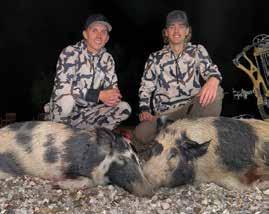
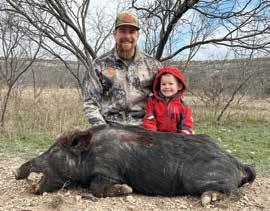

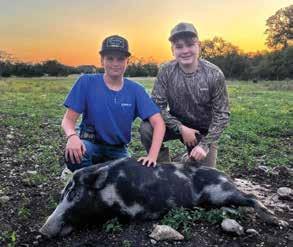
hogs, wild boars, razorbacks, wild hogs, and many other names. They come in a variety of colors and patterns, but regardless of the name used, they are all part of the same species: Sus scrofa. The species includes Eurasian wild boars and domestic “feral” pigs.
A review of the literature shows the wild hog is a highly adaptable animal, as shown by the diversity in new habitats. These animals have thrived and are able to quickly establish self-sustaining populations. Their ranges have expanded dramatically from their original introduction locations and have had some help from humans, too. Wild hogs have been hunted in Europe for centuries, and when the feral hog switched from a livestock classification to a nuisance animal classification in the United States, hunting interests became more popular in Texas.
Hog hunting became so popular in the 1960s that feral hogs were trapped and transported to new locations in Texas to provide additional hunting opportunities. These transportation efforts allowed independent populations to rapidly grow, and greatly expedited the

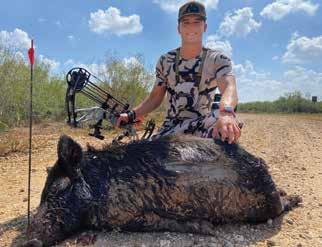
range expansion of feral hogs. Most of the movement of wild hogs has occurred to supplement deer hunting, but Russian (Eurasian) hogs were sought early on to control rattlesnakes, and later for hunting with dogs.
Over my 20-plus years of being a hunting summer camp director and outfitting hunts all over the state, I have seen a change in how people hunt and the gear they use to hunt these animals. In my early years, it was as simple as going to the deer stand and killing a hog in the last 30 minutes of daylight. That method went on for years, but as they learned our habits, we had to start using spotlights and hunt into the night to kill a few for the grill. It never seemed like we have too many, but they can be deceptive, as their numbers far exceed what you think you might have on a property.
Hunting is a good way to help keep their numbers down, but over time we moved to trapping the hogs to help control their numbers. The traps are very effective, but after a while the old swine shunned the pens, so we had to get even more creative ways to hunt and control the hogs.


For a while, we used lights on our riflescopes that would shine out to 150 yards or better. We then started attaching lights to the feeder so the pigs could get used to eating at night under the neon moon. In the last few years, we have been purchasing suppressed rifles with thermal scopes to take hog hunting to an all-time level.
The hunters who hunt with us have put in the time, research, and money to tackle the hogs in Texas, and we’re very happy for the help. If we did not have guys come out to shoot the hogs each year, there would be no way we could keep things somewhat manageable. Even at that, most of Texas is overrun with hogs and landowners use helicopters to kill hundreds to stop the infestation.
I’m well aware hogs cost millions of dollars each year, especially for crop lands, fences, and landscaped areas. I’m trying to do my small part in helping with the problem where we can, and we’re always looking for new places with opportunities to hunt them. I have found it much easier to “pay to play” on the ranches so we can have everything ready and optimal to make sure we kill a good number of pigs.
We spend weeks and months in advance of a hog hunt

prepping the areas and congregating the hogs. We limit our time to prevent too much human scent in the areas, so the hogs won’t be alerted to our presence. We spend thousands of dollars on feed, timers, batteries, lights, food, electricity, and lodging to have a place ready for a hunt. It’s a lot of fun and very challenging, especially in the Texas Hill Country where we have rocks on top of rocks.
The kids at our 2024 summer camps have already unpacked and used their gear, and have been spending quality time in God’s great outdoors. A good number of kids have been targeting wild hogs as their trophy and also as their contribution to the wild game dinner on the last night of camp. A well-prepared hog on the smoker is hard to beat, and feeding 40-plus people a wild game dinner takes a lot of quality meat. As you start looking at your calendars and would like to get outside, you might think about going on a hog hunt.
Michael Marbach is the CEO of the Christian Outdoor Alliance: mycoa.org; 210-827-9802. COA’s mission is to guide youth and outdoorsmen to a relationship with Jesus Christ through experience in God’s great outdoors.

Each year during the month of August, deer hunters of all ages from Texas, Mexico, and out-of-state, bring their bucks to the Hunters Extravaganza Annual Deer Competition in Houston, Fort Worth and San Antonio. Young hunters proudly enter their trophy—sometimes their first buck—hoping to win a prize. TTHA is proud to recognize some of these young hunters and their trophy bucks.

Case Summers is a tenth grader who lives in Granbury, and is a bowhunter, par excellence. Case won first place-Out of State category at the Fort Worth Extravaganza Annual Deer Competition in 2023 with a big eight-point taken in Kansas. He has entered four bucks in the Fort Worth show, placing all four, and winning first place two times. He is definitely a Trophy Hunter of Tomorrow.
Case got his first buck with a crossbow at age 6. Since that first buck, he has taken five more with a crossbow, and his last six have been taken with a compound bow. To be sure, Case is a regular Robin Hood with a compound bow, and has the trophies and awards to prove it. He has mounted heads, plaques, and belt buckles for his many 3-D shoots and deer hunts. Case won a belt buckle at an Extravaganza 3-D shoot that will knock your eyes out. As for deer in 2024, he says he is ready for the coming deer season.
Case has also won himself a belt buckle at an Extravaganza 3-D archery shoot. At right: Case with his biggest deer ever, taken in West Texas.

Case has been to South Africa on a sponsored trip by Zengala Safaris. He met a professional hunter named Nico, who guided him for gemsbok, impala, wildebeest and warthog— all taken with his compound bow. Case also wants to get a good mule deer, and also wants to go back to Africa for an eland and bush buck. Bush bucks are hard to come by.
For some time, Case has had three sponsors—Ozonics, Vanetec, and Tactacam—who work with him in his bow shooting, while he furnishes them with hunting experiences and commercial hunting photos. Ozonics is a scent elimination system; Vanetec is a product of arrow veins; and Tactacam produces trail cameras. Case is pro staff for Vanetec and Tactacam, and is field staff for Ozonics. All products influence archery hunting, and provide ways to “get-the-game.”
Case’s best buck came from Sterling County where he hunts and helps with deer management on the ranch. His
best buck—a 10-point—came from Sterling County, and won first place at Fort Worth in 2022. He does ranch chores (for money) and also helps with deer and other animals during the season. Sterling County is on the western edge of the Edwards Plateau, and has an arid, but productive wildlife habitat.
Other than archery, Case likes football and baseball. He will be a sophomore this fall at Granbury High, and he may have to get a stick to keep the girls away.
Case had some advice to young bow hunters—be patient; watch your noise; stay quiet, and be careful of your smell. He says a hunter should enjoy the hunt and keep hunting, even when you’re not successful or miss a shot. He also reminds all hunters that practice is rewarding when a good shot presents itself.
At 15, Case Summers is a rare individual when it comes to bowhunting. I’m sure he would tell anyone that it takes practice, patience, and the desire to “go again.” We salute Case as a Trophy Hunter of Tomorrow, and hope he gets a big ’un this deer season.



On Robbie’s second trip to South Africa, he finally got his kudu. STORY

The great outdoors and hunting wildlife has been one adventure in my wish list since I was in my teens. I tasted the thrill of spotting my prey for the very first time in my late 60s, which was rather late in life. A friend invited me to hunt in his 50-acre property in Central Texas. I did not have any formal training or coaching on how to hunt. I relied mostly on the internet for knowledge about hunting. I bagged a doe and a six-point buck that I shot with a .270 Sako I borrowed from my host friend.
I felt success and ecstatic with my very first hunt in my life. I wanted more challenges this time and wanted to take other types of species. I attended the 2018 Hunters Extravaganza in Fort Worth and signed up for a 2019 hunt with an exhibitor from South Africa.
In my May 2019 South Africa hunt, I took my first set of four African antelopes: waterbuck, blesbok, impala and gemsbok, with a .300 Win. Mag. But I failed to get a kudu, which was in my bucket list for that hunt. I met some wonderful people on that safari from Lindale Heritage Safaris Private Reserve of Eastern Cape. They invited me to represent them in the U.S. This brought my interest in hunting to a much higher level, and thus far, we have exhibited in three consecutive Hunters Extravaganzas.
My second hunt with Lindale was in May 2022. I was determined to get a kudu this time. The first day was devoted to sighting-in the .300 Win. Mag. Thereafter, Antony—my professional hunter extraordinaire—and I surveyed the 5,000-plus acre property and saw impalas, nyalas, Cape buffalos, zebras, waterbucks, warthogs, wildebeests, ostriches, and giraffes, but did not see any kudu.
On the second day we drove the hunting vehicle through rugged hills and slopes and decided to stay in a dug-out ground blind, tucked within trees and bushes. Across from us was a small clearing with a water source. In previous days, kudus were spotted in this area coming
for a drink. Baboons were playfully entertaining us, and we saw some nice nyalas.
After four hours of waiting, we did not see any kudus and decided to head to the guest lodge for lunch. On our way out, a bushbuck ran across our path. After going a few yards, we had our first sighting of an elderly kudu bull all by himself. I was eager to get him, but Antony told me, “There are better trophies than this.”
On the third day we drove to a vast, wide plain, which was surrounded on both sides with mature trees and bushes. We sighted herds of blue wildebeest, eland, impalas, zebras and warthogs. The locals call this area their “Little Serengeti.” From 500 yards, all these majestic animals were peacefully grazing. What a sight to behold. It felt like I was watching a National Geographic film.
Among the variety of herds was a big 9-year-old, 600-pound zebra mare that seemed sick. We stalked closer at 200 yards and confirmed this animal was indeed sick and moving slowly behind the herd. Antony convinced me to shoot the zebra. I fired a frontal shot to the chest and the animal wobbled for about 75 yards. I fired a second shot on the left side, which dropped the zebra mare to the ground.
At 3 p.m. that day we went back to the Little Serengeti plain and finally spotted a herd of trophy-quality kudu bulls grazing

with kudu cows. They were too far away to get a good shot. Instead, we took our time observing and prospecting for the potential kudu bull trophy.
At 10 a.m. on the fourth day we went back to the Little Serengeti and fortunately saw the same herd of grazing kudu. Three adult kudu bulls were in the herd. Antony decided to drive to the opposite side from where we spotted them to get closer and take cover by the trees and bushes behind the herd, grazing in the field.
Upon reaching the desired area, we got off the hunting vehicle and started stalking. Upon reaching 225 yards away from the herd, Antony set up the shooting sticks and mounted the rifle. From this vantage point I could get a good shot of a mature kudu bull, whose head and half of his body were in clear broadside view without any tree branch cover. I could see through the riflescope that the bull seemed to look towards our direction.
Waiting for a good broadside shot seemed like an eternity. The moment came, then Antony gave me the signal to shoot. My crosshairs were pinned on the kudu’s left shoulder. I said a short prayer and squeezed the trigger.
After the shot rang out, Antony, who was looking through his spotting scope, shouted, “Good shot, Robbie!” I felt relieved and extremely joyful with that confirmation. I finally took a very
nice Eastern Cape 11-year-old, 550-pound, 46-inch kudu bull, which dropped at 40 yards from the kill spot.
On May 16, 2022, at 3:10 p.m., which my last day at the reserve, Antony and I were scouting for some good trophies. We saw several species, but he spotted and chose two nice nyala bulls grazing by the edge of a hill. This time I decided to hunt with my Mathews V3 compound bow with Victory VAP Elite Arrow and Iron Will wide series broadhead.
Seated in the bed of the truck, Antony signaled for me to get off the vehicle. I cautiously got off from the back of the truck. Both bulls, which were of the same size at 250 pounds, kept on grazing. I used the hood of the truck as my cover.
I drew and released my arrow at 35 yards and hit one bull that gave me a shot opportunity on the left side with a pass-through quarter shot. I picked up the arrow, which I smelled and revealed a gut shot, had passed through the opposite lung, as the blood trail proved it was indeed a lung-shot. The nyala ran up the hill through very dense trees, bushes and vines.
Due to the thick vegetation, we had to crawl on our hands and knees. Tracking and recovery was slow, which took about an hour, including dragging the trophy down the hill. After taking pictures we headed back to the lodge. A most gracious and very hospitable owner-host Peter Amm opened a bottle of champagne to celebrate because this was my first-ever bow kill.
Words aren’t enough to describe the kind of hospitality at the reserve. The other hunters in our group attested to the brand of hospitality, cleanliness, and well-planned hunts. This hunt is an adventure I will never forget. I am going back next year and plan to take a Cape buffalo with my bow.


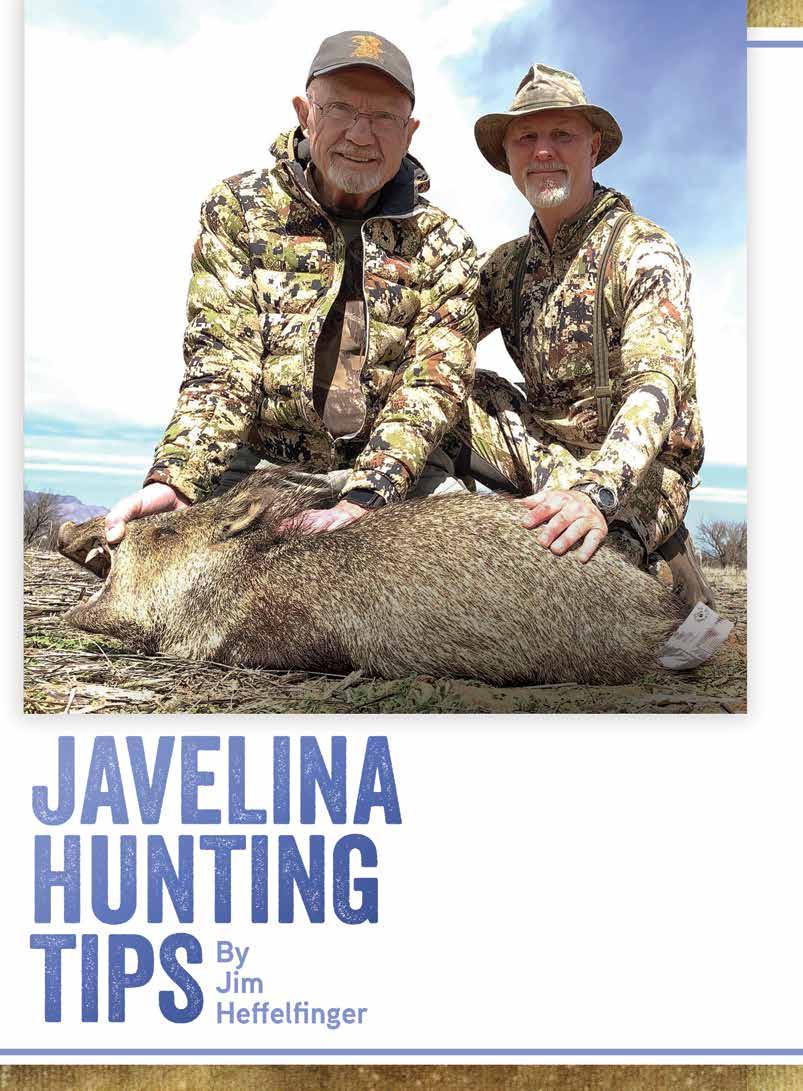
Javelina have always drawn a certain amount of curiosity from resident and non-resident hunters alike, especially those less familiar with this interesting southwestern dweller. What is not to like in a native pig-like critter that ekes out a living in dry, cactus-dominated Southwestern landscapes? They’re incredibly interesting native animals that can be hunted at times when other big game seasons are closed. What other hoofed big game animal do you mount with its mouth open to show its huge canines in a menacing way? Unfortunately, javelina are not revered and respected everywhere and are sometimes considered more of a nuisance than a coveted big game animal.
Arizona Wildlife Federation, Safari Club International, and Texas Wildlife Association include javelina in their records book categories by using the total measurement of skull length plus width, as is done for bear and lions. The Boone and Crockett Club has not yet included javelina in their records, but they’re discussing adding them as we speak.
Javelina meat is criticized by some as not tasting good, but if properly cared for in the field, it provides good eating. The key is to field dress the animal immediately and skin it at your first opportunity to cool that meat down. Don’t worry about the scent gland on the lower back above the tail. It’s embedded in the skin and will come off cleanly when you skin the animal. But, the hairs of the javelina are covered with this skunky scent so make sure you do not touch the meat with the hand that has been touching the hide.
Much maligned for their lack of intelligence, the javelina is not any less intelligent than our other native wildlife. They
cannot reliably differentiate between males and females and the young are adult sized by 1 year of age. These herds live in a defended territory about 1-2 square miles in size.
Herd boundaries generally touch each other so herds are packed in like adjacent bubbles across the landscape. This means javelina are literally everywhere in good habitat, but that doesn’t mean they’re easy to find. Knowing how javelina feed and what signs they leave behind is the key to successful javelina hunting.
Successful javelina hunting is all about finding fresh sign like this rooting and then staying in the area until you find those who made it.
Javelina spend most of their time resting and feeding. Resting occurs primarily in traditional bedgrounds which are located in low areas of thick brush or caves throughout their territory. These bedgrounds offer soft soil to lay on and protection from predators, the sun, and the weather. When feeding, javelina concentrate heavily on succulents such as prickly pear, pincushion cactus, barrel cactus, lechuguilla, and cholla cactus. The fruits and fleshy parts provide not only nutritious feed, but water as well. When javelina feed on prickly pear pads they grasp the pad and pull, which shreds the pad and leaves the stringy interior fibers visible.
Small cacti, such as pincushions, are knocked over with a front hoof and the insides are eaten out so that only the tough outer skin and spines remain. Lechuguilla leaves are pulled apart and left scattered as the javelina eats the fleshy heart out of the plant. Roots and tubers of plants and cactus are also dug or “rooted” up by javelina on occasion. Besides shredded prickly pear, scooped-out pincushion cacti, scattered lechuguilla leaves, look for bedgrounds, droppings, tracks, and rooting activity. While in javelina habitat, you should also be looking for good glassing locations and trails that will lead you through some good-looking habitat with minimal disturbance.

simply evolved in a different environment. Their eyesight is poor at distances greater than 100 yards because in the thick thorn scrub they never needed to see any distance. Their sense of smell and hearing abilities, however, are very well developed. Javelina travel in herds averaging 8-12 individuals. You
Javelina hunting in South Texas is different than hunting with spot-and-stalk methods in more open country from West Texas to Arizona. In thick brush country you don’t have much choice but to rely on open pear flats, senderos, or feeders. When hunting these open areas, the most important piece of hunting equipment is a pair of binoculars. The price of your binoculars is less important than the fact that you are using a pair. The expensive ones are better; they are clearer, more durable and reduce glare and eye strain.
Find a good vantage point where you can see a large canyon
or basin and then systematically search the whole area within view. The best way to search the area completely is with your binoculars mounted on a tripod. The tripod keeps your field of view completely still so you can see subtle movement of a javelina taking a step against the stationary background.
Plan to glass the sunny slopes in the morning and evening. These animals prefer warmer slopes in the winter months and it is also much easier to see them there. If it is rainy or windy, the herd will be found in low, protected areas out of the weather; concentrate on areas close to bedgrounds and near the bottom of the canyons.
Look for an area that is more than 1 mile from any road and in good javelina habitat. When scouting, walk into that area and look for evidence that javelina have been active recently. Also, always carry a predator call with you when javelina hunting. The herd serves as a defensive unit, protecting the juveniles from predators. A predator call simulates the squealing of a young piglet and sometimes draws the herd out to save the piglet.
There is a lot of luck in hunting, but there are things you can do to greatly improve your chances of being lucky. Here are my “Lucky 7” tips for finding javelina.
Be prepared: Spend a significant amount of time scouting and researching before the season. You can locate herds of javelina and start to understand their movement patterns.
Take your game sitting down: The old adage that a good hunter wears out the seat of their pants before the soles of their boots describes perfectly how much time you should be sitting behind your optics.
Look on the Bright Side: Always have the sun to your back. It not only prevents you from looking into the sun, it assures you will be looking at canyons and hillsides illuminated brightly.
Climb High and Lay Low: When spot-and-stalk hunting, you should climb as high as possible to get the best view and set up in the shade of a tree, bush or other structure. It is always
tempting to stop short, but for every 50 feet in elevation, more and more habitat down below opens up for your inspection.
Concentrate: In the real world, javelina are not going to stand out like a neon sign on the other side of the canyon. If you are not concentrating, you will miss javelina right in the middle of your field of view.
No Room for Random: When using binoculars, do not scan around willy-nilly hoping to spot a javelina. Searching efficiently and effectively means you search your visible area in a systematic way. A tripod is a must if you are serious about bringing home the bacon.
Come Early/Stay Late: If you want to be successful you have to make sure you are active during the same time periods as your quarry. Take advantage of the “Golden Hours,” the first hour after the sun up and the last hour of sun in the evening. Pack a lunch and stay afield all day.

Outside of the South Texas brush country, the most effective way to hunt


Feral hogs can be hunted without a license on private property and without any bag limits or limited means and methods.
The dog days of summer represent an important time of transition for Texas hunters.
The beginning of archery deer season is still months away, though whitetail lease and land prep is still top of mind for those looking to maximize their chances during the fall and winter seasons.
There also are plans that need to be put in place ahead of regular seasons for doves, ducks, geese, quail and even alligators.
For those seeking to continue their hunting pursuits, the prime quarry are the numerous exotic species and non-game critters that can be pursued all year long. This time of year also finds most hunters seeking out other game, notably species of the scaled kind, especially speckled trout, redfish and flounder across the multiple bay systems.
With that in mind, here’s a look at another exceptional cast and blast opportunity—“reds and rooters”—another mashup of hunting and fishing that can provide its own slew of thrills.
In terms of “rooters,” the quarry is feral hogs, the invasive species that has taken root in every county and continues to thrive despite hunters’ and landowners’ best efforts to snuff them out. A previous report compiled by Texas A&M University researchers that’s now more than a decade old forecast what we already know: no matter where feral hogs are found, they are winning the war. The state’s feral hog tally has more than tripled.
Wild hogs are everywhere despite trapping and other efforts that don’t put much of a dent into a breeding population that is prolific. The most glaring figure from the report was the reduction rate necessary to keep the population in check. Roughly 66 percent of the animals must be eliminated annually (predation, hunting, trapping, accidents, disease) to keep their ranks from growing.
A similar study from Texas Parks and Wildlife shows that
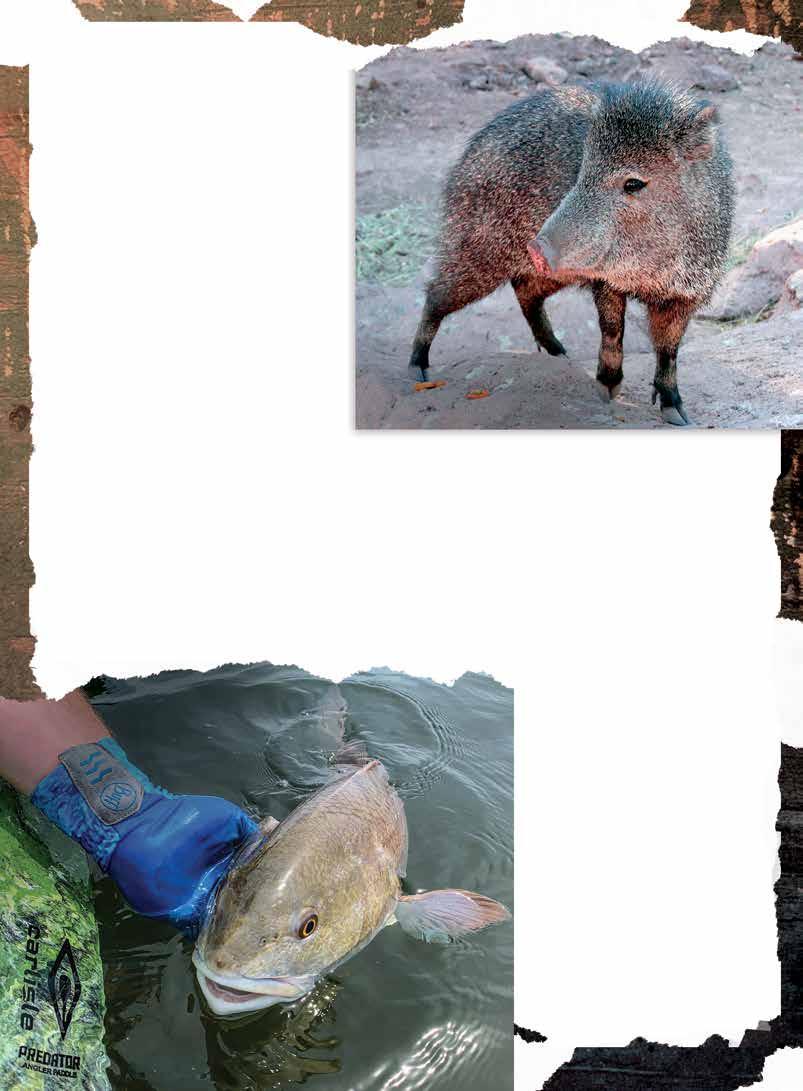
even as recently as 2010, researchers estimated that each wild pig carries a “damage” cost of $300 per year. That figure according to the U.S. feral hog estimates would equate to more than $2 billion annually, a massive hit to our native habitats and farmers’ pocketbooks. Of course, these estimates are at best “guesstimates” of actual hog damages, mostly in farming regions.
The lone positive when talking wild pigs is they have gained notoriety in recent years as more emphasis is put on hunters, and the quest to bring pigs from field to table. Some of the animals aren’t edible, based on size or condition, but most are downright tasty when cooked in the same ways as traditional farm-raised hogs.
The positive hunting aspect of wild pigs is that they can be killed in whichever way you prefer. In general, everyone who has feral hogs hopes you kill every one you see. As with hunting pursuits, the cost of hog hunting has risen. Guides and outfitters are looking to add any kind of profit to their bottom lines. However, if you play your cards right, there are opportunities to hunt on the cheap, if not outright “on the house,” if you can find someone who is tired of hogs on their farmland or ranch.
Pigs are a good way to introduce youngsters to hunting as it doesn’t require much work to get the attention of hogs. I can attest personally as one of my first “big game” experiences in elementary school was thinning out pigs at a local ranch near Brownwood. Any deer hunter knows that if you’re feeding whitetails where there are
wild pigs, then you’re feeding the swine, too. That’s tailormade for youngsters to up their hunting success rate.
Another “rooter” to consider pursuing may look like a hog but in fact is a different species. The javelina, aka “collared peccary” is certainly a striking critter, standing much smaller than a big hog at less than 2 feet at the shoulder, with adults weighing roughly 30-50 pounds. Javelinas can be found in other states in the southwest which have similar habitats as their favorite climate and vegetation of the Rio Grande plains.
Javelinas thrive in groups in mesquite and prickly pear habitats, and feast on anything from roots and fruits to worms and small invertebrates and reptiles. They have poor eyesight, providing a great chance for spot-and-stalk hunting with a variety of arms, including traditional archery gear and crossbows. Like feral hogs, they can sometimes be destructive to native habitat, rooting in search of food and wallowing in natural water sources. Javelinas love corn, and their feeding habits provide opportunities for setting up a successful hunt.
Javelinas do possess large tusks relative to their size, though they typically aren’t aggressive unless cornered, threatened, or females have young. Care should be taken when hunting javelinas. An incident occurred in November when a young hunter walked up on a wounded javelina which injured the arm of the young hunter with its tusk. After dispatching the javelina, the hunter received medical treatment for his wounds, and will no doubt be more careful when hunting javelina.
The annual javelina hunting framework in the southern zone that spans south and west of San Antonio runs year-
round (no closed season). I can say from firsthand knowledge that though javelinas are often passed up because of the pungent scent gland on their rear end, the young, gray animals are actually tasty with lean meat that doesn’t taste “gamey” if you clean them properly. Thin meat strips can be fried or grilled and tossed in a taco with tasty accoutrements for a fine field to table meal.
In the salt this time of year, the “rooter” is the redfish. Red drum are the water-dwelling “hawgs” along the Texas coast that can be caught in multiple ways and provide a fight unlike any other game fish. Piers and passes, jetties and Gulf of Mexico beaches are prime areas to find large numbers of big reds that will hit almost any natural or artificial offering in late summer and early fall.
The rooting aspect of these fish is tailor-made for another amazing fishing experience: sight fishing in shallows. Reds eat a variety of foods, with crabs and shrimp being their prime source of sustenance this time of year on shimmering coastal seagrass flats. Reds often will give away their position by rooting around in the sand and in seagrass, hoping to scare up a meal that’s hiding. This phenomenon also is known as “tailing” as a large fish’s back and spotted tail will sometimes stick out of the water as its hoovers over the critters below.
As a youngster, my preferred bait of choice was live shrimp under a popping cork, though cut bait also worked when simply anchoring up and looking to entice a hungry “bull red.” Nowadays, once you fling an artificial bait at a fish you can actually see, whether it be a paddle-tail plastic, gold spoon or even a fly imitation, you’re hooked for life once you catch a red with that fishing tactic.
The tackle box for redfish only needs a handful of timetested fish-catchers. The No. 1 artificial should be a gold spoon. I’ve caught big reds on other colors, including silver and multi-colored fish pattern imitations, but the gold version just seems to be the best! Another go-to artificial are plugs imitating mullet and other baitfish that can be fished as top-waters. Should you be lucky enough to get a top-water bite, you may never see anything like it again, and big bull reds busting on top is a sight to behold.
As you can see, it’s prime time to “take root” up and down the coast and into the brush country!
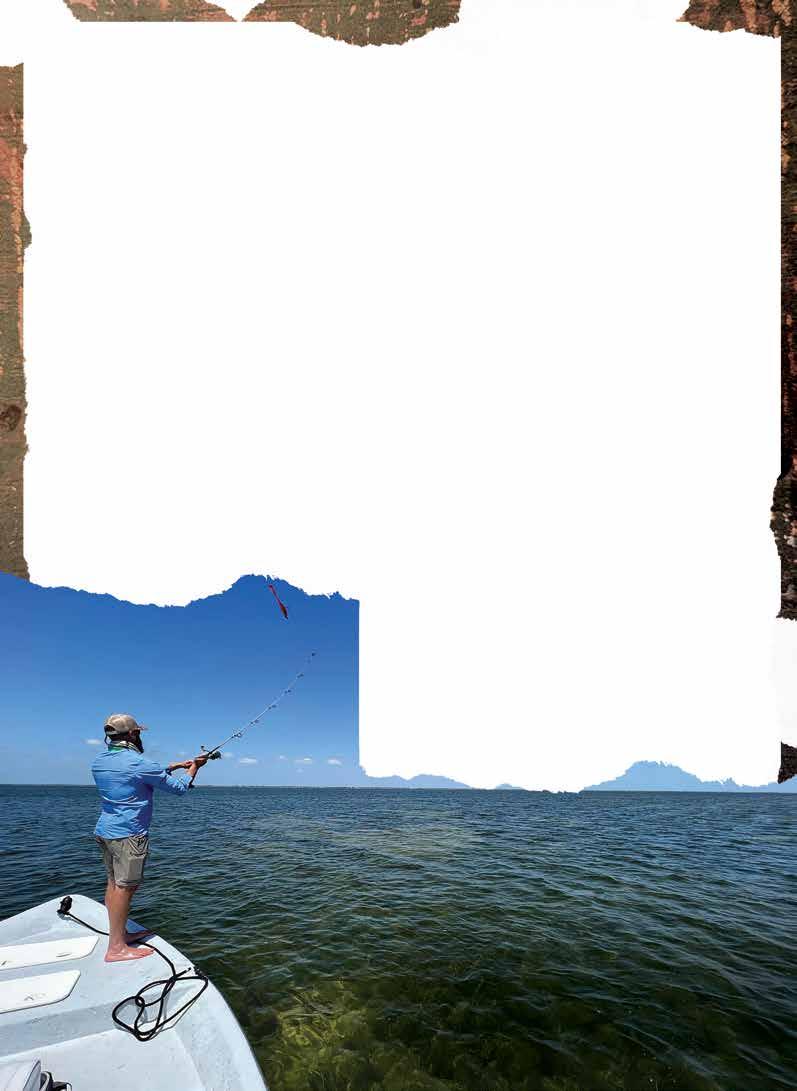
Sight fishing for redfish is among the most exciting “hunting trips” one can make to the Texas coast this time of year.

David had a mission to not only take an Alaska brown bear, but to face his own fear.

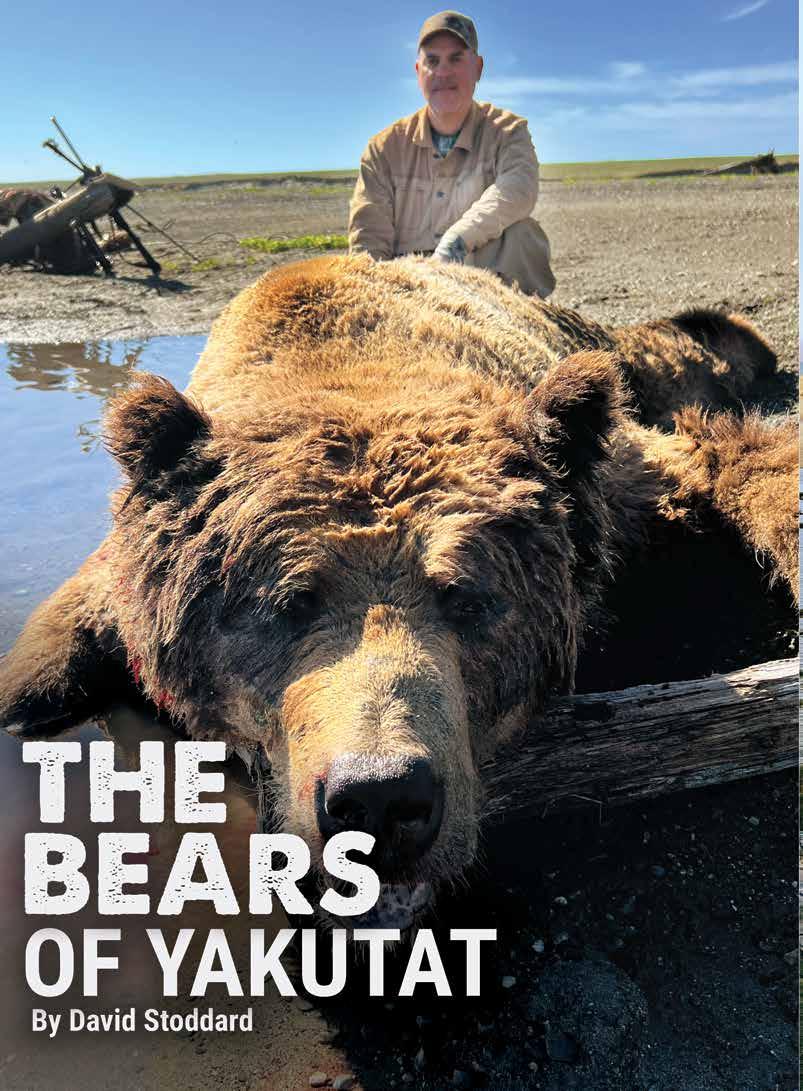
Iwas awakened by the dry crack of a branch by a heavy animal. My attention was transfixed as I realized something very large was circling our two-person tent. My friend was sleeping soundly as I tried to wake him in vain. When fur lightly touched the nylon rain fly near my head I felt electrified. I clutched my Buck folding knife in my right hand with all the determination a 13-year-old could muster.
That episode in my young life set the stage for coastal brown bears in May 2023. Although the memory that night was caused by a black bear in New Mexico, it had instilled a sense of danger regarding bears. I hoped to eradicate this feeling with a brown bear hunt in Alaska.
The desire to hunt the great bruins meant more to me than just trying to attain a fine trophy, or even check another item off my bucket list. I knew that by going head-on for a big brownie, I would be facing more than just 1,000 pounds of teeth, muscle, and claws. I would be facing my own fear.
Daniel Boone is quoted as saying, “Fear’s the spice that makes it interesting to go ahead.” I contemplated this idea as the single propeller Beaver took flight from the Yakutat airport. I could see the ocean, rivers, and trees—many trees and evergreens.
I was accompanied on this hunt by guide Will Kelner, and outfitter Joe Letarte of Alaska Wilderness Enterprises. Will and I donned our 50-pound backpacks and started the four-mile hike to the remote cabin that would be our base camp for the next 10 days. The plan was to hunt three or four days near the cabin, and if unsuccessful, Will and I would relocate to a spike camp several miles away.
The hike to the cabin was exciting because I did not know what to expect. We sighted our first bear near the cabin, which had no electricity or running water. However, it had a wood burning stove for warmth and propane stove for cooking. Outside the cabin we had a hand-crank water pump and a privy.
The cabin was situated near the confluence of three rivers that flowed into the Pacific Ocean. There were many bald and golden eagles, and tracks everywhere—wolf, moose, and bear. In fact, there was a well-traveled trail right in front of the cabin.
After Will and Joe made it back from the plane with the gear, we got organized for the ensuing 10-day hunt. Will and I did some scouting and verified zero sighting for my rifle. Because we were not allowed to hunt the same day we flew in, we scouted for bears and did a little fishing. We spotted a sow and large cub about 175 yards away. After we got back to camp, we ate dinner and discussed the plan for the first day’s hunt, which appeared promising.
On the first day, Will and I glassed a flat where the river overflowed its banks. There was fresh green grass, and we saw four bears and we stalked to within 100 yards of one bear. I placed my rifle on a log and watched the bear through my scope. After watching the bear for several minutes, I found myself settling in and becoming more confident near the large animals.
The next day we hiked about 4 miles out and glassed a river clearing. Will spotted a decent boar, but decided to just watch. We spent the entire day glassing before heading back to camp. As usual, we ate dinner and talked about the day. We were in our sleeping bags by about 10 p.m.
The morning of May 16 marked our fourth day at the cabin.
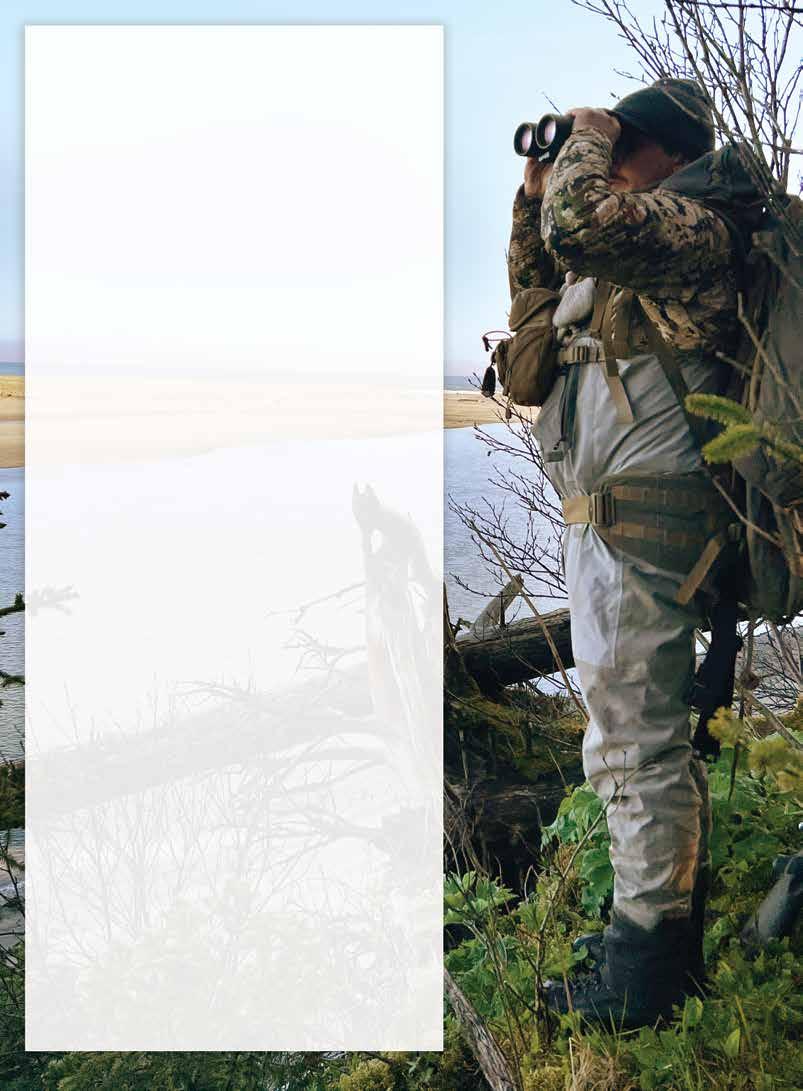
David’s guide, Will Kelner, scouting near the water.
Will and I hiked about a half-mile from the cabin and glassed near a river. As we were glassing, I noticed a rather rare weather phenomenon known as a cloud rainbow, and snapped a few pictures. I was enjoying the great weather, which was unusual.
Later we crossed a fast-flowing river and climbed a high point of land full of Devil’s club and thick stands of evergreen. While glassing from this spot, Will saw a bear that was fishing not far away. He said the bear was small and not as large as some of the others we had observed.
We had seen 10 bears by this time. Although they’re all large, there’s a noticeable attitude and swagger with the larger boars. The point we were glassing from is right where the three rivers meet before flowing into the Pacific Ocean.
We glassed for a few hours, taking turns crossing a high point of land to check another river. Will had just gone to check the river when he came back in a hasty trot. I could tell that he had

seen something big, because he had not shown any excitement in the hunt.
Will said, “Grab your gun. Big bear!” I got my rifle and followed him to the lookout point. What I saw across the river will be etched in my memory forever—a bear as big as a furry TANK! Time slowed to a crawl as the huge beast crossed the river toward us. He appeared to fear nothing as he climbed up the riverbank.
Will interrupted my thoughts with the words, “22 yards.” I placed the crosshair of my scope on the bear’s right shoulder and squeezed the trigger. The blast from my .416 Remington was deafening, as the bear was immediately knocked off his feet in a spray of water. Will and I both fired nearly simultaneously while he was spinning. The boom of Will’s .375 Ruger going off near my left ear was difficult to describe.
To my surprise, the wounded bear regained its feet, made eye contact with me, and charged. This was my moment of truth. I found the bear’s head in the crosshairs of my scope and touched off

a 400-grain bullet. The huge animal collapsed in the cold water, and Will said something unprintable followed simply by, “a head shot!”
My adrenaline had spiked, and I was overcome with emotion. I was elated, relieved, remorseful, and content all at the same time. Will and I went down and pulled the bear to the bank of the river.
Will went to get Joe to help with the skinning. The combined strength of the three of us could barely roll the animal to the water’s edge. We got the bear skinned and I cut the backstraps out to take home. Joe told me I would not like the meat, but I was determined to try it. We got everything into a canoe and I towed it back to the cabin. Joe estimated the bear skin to weigh 150 pounds.
The next day was spent fleshing out the hide and the skull. We took many pictures and retold the story of the hunt several times. The rest of the trip was filled with fishing. I caught a 23-inch Dolly Varden, which we cooked and ate. I also caught and released many rainbow trout. Some of the trout I caught were 17 inches. It was a fantastic trip.
The last day, I stood in the river when a bald eagle flying overhead landed in a nearby tree. Its piercing calls reverberated in the air around me, then everything went quiet, except the sound of the stream. Blue sky and warm sun surrounded me as I enjoyed one of the last untouched areas left on Earth. I looked up and gave thanks for this life and all its blessings.


Yes, Mexico is beautiful. Many head for Mexico’s famously sunny beaches when it’s dead-of-winter in the United States. Acapulco, Cancun, Puerto Vallarta. I get sunburned when the moon is full, and I am not a beach guy. Instead, my winter break will likely take me to northern Mexico’s outstanding hunting destinations. Whether your thing is upland game, waterfowl or big game, northern Mexico is marvelous, and our winter months from December through February are the perfect time to go. There are good opportunities across her northern tier, from Tamaulipas to Coahuila, Chihuahua, Sonora and the Baja Peninsula.
For me, mid-winter is convention season. When it’s over, I need a break. Our amazing convention in Nashville wasn’t the last show of the season, but it was the last for me. I love them, but there’s such a thing as too much of a good thing. This year, our gathering and Grand Slam Club/Ovis made five January conventions in a row, not counting a week fighting the inevitable convention crud. As soon as I made my way home through winter storms, I repacked and headed for Sonora.
Many folks must have had the same idea because the flight from Phoenix to Hermosillo was packed with hunters. Naturally, we chatted while waiting to board, on the plane, and through baggage claim and customs. I didn’t take a gun this time, but

there was a major stack of gun cases to be cleared.
Now, I was curious. I’ve been fixated on hunting down in the Yucatan for the last few years, but I hadn’t been through Hermosillo in quite a while. Sonora probably has northern Mexico’s greatest density of outfitters and hunting ranches, with Hermosillo as a major hub. Everybody must have had their Mexican firearms permits handy (and proper) because that line moved quickly, and the police were friendly, professional and fast. I was far back in the line to get my passport stamped. It took a half-hour, and by the time I got through and picked up my bag, most of the hunters in line ahead of me were already cleared with their gun cases and had left.
Several guys I chatted with were hunting waterfowl near the Sea of Cortez coast. Most were there for the same reason I was: desert mule deer or Coues deer. By northern standards, February is late for deer hunting. Most seasons are closed, and the rut is long over. In Sonora, the deer rut is late. Deer season runs deep into February, and bucks chasing is evident until the end.
It’s winter there, too, but winter in the Sonoran Desert isn’t the same as winter where I live in the United States. It was chilly at night, just right for a warm mesquite fire. Cold in the morning, usually warming quickly under bright sunshine. Layers came off by mid-morning. In some ways, northern Mexico reminds me of the African winter. So does the hunting. No buffalo or kudu, not quite the variety, but the feeling is similar. When you head out in the morning, you don’t know what you might see. Coues deer or desert mule deer, a pack of javelina, a coyote slinking along, maybe some desert bighorns on a distant ridge.
As with all hunting, some days you see little. On other days, animals are on parade. Usually, we don’t know exactly why, other than the obvious: No two hunting days are alike. My first couple of days were slow, and this time, I knew exactly why. Did I mention that warm Sonoran sun? It stayed hidden behind unseasonal clouds. Heavy rain hit a day before I arrived. A blessing in the desert, but not at the moment. There was lots of water out in the brush. Desert animals like the warm sun just as much as we do. It’s no surprise that not much was moving.
Hunting is always a learning experience, and this ranch offered new lessons for me. In the past, I have always expected to find mule deer on the desert floor and Coues deer by glassing at higher elevations. Here, we saw deer of both species up on the ridges, but there were more mule deer down low, as typical. The many Coues whitetails we saw scampering through thick brush on the flats was a big surprise.
Desert deer don’t require surface water to survive, but Buelna, historically a cattle ranch, had unusually well-developed water points. In the ’80s, I was told, “Desert deer don’t come to water.” That is not true there. Trail cameras show mature bucks of both species coming to water. Coues deer, more than desert mule deer, were loosely concentrated around water. It is so obvious that a productive tactic on this ranch is to wait at waterholes on sunny days.
The week before I arrived, a hunter from Spain took a giant Coues buck. Very non-typical, it will be difficult to measure. It needs to be because it may be the largest Coues buck ever recorded from Mexico. Andrés showed me exactly where he was taken. Way out on a flat, far from any hills, but water was nearby. A distinctive buck, he had been seen in that area twice. More interesting, one of the cowboys picked up his previous year’s shed about 500 yards from where he was taken.
Because I was there primarily to look for a big Coues deer, the presence of such a buck was good news. His recent demise was not a train smash. I held that amazing rack and looked at the worn teeth, a minimum of 8½ years old, and lots of sons and grandsons out there. Despite poor weather the first couple of days, we saw several small to medium bucks.
I joined a father-daughter team, Bryan and Braylin Flanagan, SCI members from northern California. Like me, they had tough sledding under gray skies, worsened by the chill breeze. Another Mexican friend, Adrian Chahin, joined us at the tail end. Adrian owns Nic Te Ha ranch in Campeche, where I hunted tropical whitetail years ago, and we have since hunted together in Yucatan. He’s a good guy and an exceptionally experienced hunter. He needed a Coues buck to complete the

Hubert Thummler award for all the Mexican deer, a very tough goal.
Well, the weather was bound to change. Adrian’s timing couldn’t have been better. He missed the gloomy skies and all-day chill, or maybe he brought warm Yucatan weather with him. On his first day, the Flanagans’ last, the skies cleared, and the sun came out. The kind of winter day Sonora should develop. Bryan and Braylin scored a rare mixed double. Braylin taking a Coues whitetail, not just a last-day or first Coues deer, but a fine buck for anyone, and Bryan, who shot a good desert mule deer just an hour later.
Earlier that same day, Andrés and I ran across an ancient, heavy-racked, big-bodied desert mule deer buck. He had never been seen before. With the season winding down, he is unlikely to be seen again. I was not there to hunt mule deer, but sometimes you should take what the desert offers. That afternoon, the Flanagans made it an exceptional three-deer day. The next day, my last, with perfect weather continuing, Adrian completed his “Hummler” with a fast and brilliant shot through the brush at a beautiful Coues buck.
Under clear desert skies, at last, deer were on parade my last two days. Desert is desert. Wildlife densities are low, and, as Jack O’Connor said of Coues deer, “Even where there are lots of them, there aren’t very many of them.”
Collectively, I lost count of Coues deer bucks sighted, maybe three dozen: fewer mule deer bucks, and a couple of dandies. I saw two exceptional Coues bucks, and Bryan saw a monster. The one I saw was just a quick glimpse in the thick brush, impossible to judge, but it sure looked big. Bryan’s buck and the other big buck I saw were chasing does. He was plenty big enough, but he didn’t stop for a possible shot.
Not getting the shot was not a problem; it’s nice to know they’re there. There will be other post-convention breaks in years to come in Mexico, Lindo.
Editor’s note: Story originally published in the April 2024 edition of Safari Times

My type of hunting lately has been through a camera lens for G2 Ranch, taking photos for their clients or for the ranch itself. I thought it would be another early November morning sitting and taking pictures in the “Bobcat Pasture,” waiting to see if an addax, sable or gemsbok would give me a chance at a photo, but something else caught my eye. Along came this axis buck with his head down low, following a doe out of the thick mesquite brush. He was unique with a slick antler on his right side, so I quickly used my binoculars to
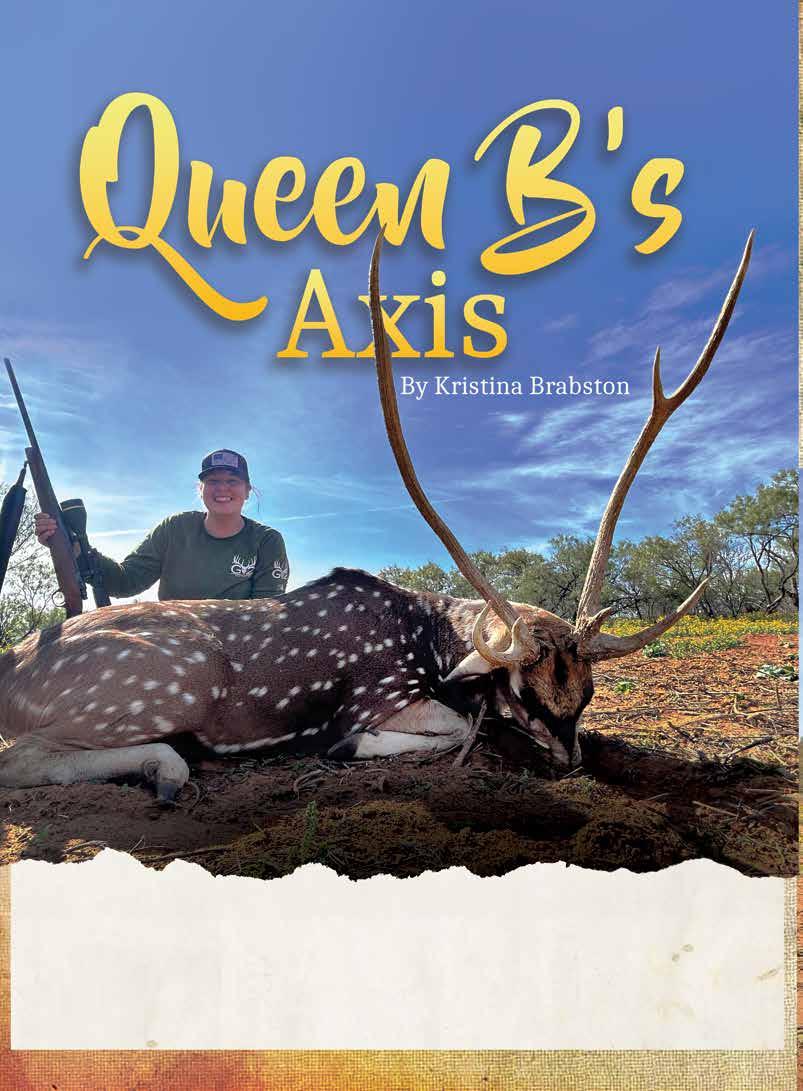
get a second look at him.
He was an older buck—due to the coloring on his face—and he seemed like he ran the corn feeder, pushing everything out of his way. He also had extra points that came from both sides of the antlers. I hadn’t seen anything like this before and now the image was stuck in my mind.
I finally got out of the blind and continued to look at the image I had of this axis on my phone. A few days later, Thanksgiving came, and it wasn’t until the following week when every-
thing went back to the normal hunting schedule at the ranch. On a Wednesday afternoon, the ranch had Christina Pittman and Laird Hamberlin from Texas Trophy Hunters come visit. Christina and Laird sat with Brock Wright, Don Gilchrist, and me around the table, asking about how the season and family were doing, then the topic turned to hunting.
I quickly told everyone about the axis I saw the previous week and that I hadn’t been able to stop thinking about him. I showed everyone the picture on my phone and told them I felt like I had buck fever when he appeared. Don looked over at me from across the table and told me, “Let’s make a deal and you can go get him.” I don’t think I ever perked up so fast at those words before. We shook on it and my game plan started in my head.
I had figured out I would go that weekend if hunters were done with their hunt, and see if the axis would make an appearance. Saturday came and the hunters were all tagged out, so the pasture was clear to use. This would be a different style hunt because my dad or my husband Cody wouldn’t be sitting in the blind with me.
I talked to Sergio, one of the guides at the ranch, and he volunteered to go with me in the blind and see what comes out. That evening not a single axis showed up to the feeder. Once

we got back to the lodge, another guide, Scott, came up and asked how everything went and helped us develop a plan for the morning.
I woke up at 4:30 in the morning, dressed in my 50 layers to stay warm, shedding them off throughout the day, then headed out to the blind again. We had axis come out this time, but we noticed some bucks had started to shed their antlers. Panic instantly entered my mind, thinking my chances of getting this buck were far gone. We went back to the lodge, Sergio went to help his clients, but I thought I should go drive through the pasture to look for the axis.
I noticed an axis herd going towards a section of brush where they like to hang out in the middle of the day to stay cool. I parked the truck and made my way with my shooting sticks and rifle in hand towards them. I got the gun set up and started glassing through the brush to look for him. My heart stopped when I saw him walking towards an opening.
I got comfortable behind the scope and slowly moved the gun off safety. As I got ready to pull the trigger, a whitetail ran by him with his tail up in the air and made the whole herd run. I started a group text with Cody, Sergio and Scott sending out a SOS on what they should think I should do. Cody’s text said, “My boys will help you.” Sergio and Scott said to meet them at the lodge in 10 minutes—they had a plan.
Pulling up to the lodge we got a safari truck and headed towards the skinning shed to grab a couple things. Tristan, Brad, and Foster asked us where we were headed. Sergio and Scott both said, “We’re getting ‘Queen B’ her axis.” So now I had five of the best guides on the ranch in the truck making a line towards the pasture to get this axis on the dirt.
Scott and I ended up getting off the truck and stayed by a mesquite tree. I had my gun resting on sticks, watching the axis move on the opposite side of the field. Sergio, Tristan, Brad, and Foster worked their way around pushing the axis our way. Soon, Scott and I were completely surrounded by axis. We were stuck in our spot for 45 minutes to where I started losing feeling in my back leg and Scott was going to fall over from being in a squatting position.
I was getting nervous about not being able to feel my leg. I whispered to Scott, begging to move my foot, and I think it was the first time that I heard Scott ever get that angry at me, saying, “You better not move an inch.” Another 20 minutes went by and out of the corner of our eyes came the axis. He walked right out, then stopped right behind a mesquite tree to lay down.
I slowly looked down to see Scott slowly creeping his arm to reach for his phone to call the boys to whistle to see if that would scare the axis to get up. After the third time of hearing different whistling styles and holding back laughs, the axis stood up and moved to a section of cactus. I moved the gun off safety, slowly pulled that trigger, and watched him drop right in his tracks.
Scott yelled, “He’s down! You got him!” while I jumped up
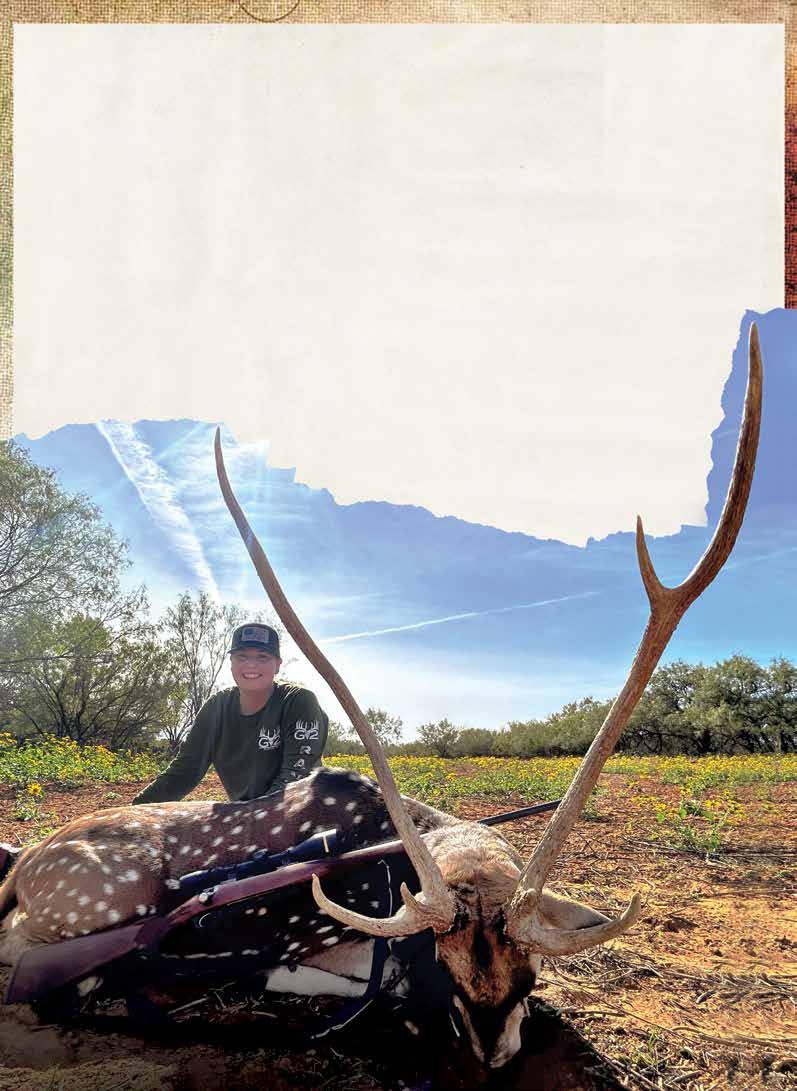
and down with tears running down my face. Sergio, Tristan, Brad and Foster also yelled in the distance, celebrating. We waited for them to bring the truck and made our way to the axis. It was like I never shot anything before because I couldn’t stop shaking and never expected my first axis hunt to go like this.
I made my first phone calls to my dad and Cody. They both mentioned how I must have been a lot of work because I needed five guides to help me. Christina and Brock came to check out the buck we just talked about on Wednesday afternoon.
We took loads of pictures, told stories of what happened, and had a victory beverage to celebrate. You couldn’t wipe the smile I had on my face. I felt truly honored to take this axis. He ended up scoring 33½ on his slick side, which surprised me because I wasn’t going for the size, I was going for the look.
We headed back to the skinning shed and started getting him caped and quartered. Normally you find me at the skinning shed on any hunt, begging for the guys to help pitch in. But this time it was my turn to do it on my own and I was handed the knife and got started.
I will forever be grateful to Don for the opportunity to take such a beautiful animal. For the five guides that made it their mission to make sure I would get to take my trophy pictures that day will now have a picture on my wall next to my mount. I’m also grateful to Dad and Cody for always fueling me with the outdoors spirit. The job I have as a photographer will hopefully lead the next hunter to get the same experience.






BY JOHN GOODSPEED
There is something for everyone in this roundup of the latest binoculars and spotting scopes. Want high-tech features? You got it with binoculars that can identify more than 9,000 species of animals and flying insects with the click of a button, another that calculates shot probability at various yardages and one more that uses a gyroscope to stabilize the image to allow hand-held binos to rival the magnification power of a spotting scope.
Of course, high tech comes at a price — almost $4,800 for the most expensive one. Want just a regular pair of binoculars? The least expensive is an 8X42 model that is a penny less than $60.
Then there are models that include a lot of optical tech that cover the middle ground in price.
Abbreviations in the article include ED glass, or an extra-low-dispersion lens that reduces chromatic aberration and enhances color, resolution, sharpness and contrast, especially in low-light conditions; HD, or high definition, meaning special coatings or lenses; and FOV stands for field of view at 1,000 yards.
Phase-coated roof prisms deliver truer colors, while multi-coatings on lenses increase light transmission. All are waterproof and filled with gases such as nitrogen to prevent internal fogging. Most carry a lifetime warranty. Prices are manufacturers’ suggested retail prices.
These budget-priced binoculars pack a lot of features including HD ED glass, phase- and silver-coated roof prisms and an eye relief of 15.2mm. The lenses are multicoated, and multiple antireflective lens coatings increase light transmission. The ergonomic design includes a large textured focus wheel. They are 5½ inches long and weigh 23.9 ounces. FOV is 340 feet. Close-focus distance is 8.2 feet. They also come in a 12X50 model ($229.99). Both models come with a padded neck strap and lens covers.
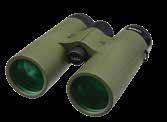
DTI 3/35 GEN 2, $2,699
While Zeiss’ latest binoculars, the SFL 10X30 and 8X30 (both $1,499.99) were introduced last year, the company did not unveil new binoculars or spotters for 2024. But a new family of thermal imaging cameras make a great choice for feral hog hunters venturing out at twilight or in the dark. New hardware pushes the boundaries of 384x288 sensors further while the new 1,024x786 AMOLED display improves contrast and color with sharper edges. The DTI 3/35 can produce images up to 1,422 yards away while the 3/25 ($2,499) goes up to 1,017 yards. Field of view at 100 yards is 78 feet. The digital zoom is four power.


The latest angled spotting scope also won’t break the budget. Features include ED glass, an ultra-wide-band coating for improved light transmission and a helical focus ring for fast, smooth focusing. The rotating body allows multiple viewing positions. Eye relief ranges from 19½mm to 18mm. FOV ranges from 102 feet to 48 feet. It weighs 69.8 ounces. It comes with a microfiber cleaning cloth, lens covers and a neoprene cover for storage and transport.
The new R5 and R3 lines will debut this summer. The other two in the R5 line are the 8X42 ($219) and 12X50 ($249). The two models in the R3 line are the 10X42 ($99.99) and 8X42 ($94.99). Both lines feature multi-coated lenses, EXO Barrier coatings to repel water, oil and dust, Diamond Tread on focus wheel and diopter, tripod adapter and Vault Lite Chest Harness. The R5 line includes an HD optical system, dielectric and phase coating on BaK-4 prisms, 88 percent light transmission and rubber grips.
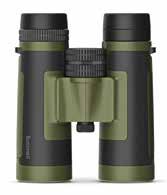

The latest binoculars from Celestron pack 15-power magnification, a 70mm objective lens and features including BaK-4 prisms and multi-coated optics utilizing Celestron’s proprietary XLT coating to increase light transmission and enhance contrast and resolution. It includes a tripod adapter and a Reflex Sight Ready (RSR) rail. A red dot finder scope allows fast location of distant objects. They are 10.9 inches long and weigh 51 ounces. FOV is 231 feet. Close focus is 49.2 feet. Eye relief is 17mm. It comes with lens caps, eyecups, rain guard, neck strap, carrying case and a lens cloth.
The compact Maksutov-Cassegrain design yields a sharper resolution at 39 power than conventional prism-based spotting scopes. Optional Celestron eyepieces can bring the magnification up as high as 180 power. The design includes both a lens and a mirror to provide images that are bright, sharp, high-contrast and virtually free of chromatic aberration. Built-in T-Adapter threads allow the addition of adapters for SLR cameras. The objective lens is 90mm. It is 15.7 inches long and weighs 74 ounces. FOV is 68 feet. Close focus is 15 feet. Eye relief is 20mm. It comes with an 8X21 finder scope.

Hexcore HD 1-3X Digital Night Vision Binocular,

Equipped with a 1280x720 CMOS digital night vision sensor, these binoculars deliver clarity while the 640x360 TFT LCD display enhances contrast. It can record HD 1280x720 resolution on a 64GB micro SD card. It can record more than 150 yards at night. An infra-red illuminator with 2200mW of power on high mode ensures visibility in complete darkness. Included are four AA batteries and a DNV helmet mount that converts them into night vision goggles. It is 5.7 inches long and weighs 19.1 ounces.
PASSION SD 10X42, $399.99
The flagship in the new PASSION SD line boasts top-shelf performance at an affordable price. The others are 8X26 and 10X26 (both $299), 8X34 and 10X34 (both $349) and the 8X42 ($399). These sub-compact, compact and mid-size binoculars expand GPO’s choices. The line features a magnesium microbridge body, aluminum adjustable eyecups and GPObright high-transmission coatings on every surfaces. The 10X42 is 5.6 inches long and weighs 24.62 ounces. FOV is 314 feet. Close focus is 4.8 feet. Eye relief is 16.1mm. Each model comes with a cleaning cloth, hard case, neoprene neck strap and lens covers. Leica Sport Optics www.leica-sportoptics.com
recovery. Maximum range is 3,200 yards with accuracy of plus or minus ½ a yard. The optics deliver color fidelity with specially coated prisms and enhanced stray-light and reflection correction. They are 6.9 inches long and weigh 34.2 ounces. FOV is 342 feet. Close focus is 16 feet. Eye relief is 16mm.


Geovid Pro 42 AB+ 10X42 Binoculars, $3,499.99

Leica says this model sets a benchmark in precision and features including Shot Probability Analysis, developed by Applied Ballistics, which calculates the probability evaluating four parameters — distance, wind speed, rifle precision and bullet muzzle velocity. Leica ProTrack offers the ability to plot GPS points for tracking, surveying and game
The direct-to-consumer brand announces the ultra-compact B.7 line with this model and the 8X25 ($600). The new dual-hinge design eliminates bulk without sacrificing quality. Both models weigh 12.4 ounces. They are 4.75 inches long and fold to 2.94 inches wide. They feature edgeto-edge clarity, a smooth focus mechanism, ED glass, multi-coated lenses and a phase correction coating on the Schmidt-Pechan prisms. External lenses are scratch and oil resistant. FOV is 314 feet for the 10X and 356 for the 8X. Close focus for both is 9.8 feet. Eye relief for both is 15mm.
The latest addition to the spotting scope line, the S.3 sits between the full-size S.1 and ultra-compact S.2. Measuring 13 inches for the angled spotter and 14 inches for the straight, both mix a wide magnification range with a 67mm objective lens to offer performance and convenient size. Like the rest of the S Series lineup, they incorporate fluorite glass to ensure sharp clarity, exceptional performance in low-light conditions and the delivery of distortion-free and bright images. Both weigh 60 ounces. FOV ranges from 141 feet to 100 feet. Close focus is 9.8 feet. Eye relief ranges from 17mm to 16mm.


This model leads the new M7 series, which replaces the MONARCH 7 line and also includes the 8X42 ($489.95), 8x30 ($479.95) and 10X30 ($489.95). They feature a wider FOV, increased durability and a rubberarmored coating. They employ ED glass, a locking diopter, multicoatings and an outside coating to repel oil and water. The 10X42 is 5.6 inches long and weighs 24 ounces. FOV is 362 feet.Close focus is 8.2 feet. Eye relief is 16.5mm.
This new line of binoculars, which includes 10X, 12X and 20X magnification models, uses the proprietary gyroscopic Optic Stabilizer System to cancel unwanted shaking and vibrations that can blur an image without a tripod, especially at magnification levels approaching spotting scopes. Updated with SIG’S HDX glass lenses, the ZULU6 HDX produces enhanced light transmission, resolution and definition. Scan Mode is used for general observation while the new target mode increases stability up to 50 percent. The 16x42 is 7.08 inches long and weighs 21.9 ounces. Close focus is four feet. Eye relief is 14mm.

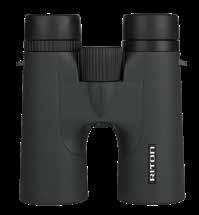
Riton says its HD/ED glass delivers 99½ percent light transmission and an enhanced color spectrum. Proprietary multi-coated lenses enhance low-light gathering while exterior lens coatings are antiscratch and anti-reflective. A magnesium-alloy chassis is paired with 6061-T6 aluminum, CNC-machined one-piece tubes. They are covered in a non-slip rubber armor. They are 5.7 inches long and weigh 26.72 ounces. FOV is 180 feet. Close focus is 54 inches. They come with a strap and a carrying bag.
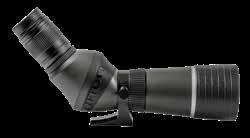
The lens system in this angled spotter includes ED glass. Like the 5 Primal binoculars, this model sports proprietary multicoated lenses, exterior lens coatings that are anti-scratch and anti-reflective and a magnesium-alloy chassis paired with 6061T6 aluminum, CNC-machined one-piece tube. It is 12½ inches long and weighs 44 ounces. FOV ranges from 110 feet to 44 feet. Close focus is 9.84 feet.

This model packs high-end features including extra-low dispersion glass, BaK-4 roof prisms, phase-corrected broad-band multi-coatings, a magnesium bridge, rubber armor and twistup eye cups. They are 6.7 inches long and weigh 26.7 ounces. FOV is 340 feet. Close focus is 6.6 feet. Eye relief is 15mm. A ¼-inch tripod socket is included. It comes with lens covers, a neck strap, nylon carrying case and shoulder harness.

This model is part of the new line of Pro Hunter Binoculars. The others are 10X42 ($69.99), 10X50 ($79.99) and 12X50 ($89.99). They all feature an aggressive and rugged new rubber design, textured grip zones, multi-coated lenses and are tripod adapter ready. Included are a carrying case, neck strap and lens covers.
the background to factor the geographic location into the identification process. AX Visio also uses Swarovision technology, which includes HD lenses and field-flattening lenses for a truer image and edge-to-edge sharpness. They are 6.9 inches long and weigh 38.4 ounces. FOV is 336 feet. Close focus is 9.8 feet. Eye relief is 17.8mm.
www.vortexoptics.com
Razor HD 13-39X56
Compact Spotting Scope, $1,299.99
Billed as the world’s first smart binoculars, this new model can identify more than 9,000 species of birds, mammals, butterflies and more with a click of a button. It also can create photos and videos. A GPS runs in

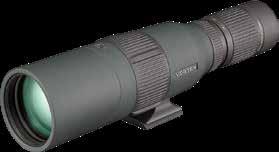
This new model is for hunters on the move with a compact design that does not sacrifice performance. It is 11.1 inches long and weighs 29½ ounces. Also introduced is an angled model (also $1,299.99) that is 10.4 inches long and weighs 28.6 ounces. The HD optical system delivers edge-to-edge clarity while the helical focus offers snagfree mounting and packing. XR Plus lens coatings improve light transmission. FOV ranges from 168 feet to 89 feet. Close focus is 9.2 feet. Eye relief ranges from 15mm to 17.8mm.


Sometimes it’s good to take stock in your surroundings. You never know what’s around the corner. The result could be somewhat mundane, or truly magical.
On April 8, many Texas state parks and state natural areas opened their gates to the public at large to witness a magical movement in the heavens. Despite heavy cloud cover over most of Texas, people gathered across a large swath of the state to see a total solar eclipse.
Due to the great distance between our planet and the sun— about 93 million miles—as well as distance and position of our moon—about 240,000 miles—it can sometimes blot out sunlight by getting between Earth and Sol, the astronomical name for the sun, and create an eerie shadow along its path across our globe. Most folks on the far west end of San Antonio managed to experience momentary nighttime shortly after 1:30 p.m. local time. Folks—and this writer—took advantage of the event by gathering at Government Canyon State Natural Area (SNA) to witness the show. Government Canyon welcomed everyone who booked the day there to be in the path of totality to enjoy the cosmic spectacle, learn about the state’s parks and natural areas, partake in an organized nature hike to the old Kallison Ranch complex, which still stands within the confines of the SNA, to witness the eclipse, and do other educational activities.
“Our hope … is to ensure visitors have a memorable, safe experience in viewing a once-in-a-lifetime event,” said Lisa Cole, park interpreter for Government Canyon. “And further foster deep meaningful connection between people and the natural world,” said Nic Maloukis, superintendent for the SNA.
Texas Parks and Wildlife Department differentiates SNAs from state parks because while state parks focus on recreation, SNAs strive to preserve and protect their particular natural resources. Government Canyon sits atop the Edwards Aquifer, is home to the endangered golden-cheeked warbler, and has dinosaur tracks.
Cole and Maloukis attend to visitor’s questions, needs, and

guidance about the SNA. They visited with many attendees as everyone assembled in the parking lot, telescopes and cameras in hand, to capture this once-in-a-lifetime event. Nature didn’t entirely cooperate, thanks to moisture and humidity from the Gulf of Mexico that made its way from the coast to envelop the area in clouds.
As the eclipse time drew near, some people lay on their backs, with eclipse glasses on, in the grass to hopefully catch a glimpse as the moon “gobbles” up the sun. Children kicked a ball around the parking lot to pass the pre-eclipse time. Others waited with cameras trained on the sky, waiting for the right moment to capture the moment for posterity. The clouds, however, proved themselves worthy adversaries and made the cameras work much harder.
Total eclipses happen every 18 months or so. Two to five solar ones happen in a year around the world, according to NASA. Ground covered by the darkest part of the moon’s shadow, the umbra, is only about 50 miles wide. In any given location, a total eclipse happens only once every 100 years or so, though for selected locations they can occur as little as a few years apart. The last time the San Antonio area experienced a total eclipse was in 1397, according to a report on KSAT-TV.
Maloukis said a few people traveled from Banjarangkan, Indonesia at 9,807 miles away and Bloemfontein, South Africa at 9,132 miles away, just to witness the eclipse from the SNA. He also said not counting staff and volunteers, the SNA recorded 673 people on site for the event.
The sky grew noticeably darker, while the air became a bit more cooler. Eclipse viewers began to shout with excitement, while others quickly shushed them, as if attending a church service. The crowd fell quiet as darkness overtook the previous gray light filtering through the clouds. Crickets began chirping and some birds flew away, being fooled into thinking nighttime arrived. The crowd’s silence gave way to collective “oohs” and “aahs” as

the moon’s shadow disappeared as quickly as it came. Everyone stood in reverence and awe.
Maloukis found a special moment in that darkness. “I can honestly say that I was surprised how dark it became and the rate at which the darkness set in,” he said. “It was an odd feeling to go from daylight to twilight to dark in such a short time.” Cole agreed. “Such an interesting and eerie feeling,” she said.
Maloukis did his best to express his eclipse perspective: “It’s hard to put it into words, but the ones that come to mind are honored and privileged. Being able to facilitate an experience like this for the Natural Area visitors is one of my favorite things about the job.” Cole added, “I loved the feeling of camaraderie at both this eclipse and the annular (eclipse) in October, that feeling of being tiny beings all gathered together to watch something much larger than any of us or our concerns. The collective reactions when the eclipse briefly popped out from behind the clouds were almost as fun to watch as the actual eclipse.”
What will Maloukis and Cole remember most about the eclipse? “I’ll remember the disappointment of the weather not fully cooperating,” he said, “and, despite that, the energy of the crowd every time we saw a small glimpse of the event.” Cole added, “I loved that almost all the (SNA) staff onsite that day were drawn together near the interpretation station at the moment of totality, and watched it together.”
Cole said the SNA participated in a special NASA-funded project, Eclipse Soundscapes, which researches how living things respond to eclipses by analyzing natural sounds recorded with a device called an AudioMoth. “Our AudioMoth was in place a couple of days before, during, and a couple of days after the eclipse,” she said. “Our recorded data from the device will be part of the collection of data from all over the country that will be analyzed and interpreted by scientists.” To learn more about the audio project visit eclipsesoundscapes.org.



Texas game warden duties encompass the widest array of law enforcement of almost any agency. The general public often mistakenly believes game wardens are the “deer police,” which is most certainly true, but they’re also sworn to protect all wildlife on land, in the air, and in fresh and salt water. Wardens train and prepare for many types of incidents. Although their assigned area may not have popular rivers and lakes, wardens are often sent elsewhere to gain experience doing a variety of law enforcement activities.
A Panhandle warden may assist coastal wardens during oyster and shrimp season. Wardens also spend time on the Rio Grande helping other agencies. Response to major weather incidents deploy wardens from around the state. They not only safeguard animals, birds, and fish, but assist humans as well.
Trey Sparkman grew up in Wharton in a law enforcement family. He became a game warden 14 years ago, beginning his career in Gaines and Andrews counties in West Texas. He was reassigned to Matagorda County in 2012, but now covers Wharton County.
“I’m a member of the TPWD Search and Rescue Team,” Sparkman said. “We go all over the state as needed. Central Texas has flash floods often quick to recede, while in East Texas and flat coastal areas, high water can be a lingering problem.” Sparkman said the state’s swift water boats are used during hurricane and high rainfall events.
“I’m also involved in patrolling the bays and coast checking commercial oyster and shrimp fishermen and boats,” he said. “During extreme cold weather, we rescue stunned turtles trapped in the shallow bay waters.” With a chuckle, he added, “I’m no biologist, but turtles just don’t seem to leave the bays for warmer, deeper Gulf water in winter.”
Members of the dive team practice often to locate underwater crime items as well as assist in locating drowning victims.

Asked what the No. 1 water violation is, Sparkman had a quick answer. “Children in boats without life jackets,” he said. “We hardly ever cut any slack for that violation. All wardens wear life jackets the minute we get on a boat, and we expect others to do the same.” Remember that the next time kids want to go fishing or boating on water.
Game warden Tommy Johnson is a second-generation warden, following in his late father’s footsteps. After serving 23 years as a deputy sheriff, he became a warden currently serving Gillespie County. Patrolling the Pedernales River and Canyon Lake top his water duties.
“We’re on the water all year but it’s the warm months when people are on the water the most,” Johnson said. “Canyon Lake is one of the deadliest lakes in Texas. People don’t realize how easy it is to fall off paddle boards or inner tubes; the wind quickly takes it away, and regardless of your swimming ability you tire and drown without a life jacket.”
Johnson said it’s a state law to have a life jacket on board during all boating activities. It’s also law to have a life jacket on board a kayak, canoe, or paddle boat. “Kill switches on jet skis and boats need to be attached to the driver at all times.”
Game Warden Sarah Wennersten patrols the Panhandle counties of Castro, Deaf Smith, and Parmer. Lots of terrain without big lakes or waterways, but she assists wardens in various parts of the state on special assignments.
“Summer is typically water safety. I enjoy going to Possum Kingdom Lake to help check boaters and fishermen,” she said. “It’s a great way to constantly be learning. I’ve patrolled for mule deer hunters by plane, worked on the big boats offshore, and patrolled using ATVs along the border. And always, lots of walking. Game wardens are greatly diversified.”
While attending game warden academy training, Kathleen Stuman rode with now retired Matagorda County warden Arthur Lawrence. “We went out to check shrimp boats, something I’d only read about or seen on film,” she said. “He edged up to the back of the shrimper with its multiple tires mounted on the back as bumpers. With both boats moving he told me to jump.
I was mortified but I did it without hitting the water. Talk about a learning experience you never forget.”
Originally from San Antonio, Stuman’s career began in Jim Hogg and Duval counties. “There’s no water (lakes or rivers) so I was glad to be re-assigned to Comal County. I became a river rat—patrolled in a kayak for several years. I’m currently assigned to Bexar County but still help patrol Canyon Lake. I love working on the water.”
TPWD has many specialized teams that operate on the water. The Search and Rescue team’s missions include responding to natural and man-made disasters as well as swift water search and rescues. Members are specifically trained and cross-trained in hand and eye communication as verbal communication may not be possible due to noise or being unable to have one hand free for signaling.
Many things happen after drowning, and a body may not resurface. TPWD divers have their own tried and true methodology and techniques that work in private and public waters. The Underwater Search and Recovery Dive Team members undergo extensive training.
Sonar equipment helps identify objects before rescue teams go in the water. Working closely with a victim’s family is also part of a game warden’s job. The dive team is often called upon by local game wardens or other agencies that need divers to successfully find firearms and other items related to crimes.
The Texas Maritime Tactical Operations Group, sometimes referred to as the Texas Navy, is an elite group of highly trained game wardens that combat large-scale Gulf of Mexico illegal fishing, while assisting other wardens or local, state, and federal partners with maritime security. They may be working the Gulf, along the Rio Grande, or on bays and lakes with the US Coast Guard or other agencies. TPWD’s fleet boasts over 500 assorted crafts including 65-foot Gulf patrol vessels and dozens of high-speed safety boats with enclosed cabins for bays and open Gulf of Mexico waters.
A game warden stated in an interview that in addition to checking shrimpers, oystering and fishermen for licenses and
Two wardens rush across the water to a distress call.
limits, some wardens dread summertime on the water. The three major holiday weekends—Memorial Day, Fourth of July, and Labor Day—can easily become nightmares.
“Boating and jet skiing accidents; intoxication; drownings; heat exhaustion; the list of water incidents is lengthy,” the warden said. “We might overlook a minor violation but not on child safety.”
“Kids need to wear life vests—no question about it. It only takes a split second for the unimaginable to happen. Also, use the kill switch bracelet on jet skis and boats. If not, the watercraft may circle and hit someone (and cause) multiple injuries, even death. It’s not a pretty sight.
“We try to stress partying responsibly but it’s usually to deaf ears. To me, hunters seem to learn and respect
Several game wardens are often required to use one boat during shrimp and oyster seasons and holiday weekends.

To fish or crab, you must purchase a fishing license. Texas has many types including resident; non-resident; fresh, salt or all-water; senior; and one day all-water. Guides must possess a guide license.
Mandatory boater education is required for those born on or after Sept. 1, 1993, but is recommended for all boaters. Successful completion of a TPWDcertified Boater Education Course and possession of valid photo ID are required for any person born on or after Sept. 1, 1993, to operate a vessel powered by a motor of more than 15 horsepower or a windblown vessel over 14 feet in length.
No person may operate a personal watercraft or motorboat powered by a motor of more than 15 horsepower on public waters unless the person is at least 13 years old and has successfully completed a Boater Education Course or is supervised by another person who is at least 18 years old, can lawfully operate the motorboat, and is on board the motorboat when underway.
Visit tpwd.texas.gov/education/boater-education/ for more information.
game laws better than those participating in water activities. I’ve seen some horrific accidents, helped recover drowning victims, and too many times, it could all have been avoided (by) using common sense and being responsible.”
By the time you read this, it will still be hot with much time left to enjoy the water. Wardens remind you to use common sense, and be responsible for yourself and all those with you when you’re on the water.
Have fun, and be safe.

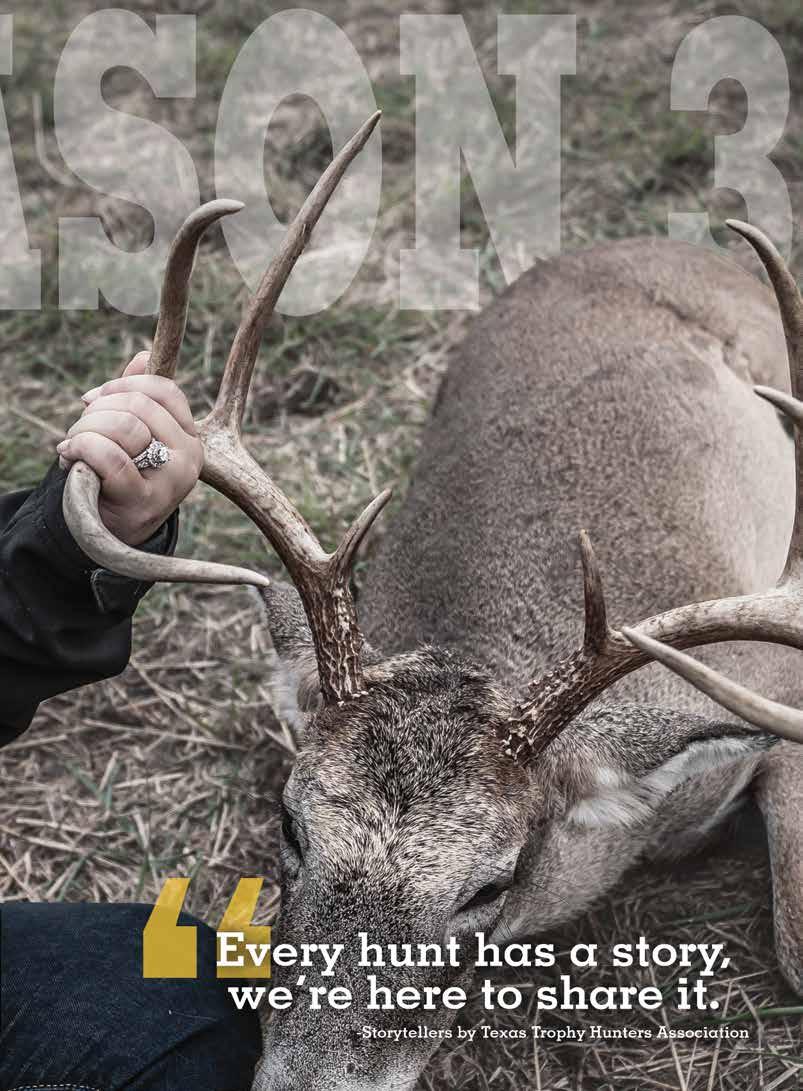
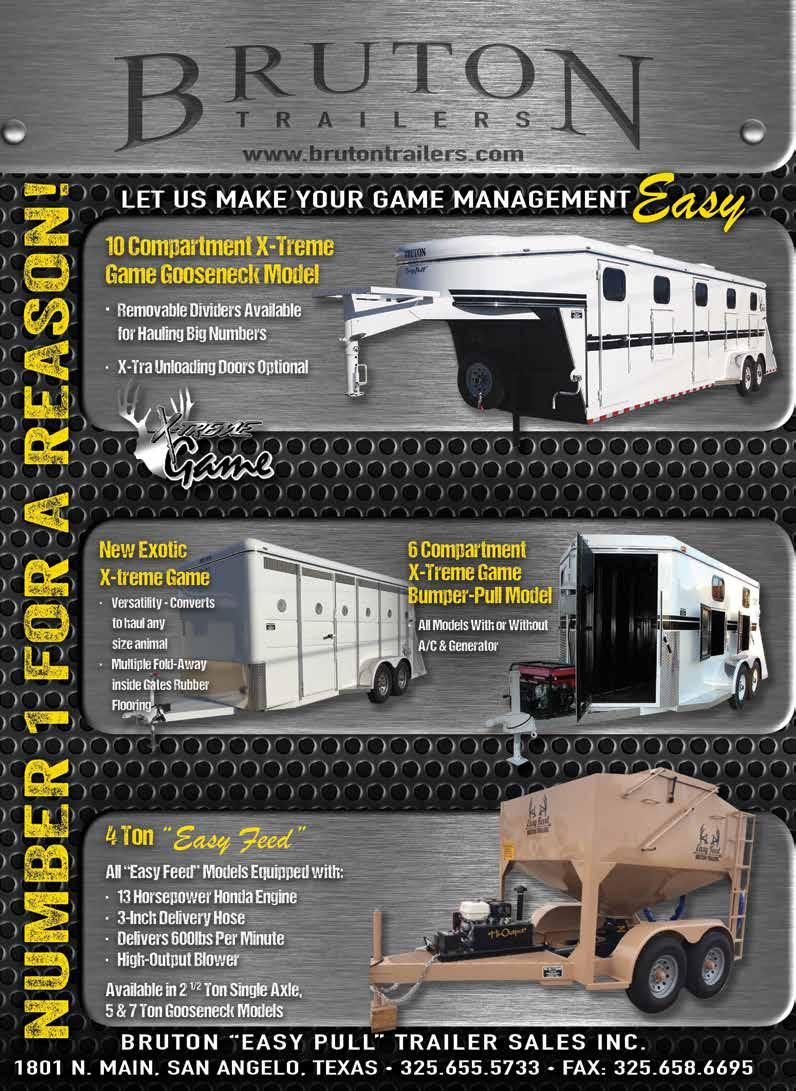


The Ruger-made Marlin 1894 rifle in .44 Magnum is fed by a tubular magazine that holds 10 rounds, more than adequate for the calling game. The 20.3-inch barrel makes the little rifle nimble.
By Gary Roberson
Author Photos
I’m not sure if it’s how a lever action rifle feels when it’s slung over my arm, or my love for the stories of the Frontier Rangers that whets my appetite to hunt with them. It could be my love of the lever gun is driven by the black and white TV series starring Chuck Connors on “The Rifleman” or perhaps, Steve McQueen starring on “Wanted Dead or Alive.” No matter the reason, to say I was excited about Ruger’s acquisition of Marlin in October of 2020 would be an understatement.
Last fall, I carried my Ruger-made Marlin 336 along with my rattling horns to the rolling hills of northwest Menard County. After going to the range, I knew I would have no problem killing a buck out to 70 yards and most bucks that respond are well within that distance. On the second morning and after rattling over 40 bucks within shooting range, I killed a mature eight-point buck. That was my goal. The Hornady 140-grain MonoFlex LEVERevolution bullet found its mark behind the left front shoulder, exiting on the opposite side.
Shortly after this great and enjoyable hunt, I received one of the Ruger-made Marlin 1894 rifles in .44 Magnum and began planning a hunt with this beautiful rifle. I wanted the challenge of trying to call a coyote and killing it with the little lever gun. In this day and time when so many shooters are trying to find a way to kill a critter at 1,000 yards, I’m trying to get it done in less than 75 yards. I knew I would have to attempt this hunt in tighter cover as I was not comfortable shooting past approximately 60 steps. Employing the FREQ, the only remotecontrolled ultrasonic game caller, would be to my advantage.
The Marlin 1894 is fed by a tubular magazine that will hold 10 rounds which should be more than adequate for the calling game. The 20.3-inch barrel with a 1:20 twist makes the little rifle quick and nimble. The laser cut checkering on the dark walnut stock gives the rifle the eye appeal that one expects to see on an iconic lever gun.
I planned a hunt with my good friend, Mike Connor, at Big Spring. While the cover is not as tight as it is in South Texas, I believe the cover and terrain would improve my chances to get a coyote within my shooting range.
The first call of the morning was a poor set up. The wind changed, blowing our scent towards the cover we planned to call. The clouds parted so we were blinded by the rising sun. The second stand was much improved and two minutes into our sit, I saw a coyote trotting through the brush to Mike’s left.
Thank goodness the wind blew from left to right. Because the coyote was on Mike’s side, I thought it was his shot to take.
This coyote is older than Methuselah. Gary said killing a coyote standing broadside at 40 yards might be considered a good shot for his 70-year-old eyes, but killing one at 40 steps on the run was a completely different accomplishment.
But as the coyote trotted out in front of us, going towards the electronic caller, he was moving into my shooting lane. The coyote stopped about five steps from the caller, but as luck would have it, he stopped behind a prickly pear with only its head visible to me.
The third stand was almost perfect. We would sit on the side of a low hill with the sun over our shoulders with a steady breeze from right to left. There was a stretch of open ground for about 40 yards before it melted into scattered brush. Hopefully, we would pick up movement in the brush before the coyotes hit the open ground. They would be well within my range when they hit the opening.
On the second series, I saw a coyote running straight towards the caller and me. As I shifted my rifle to the left for the shot, he ran past the caller and continued straight at me. I barked at him in an attempt to get him to stop, presenting a standing shot.
This coyote didn’t know the rules. When I barked at him, he locked on me and gained speed. Fortunately, I had adjusted and was ready to take the shot, when presented, but a shot at a coyote running at me is not one I want to take. Finally, at about a dozen steps, the coyote smelled a rat, whirled to his right and went into a rapid retreat. I got on him and took the running shot at 40 yards, cartwheeling the coyote.
My son Steve had been giving me a hard time about hunting with a .44 Mag. lever gun with iron sights, so to say I was proud and relieved would be an understatement. Killing a coyote standing broadside at 40 yards might be considered a good shot for my 70-year-old eyes, but killing one at 40 steps on the run was a completely different accomplishment.
The wind blew harder that afternoon and kept us down. Finally, the wind began to die down about sundown when Mike was able to kill a young coyote that tried sneaking to the electronic caller for over five minutes. Forecast was for the winds to blow again the next day. It appeared we would have time for a couple of stands before the winds would be back over 25 mph.
On the second series of the first stand, a coyote rolled off an

Gary and his friend Mike Connor, left, hunted for coyotes around Big Spring, where the cover is not as tight as it is in South Texas. Gary was nonetheless able to get a coyote within his lever-action .44’s shooting range.

open slope and down into the old gravel pit where we set up. The sun rose behind us, and the breeze blew from right to left. There were scattered scrub mesquites in the floor of the pit, and as luck would have it, the big male stopped behind one, locking onto the caller. I had leveled the Model 94 on the coyote and was ready to take the shot, debating on shooting through the thin branches.
Then I got to thinking. I was shooting a .44 Mag., loaded with 200-grain Hornady XTP ammo. It should shoot through that light cover, especially since the coyote stood right behind it. I squeezed the trigger and down went the coyote. I went two for two on my first hunt with the lever gun.
I grew up hunting with a lever gun, so perhaps it’s fitting I go out hunting with one.
Since this hunt, the great folks at Ruger shipped me a Marlin Model 1894 in .357 Magnum. I believe this caliber is better suited to the coyote and bobcat calling game. I plan to carry it on an upcoming hunt to South Texas. Stay tuned.



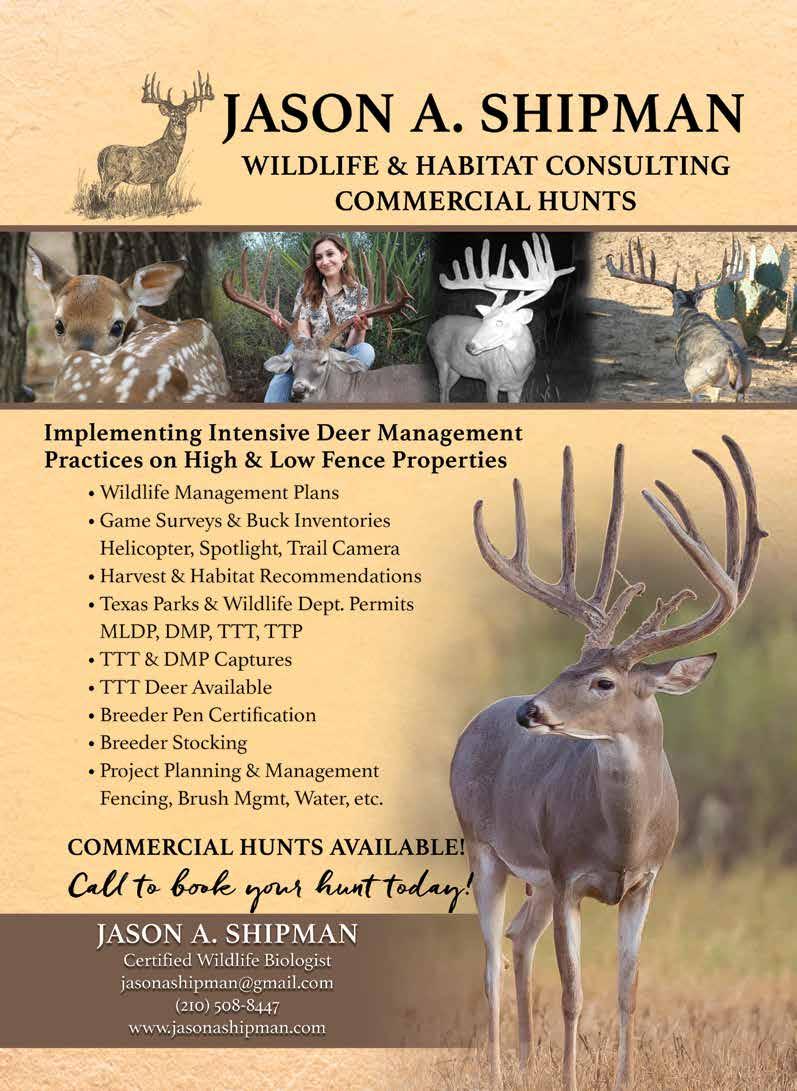




The hulk-sized ram appeared solo coming from the north. By the time I spotted him through the ground blind’s side window, the 300-pound aoudad was less than 40 yards away. He came at a slow walk, chaps swaying back and forth and his big, crescent-shaped horns sky-lined over the oak brush. The October wind blew in our favor and the ram, unaware of danger, lurked so close.
I jabbed a finger at Mike Davis’ side. “Right here, to the right, shooter for sure!” I half shouted; half whispered. Mike was on the last afternoon of his hunt. Mike had lots of bowhunting experience, but he badly wanted his first aoudad ram to take back home to California. Two hours of daylight remained.
Mike Davis with his trophy aoudad. Mike’s ram had horns just shy of 32 inches long.
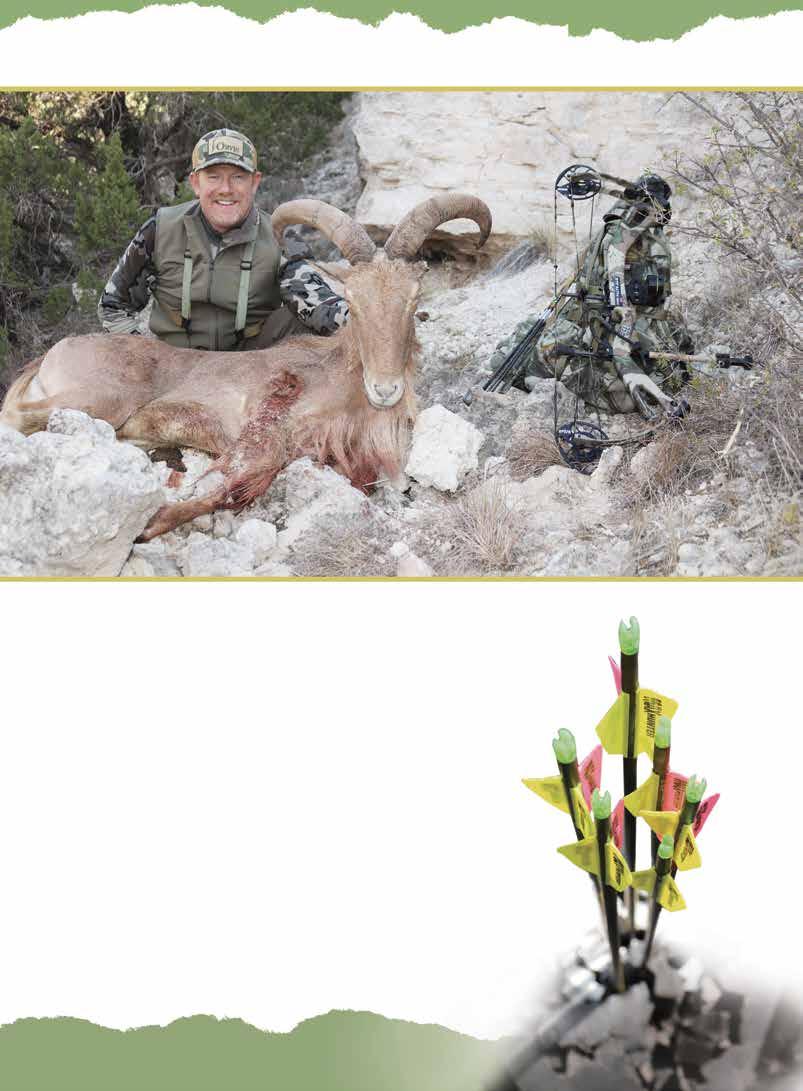
Brandon shot this mature aoudad ewe in October 2020 in the Texas Panhandle. Gear included a PSE Carbon Air Stealth Mach-1 bow, Victory VAP arrow, and a Slick Trick broadhead.
The ram stood 14 yards away, his head down, and calm. Mike’s BowTech bow came to full draw, a moment of hesitation, then the heavy 520-grain Easton FMJ arrow slammed into the ram’s side. The ram trotted away, but we could tell the hit was lethal. Less than 60 yards later we found the ram dead as a stone.
With both horns close to 32 inches long, Mike’s first aoudad was a stud! Mike’s longtime hunting buddy, Alan Harris, was there to celebrate at sunset. It was a dramatic ending to a fun week where Mike and Alan arrowed bragging-sized rams.
Introduced to the rugged canyon lands of the Texas Panhandle in 1957-58, aoudad adapted quickly to the rocky, desert terrain. The population expanded and interest in hunting these unique animals increased. Today, they’re as much a part of the landscape as prickly pear cactus and roadrunners. There’s no season or bag limit on aoudad in Texas and landowners decide the management of these hardy exotics.
In addition to taking a few old rams each year on our ranch, our management strategy includes shooting some mature ewes that do not have a lamb. When you see a herd of 40 aoudad and every animal is a ewe, you understand the need to remove some older females from the population. The oldest ewe we have ever taken had age rings to indicate she was 15 years old. Both horns were 22-inches long. While aoudad can be hunted year-round, if you’re looking for a big ram the best time to hunt is during the peak of the rut, mid-September until late October.
Spot-and-stalk is a tough assignment. Most of the time a big ram keeps company with six to 30 other animals. Combine all those eyes, ears and noses with steep, noisy terrain and you start to understand how difficult it can be to close within bow range.
Another option is hunting from ground blinds. I’ve had good success baiting cliff edges and remote mesas with corn. Aoudad

pay little attention to a pop-up blind blended with cedars or rocks. Put out feed often, hunt only when the wind is right, and patience gets rewarded with a top pin shot at a big ram. Aoudad rams are nomadic by nature, so it takes a lot of feed to keep them coming back to a specific location.
Aoudad are tough. Old rams can weigh 300-350 pounds, live weight, with a thick hide and a barrel-shaped chest. Their vitals sit slightly more forward compared to a deer, so I prefer a slight quartering away angle or broadside shot. I recommend shooting proven fixed-blade broadheads and arrows weighing at least 400 grains, but 450-550-grain arrows are better.
Extra weight on the front, increasing FOC (front-of-center) will aid with penetration. I prefer a micro diameter, 4mm shaft with a steel or titanium insert and a 100- or 125-grain broadhead. A few proven broadhead designs I’ve personally used include the Slick Trick Standard, Slick Trick Revival, Wasp Dart, G5 Montec, G5 Striker V2, Magnus Black Hornet and multiple designs from Iron Will.
The work starts in early August. Blinds are set, feed is hauled often, and scouting begins. Trail cameras are monitored weekly and spotting scopes and binoculars are employed in the afternoons to dissect canyon rims. By early September, rams that were loners the rest of the year start to mingle with the ewes. A mature ram might move 5-10 miles in the rut in search of a female in heat, so new rams can show up at any time.
Last year, Chase Steggall traveled all the way from Iowa to hunt aoudad. It didn’t take long for things to get exciting. On the first morning
Chase Steggall and Brandon with a first-day ram. Chase used a Mathews bow and Easton Axis 5mm shaft tipped with a 100-grain Magnus Black Hornet broadhead, 530 grains total arrow weight, to make a great shot on his 30-inch aoudad.
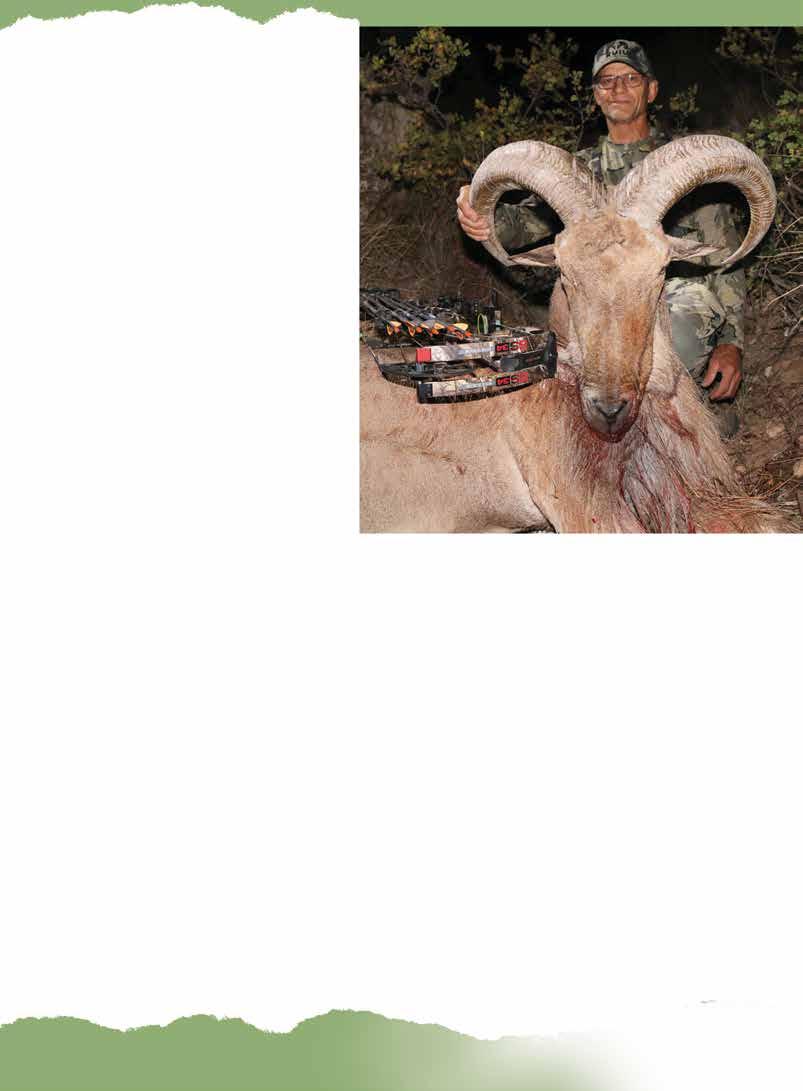
of Chase’s hunt, with the rising sun barely over the eastern horizon, banana-shaped horns came bobbing over the nearby ridgeline.
A dozen ewes came first, their eyes probing every yucca and cedar for coyotes or bobcats, or whatever aoudad think about. Finally, the lead ewe relaxed, and the herd came in single file. The last in line was a ram with heavy horns and long, flowing yellow chaps. I nudged Chase to get ready.
When the big ram cleared the others, Chase drew his Mathews bow and settled the pin at less than 15 steps. His 530-grain Easton Axis arrow tipped with a Magnus Black Hornet broadhead whistled through the ram’s ribs and beyond: a perfect shot. The herd scattered like a busted covey of quail. The hard-hit ram went down just 40 yards later.
They grow big whitetails in Iowa, but they don’t have wild aoudads roaming those Midwestern corn fields. Chase was pleased with a heavy set of 30-inch horns to tote back to his farm. It made all the prehunt preparation time well spent.
Alan Harris with a trophy aoudad ram shot at 20 yards from a pop-up blind in October 2023. Gear included a BowTech bow, Gold Tip arrow, and G5 Striker V2 broadhead. Total arrow weight: 508 grains.
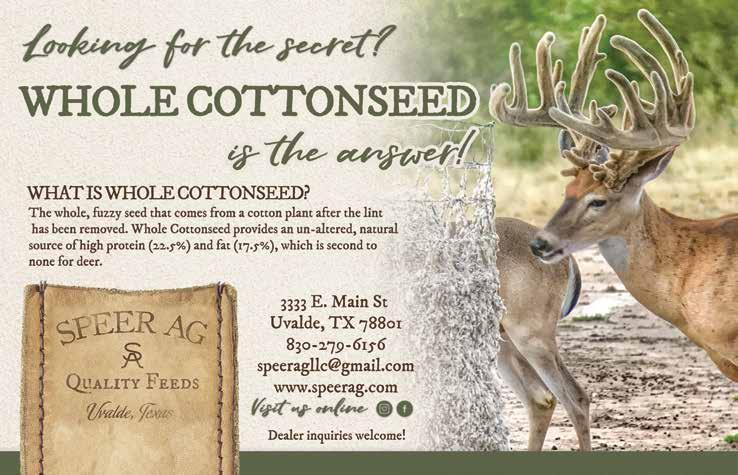


By Jake Legg

Texas has a lot of young whitetail hunters who might be interested in expanding their trophy list to include other big game. The varied habitats from El Paso to Beaumont—from Dalhart to Brownsville—are home to both native and exotic animals that will satisfy the most selective connoisseurs of big game hunting. I will dwell on some good animals to include in your bucket list.
The unique American pronghorn antelope thrives in areas of the Texas Panhandle, as well as the dry, arid counties west of San Angelo. Unless you are good at stalking, which can easily be done, expect to shoot at distances up
to 300 yards, depending on the terrain and how much the animals have been hunted. A buck pronghorn weighs a little over 100 pounds, so any flat-shooting deer rifle sighted properly will do fine.
The smart hunters will sight their rifle 3 inches high at 100 yards, which makes the point-blank range of most deer rifles close to 300 yards. This means that you put the crosshairs on the pronghorn and pull the trigger from 50 to 300 yards— no hold over! Also, remember that a pronghorn buck is small, and you may think he’s farther than he really is, so judge the distance with your naked eye.
The weather is usually warm, so take care of your pronghorn in a hurry, and don’t leave it long in the sun because its eyelashes and nose pads will go bad.

West Texas and the Panhandle offer some good mule deer hunting. Much of the hunting is glassing to find a buck, and then stalking to shooting range. Mule deer are dumb compared to whitetails, and are easy to kill once you find them.
The Texas mule deer weighs up to 200 pounds or more, but they are thinskinned and will fall to any good deer rifle from .24 to .30 caliber. Bullets that open quickly on impact are the best, but don’t go mule deer hunting with varmint bullets.
Mule deer shots will vary, based on terrain, but you will probably get more long shots than short. So, be ready for any shot, and have your rifle sighted in about 3 inches high at 100 yards so you can simply put the crosshairs on a buck from 50 yards up to 300 yards and squeeze the trigger.
The exotic aoudad—a native of North Africa—is a prize trophy with sweeping horns and a goat-like appearance. And don’t call him an “aoudad sheep.” He’s no more a sheep than a Big Bend jackass is a racehorse. DNA has shown the aoudad as being a species of its own—not a goat or a sheep. Good trophies will have 30-inch horns, and are tough critters.
Wherever you chase this bizarre trophy, the aoudad will give you a challenge, and maybe a long shot. I have killed aoudad with a .270 and .257 Weatherby, and suggest you take a rifle and ammo that can down a tough, 300-pound animal.
Select parts of the aoudad make for good table fare. Even if the ram is old, take the backstraps, shoulders and hindquarters for tasty morsels and hamburger.
The exotic axis buck from India has everything in a trophy: long-beamed antlers, a beautiful spotted cape, and outstanding venison. The spotted deer roams the Hill Country and other high-fenced ranches, and is a prized trophy. Meat hunters say the axis is the best deer meat in Texas.
Axis can be hunted the same way as whitetails, but don’t expect them to frequent the corn feeders. Axis deer tend to stay in certain areas in small groups, and hunters usually locate a good buck and stalk to within shooting range with any good deer rifle.
If you get serious for a special hunt, go after the nilgai antelope. Originally stocked on the King Ranch, the big antelope has spread across much of South Texas. Most hunts are guided, and a lot of help is needed for a “blue bull” or even a cow. The meat is delicious.
Most nilgai hunting is safari style, by slowly driving and glassing, then stalking for a shot. Some ranches have waterholes for blind hunting. Nilgai can be very wild, depending on how much they’re chased by vehicles, and long shots are common. Leave the .243 and 6.5 Creedmoor at home. The lightest caliber I would recommend for hefty hunters is a .30-06 or .300 Magnum with 180-grain Nosler bullets in a 24-inch barrel. However, lady hunters have been successful with milder recoiling rifles such as the 7mm Mauser or 7mm-08 with heavier 160-175 grain Nosler bullets. Sight-in 3 inches high at 100 yards, and put the crosshairs on the shoulder (lungs).

WILL NEED:
• 5-lb. fresh wild pig ham
• ¼ cup coarse black pepper
• 2 tblsp. chili pepper
• 1 tsp. cayenne pepper
• 1 tblsp. cumin
• 2 tblsp. salt
• Olive or vegetable oil
• Favorite BBQ Sauce

Do you have a favorite Wild Game recipe that you would like to share with our readers? If so, please type or print recipe and send to:
Mix five seasoning ingredients in a bowl. Seasoning is enough for a 5-pound pork roast or ham. Three to four hours before cooking or overnight, coat fresh ham with oil and rub with all the seasoning. Place on fire pit several inches above coals. Cook slowly for 4-5 hours, or until done. Turn meat at half-time. Internal ham temperature should be 170 degrees when done.
Garnish meat with a favorite BBQ sauce, and serve with green beans, bacon, mashed potatoes, fruit salad, and a spoon of tart jelly or jam. Serves 8-12.
Shortcut for shallow pit: Cook as above for 2-3 hours on pit, turning at half-time. Remove from pit, wrap in foil, and place on a baking sheet in a 325-degree oven for 2-3 hours, or until done. If short on foil, make a foil tent over meat and oven cook until done.
From “Barbeque, Biscuits and Beans”
Bill Cauble & Cliff Teinert, Albany, Texas.
Fish and game move in search of food in cycles relative to the moon’s location to the Earth. The time spans listed are the prime or major period times to start each day and along each time zone meridian of longitude 75° (Eastern), 90° (Central), 105° (Mountain) and 120° (Pacific). To determine the feeding cycle time for fishing and hunting in the area you plan to fish or hunt, advance the sum of 4 minutes for each degree west and back up 4 minutes for each degree east. The next prime feeding cycle (not listed on the calendar) will be approximately 121⁄2 hours later. There are minor periods that occur between the prime or major periods. The moon’s phases are shown as New, First Quarter (FQ), Full and Last Quarter (LQ). The feeding times are not a cure-all. Weather and other environmental conditions affect wildlife feeding activity.

12:35P -5:35P 1:35P - 6:35P 2:10P - 7:10P 2:55P - 7:55P 3:40P - 8:40P 4:30P - 9:30P 4:50A - 9:50A
5:40A - 10:40A 6:30A - 11:30A 7:20A - 12:20P 8:10A - 1:10P 9:00A - 2:00P 9:50A - 2:501P 10:40A - 3:40P
11:30A - 4:30P 12:30P - 5:30P 1:30P - 6:30P 2:35P - 7:35P 3:40P - 8:40P 4:25A - 9:25A 5:30A




11:25A - 4:25P 12:10P - 5:10P 12:50P - 5:50P 1:40P - 6:40P 2:25P - 7:25P 3:10P - 8:10P 3:55P - 8:55P







MADISON McCURLEY: whitetail 12-point (first hunt) taken 11/20/2023 in Dewitt County
GEAR: 6.5 Grendel, 4-32X Wraith digital scope.
OUTFITTER: Haun Ranch.

MICHAEL LOGAN: whitetail 10-point with 201⁄8-inch inside spread, gross-scoring 153 B&C, taken 12/2/23 in Baylor County. GEAR: Red Rock Precision .300 WSM, .300 Win. short Mag. Ammo, Nightforce scope.
OUTFITTER: Dad.

MAKENZIE SMITH: whitetail eight-point (first buck) taken 12/22/23 in Duval County.
GEAR: .270
OUTFITTER: Dad.
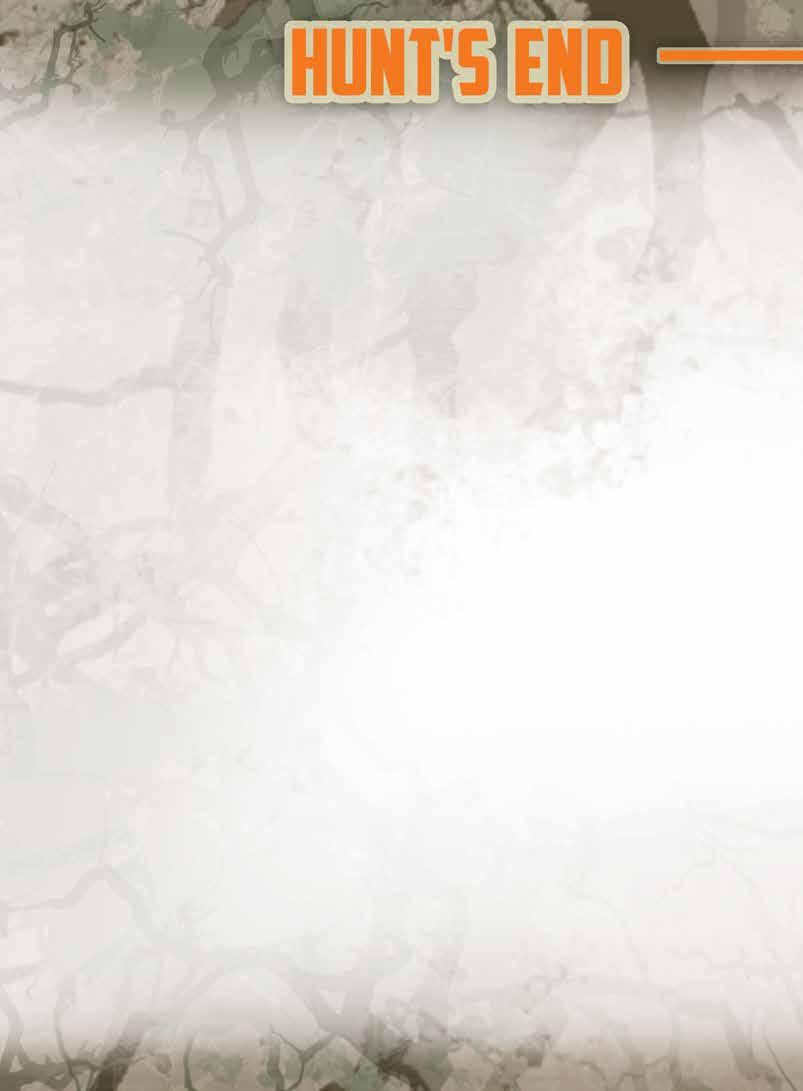

RYLEE COOKE: whitetail 12-point, scoring 1715⁄8 B&C, taken 11/4/23 in La Salle County.
GEAR: .30-06.
OUTFITTER: family ranch.
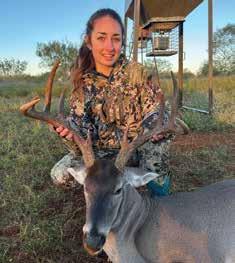



CHARLOTTE COOKE: whitetail 10-point taken 11/22/23 in Webb County.
GEAR: .270
OUTFITTER: family ranch.

FERNANDO LOPEZ CANTU: elk 10-point taken 11/25/23 in Nuevo Leon, Mexico. GEAR: 7mm Remington.
OUTFITTER: Don Quijote hunting mx (El Tigre Ranch).
KATHLEEN WENDT: whitetail 15-point with 154⁄8-inch inside spread gross scoring 1852⁄8 B&C, taken 11/18/23 in Hancock County, Indiana.
GEAR: rifle.
OUTFITTER: Lost Forty Farm.
LOUIS DUILEN: scimitar oryx taken 4/5/23.
GEAR: Hoyt carbon RX-7, Easton Axis 6.5mm, Spot Hogg triple stack sight.
OUTFITTER: London Oaks.









Don’t forget to use your free classified ad! It’s once per year and you must have an active membership in good standing. Send to:
700 E. Sonterra Blvd., Suite 1206, San Antonio, TX 78258
You may fax your ad to (210) 523-8871, Attn: Debbie Keene or e-mail to Deborah@ttha.com. Send your ad in by July 12 to run in the next issue!

Available to current members of Texas Trophy Hunters Association only! Limit 25 words per ad. Each member may run 1 FREE ad in one issue per year. 25 word ads after FREE issue are $40 each. WE RESERVE THE RIGHT TO EDIT OR REFUSE ANY AD.
RESERVE RANCH, a Sportsman’s Paradise near La Pryor, Texas offering full service hunts for Whitetail Deer, Red Stag, Dove and Quail to individuals and Corporate clients. www.reserveranch. com.
MEXICO HUNTING - Rocky Mountain bighorn sheep, mule deer, trophy whitetail, exotics and more. 1 week lodging, meals, open bar, guides, transportation, Trophy fees and permits included. huntingoutfittersmexico.com or 210-329-2959.
AOUDAD HUNT! Hunt free ranging aoudad in Llano County. Hunts begin in late August thru late October, 2024. Nice accommodations. For additional info, email darrellsteffek@gmail.com
AMERICAN FEEDER - Fish Feeders. Catch and grow larger, healthier fish. All new aluminum fish and deer feeders from American Feeder. Visit http://www. american-feeder.com for details.
TRAPPER FOR HIRE. High-fence or no fence. Predator management is crucial for fawn survival. Call Bob 317-326-4670 for details.
DuBOSE RANCH Outfitters. Trophy hunts in South Texas for 30+ years. Website – duboseranch.com. Phone – 830-3917905.
GREAT DEER HUNTING Ranch For Sale 463+/- Acs. Sallisaw, OK. New barndominium and metal shops. $2,732 per acre. Southwest Ranch Sales (972) 542-8511. www.swranchsales.com.
ALASKA HUNTING – Bear, sheep, wolf, wolverine. Best Prices! Open to trade for good year-round TX deer hunting lease. TrackoftheGrizzly.com. 907-741-7161.
HILL COUNTRY ADVENTURES offers quality trophy exotic hunts on family land. First class lodging and meals. Visit us at:
hillcountryadventuresllc.com or call: 337368-4686.
VETERANS CREED OUTDOORS Team Texas. Outdoor Trips for Veterans and First Responders. Find us on Facebook on our page and group.
VIC NIXON, REAL ESTATE BROKER for 45 years selling the Texas Hill Country. Ranches, small acreage, homes, STR’s, and other real estate in or around Fredericksburg, TX. Please call Vic Nixon 830-889-2325 or email: vic@ nixonrealestate.com.
YOUR 1ST CHOICE Deer Lease. Housing, high-fenced, blinds, feeders, protein fed. Managed for quality and quantity of deer. Hill Country. Call noon to 9:00pm 512791-8693.
28 YR. OUTFITTER in search of more land to outfit and hunt in Central TX. Looking for high fence with deer from 150-200”. We are outgrowing ourselves! Will also consider So. TX. Call Dale 325642-7596 SDWhitetails.com.
AZTEK HUNTING BLINDS - dealers welcome. In Texas, New Mexico, Oklahoma, Arkansas and Louisiana. We make to order for our clients. We offer delivery service and have inventory in Texas. comederos.com.mx or call 210329-2959.
RUSTY HINGE Ranch offers whitetail, hogs, squirrels, rabbits, coon, fox, duck hunting, fishing. Blinds, treestands, feeders & water year-round. 70 mi. north of Houston. $100/day or $800/year. 713823-7139.
HELP FEED THE HOMELESS – donate excess game animals to feed the homeless, orphans, and needy families. Go to www.trinityoaks.org “contact us” tab.
LUXURY CABINS – Built on your lot in
Hill Country area. Starting at $72,000. Visit model in Spicewood, TX. www. Selectcabin.com. Call Dave at 512-9217979.
MEXICO RANCH: 8,500+ ac Ranch available for serious & management minded Group. Excellent WhitetailDensity & Genetics, Blinds, FeedersCorn & Protein, 4 Bdr House exclusive for Hunt Group! Protein fed for last 2 years. Exc.Ranch for 4 Hunters. 210-379-7510. email: jharlan29@gmail.com.
WILDLIFE & HABITAT Consulting. Commercial hunts available. Contact Certified Wildlife Biologist Jason Shipman 210-508-8447 or jasonashipman@gmail. com.
THE LONE STAR Bowhunters Association. Preserving and Promoting bow hunting in Texas since 1974. Join today at www.lonestarbowhunter.com. Take a kid hunting.
S & D WHITETAILS – Limited hunts avail. Booking 2024 now. All native S TX deer from 140-230 class. Deer & Dove hunts Central TX. Over 7500 ac. 24-yrs experience. 5 Star rating. 325-642-7596.
TEXANS ARCHERY CLUB wants to expand our state’s archery range infrastructure. Looking for local partners/ land to expand our network. www. TexasArchery.info 501c3.
MAP MY RANCH specializes in developing printed maps for all your outdoor needs. We can create basic boundary maps, or those with customized features - locations of deer blinds, feeders, food plots, ponds, etc. Contact today to get started! www. MapMyRanch.com or 713-302-2028.
AFRICAN SAFARI $2,995 3 animals in 1 week. Lodging, meals, open bar, guide, airport transfers and trophy fees included!! Call 956-867-4964 for details. www.matorisafaris.com.





TTHA Hunters Extravaganza
Attractions 46, 47
TTHA Hunters Extravaganza
Deer Contest 48, 49
TTHA Hunters Extravaganza
Exhibitor Listing 42, 43
Briscoe-Cochina
Jason A. Shipman
Thormahlen & Cochran Safaris
TPWD Gear Up for Game Wardens 29, 142
TTHA Digital Series 118, 119
TTHA Gear 12, 13, 39, 142
TTHA Hunters Extravaganza Become An Exhibitor 3, 142
TTHA Hunters Extravaganza
TTHA Hunters Extravaganza
TTHA
TTHA
TTHA Hunters Extravaganza
Exhibitor Marketplace 38, 39, 40
TTHA Hunters Extravaganza
HX Intro 32, 33
TTHA Hunters Extravaganza Locked & Loaded 36, 37
TTHA Hunters Extravaganza Membership 44, 45
TTHA Hunters Extravaganza
Youth Deer Contest 50
TTHA Jr. Trophy Hunters 73
TTHA Membership—Military Discount 114
TTHA Membership—Platinum Life
Membership Extravaganza Special 40
TTHA Outdoors Extravaganza 5
TTHA Platinum Life Membership 101
TTHA PLM Listing 102, 103, 104, 105
TTHA Podcast 129
TTHA Write a Story 140 Umarex 40

